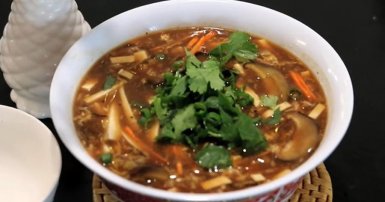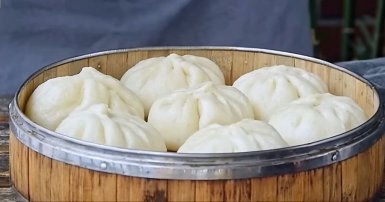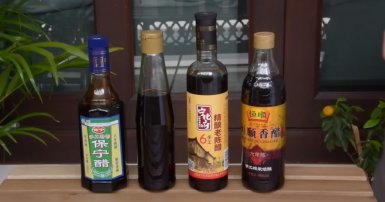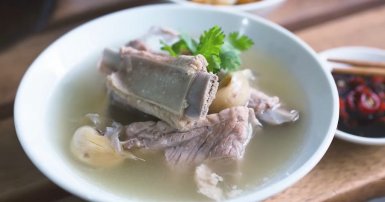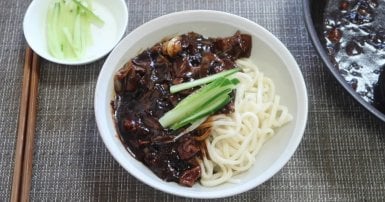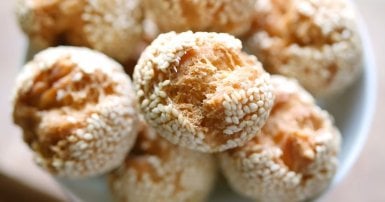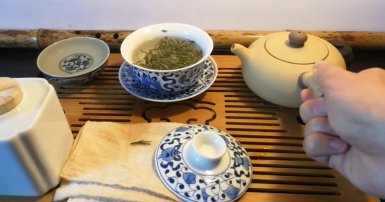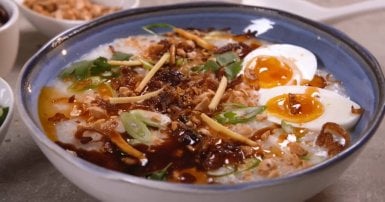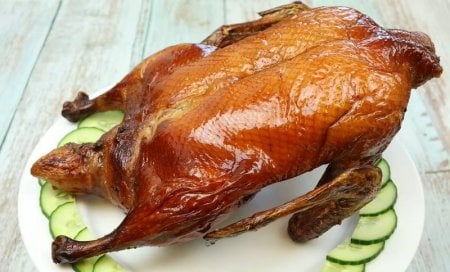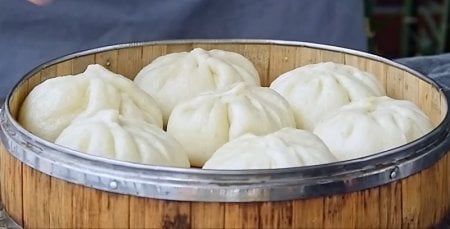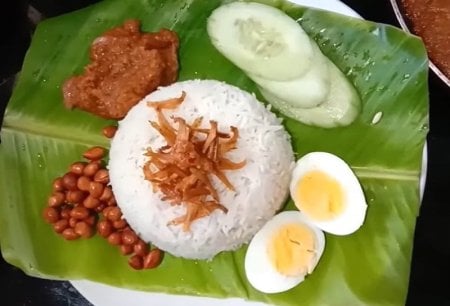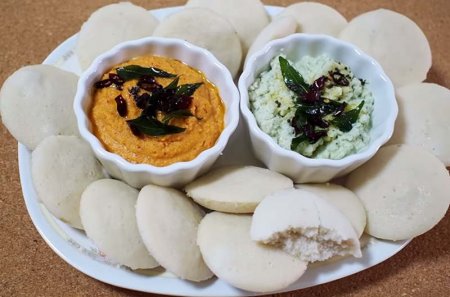Cantonese cuisine, originating from the Guangdong province of China, is a culinary masterpiece celebrated worldwide. Renowned for its delicate flavors, fresh ingredients, and meticulous preparation, Cantonese dishes offer a symphony of tastes and textures. From savory dim sum delights to succulent roast meats and steamed seafood, each dish is a testament to the region's culinary finesse. Cantonese cuisine places emphasis on preserving the natural essence of ingredients, resulting in a harmonious balance of sweet, savory, and umami flavors. Discover the artistry of Cantonese cooking, where tradition and innovation come together to create a culinary experience that delights the senses.
Dim Sum
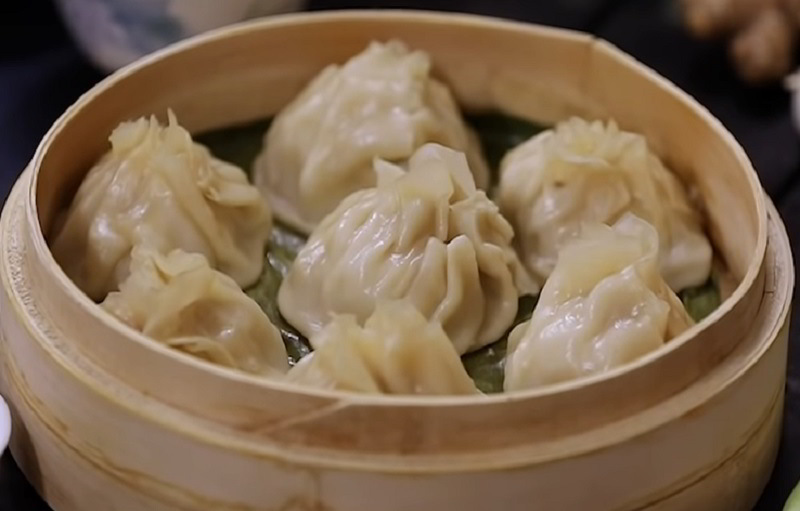
Dim sum, a diverse array of small Cantonese dishes traditionally savored during brunch in restaurants, encapsulates the rich culinary tapestry of Cantonese cuisine. Originating in Guangzhou during the nineteenth century, Cantonese dim sum initially drew inspiration from local flavors. As its evolution unfolded, chefs ingeniously incorporated influences from various Chinese regions, contributing to its expansive repertoire of flavors, textures, and cooking styles. The culture of Cantonese dim sum, characterized by regular items, seasonal delights, weekly specials, banquet delicacies, holiday treats, house signatures, travel-friendly options, and both breakfast and late-night snacks, exemplifies its culinary versatility.
Remarkably, Guangdong boasts over a thousand dim sum varieties, establishing it as an unparalleled hub for these delectable creations. Unlike other Chinese cuisines that amalgamate dim sum variations with local snacks, Cantonese dim sum has emerged as a distinct culinary entity. Estimates suggest a total of at least two thousand dim sum types throughout China, with forty to fifty varieties gaining popularity internationally. The evolution of Cantonese dim sum stands as a testament to its culinary ingenuity and cultural significance, transcending regional boundaries to captivate palates worldwide.
Hot Pot
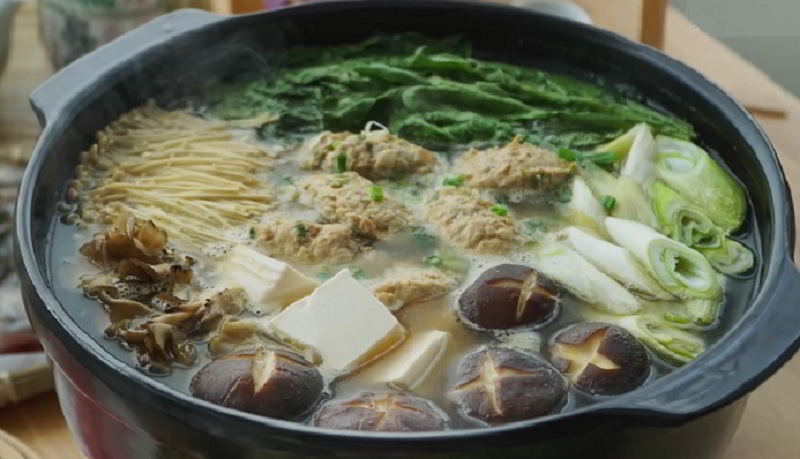
Hot pot, also known as steamboat, presents a communal dining experience where a bubbling pot of soup stock, kept simmering on a table-mounted heat source, becomes the centerpiece. This interactive culinary affair involves diners placing an array of Chinese ingredients and foodstuffs into the simmering broth at their discretion. A distinctive Cantonese twist involves blending raw egg with condiments, a practice rooted in Chinese herbalist theories. This concoction not only imparts unique flavors but is believed to mitigate the "heat" absorbed by the ingredients, potentially reducing the likelihood of post-steamboat sore throats.
The hot pot ritual is a culinary spectacle where shared enjoyment and customization converge, making it a beloved dining tradition across various Chinese communities. The dynamic interplay of flavors, coupled with the convivial atmosphere, renders hot pot not just a meal but an engaging social event. As the bubbling cauldron of broth transforms into a canvas for culinary creativity, hot pot epitomizes the art of communal dining, bringing people together around a simmering pot of shared delights.
Century Egg
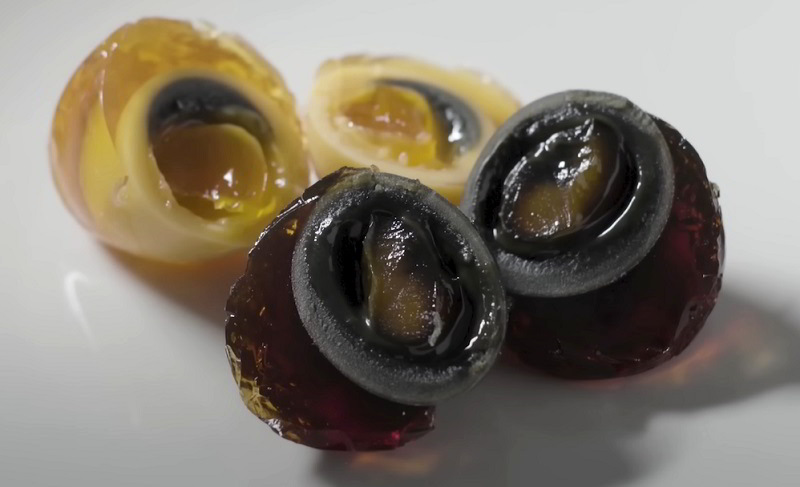
Century eggs, also recognized as Alkalized or Preserved Eggs, constitute a distinctive Chinese culinary creation crafted by preserving duck, chicken, or quail eggs in a blend of quicklime, clay, ash, salt and rice hulls for varying durations, contingent on the chosen processing method. In central China, these eggs undergo slicing and are artfully adorned with black vinegar, transforming them into a flavorful side dish.
Meanwhile, in Cantonese culinary traditions, these eggs take on the role of hors d'œuvre, with chunks intricately wrapped in pickled ginger root, a delectable combination often available as street food, sometimes served conveniently on sticks. The unique preparation process and regional variations underscore the century egg's significance in Chinese gastronomy, offering a spectrum of flavors and textures that cater to diverse palates and culinary preferences.
Chow mein

Chow mein, a Chinese culinary delight, features stir-fried noodles coupled with an array of vegetables, and optionally includes meat or tofu. Its roots trace back centuries, with diverse regional variations emerging across China. The art of frying noodles presents various techniques, offering a canvas for a multitude of toppings. Chinese immigrants introduced chow mein to different countries, establishing its popularity across the Chinese diaspora and securing a permanent spot on the menus of numerous international Chinese restaurants. Notably embraced in India, the UK, Nepal, and the US, chow mein has transcended cultural boundaries.
The Cantonese rendition of chow mein boasts deep-fried, crisp, golden egg noodles accompanied by bok choy, bamboo shoots, green peppers, pea pods, Chinese roast pork (char siu), chicken, water chestnuts, shrimp, and beef. This delectable combination is generously coated in a luscious, thick sauce. The worldwide appeal of chow mein lies in its harmonious blend of textures and flavors, making it a beloved dish that reflects the rich diversity within Chinese culinary traditions.
Pu'er tea
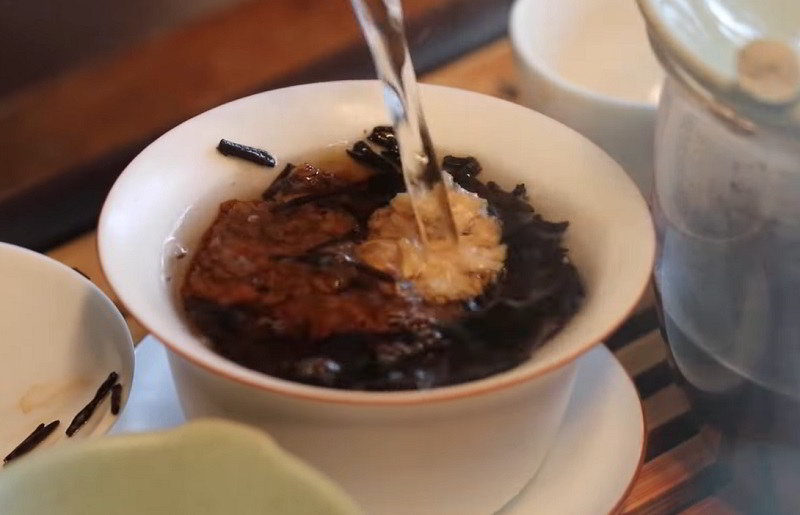
Pu'er or pu-erh stands out as a distinctive fermented tea variety, deeply rooted in the traditions of Yunnan Province, China. This tea undergoes a unique fermentation process, known as 'wet piling,' in the realm of traditional Chinese tea production. Following the thorough drying and rolling of tea leaves, microbial fermentation is carefully introduced, accompanied by controlled oxidation. This meticulous approach continues until the tea attains the desired flavors, resulting in a rich and nuanced brew.
Referred to as po-lay in Cantonese, pu'er tea is commonly enjoyed alongside dim sum meals, as it is believed to facilitate digestion. To enhance the tea's aromatic profile, it is not uncommon to incorporate dried osmanthus flowers, chrysanthemum flowers or pomelo rinds during the brewing process. This addition imparts a delicate and fresh fragrance to the tea liquor, elevating the overall sensory experience. Pu'er's intricate production and regional nuances contribute to its esteemed status in the realm of Chinese teas, offering not only a flavorful beverage but also a cultural and aromatic journey.
Xiaolongbao
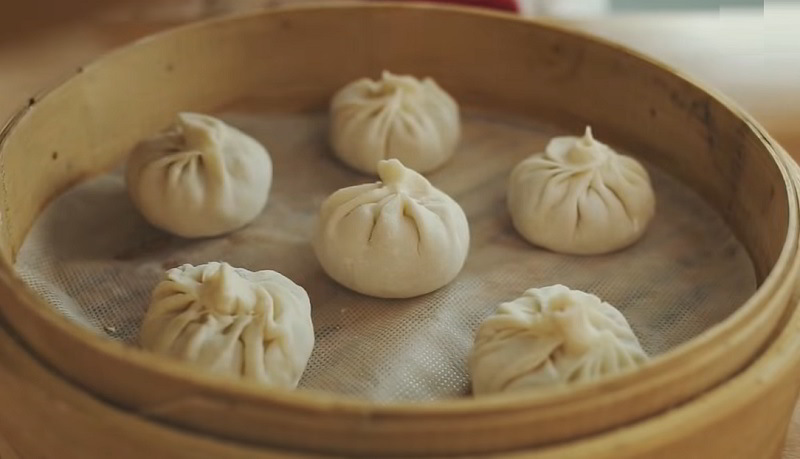
Xiaolongbao, a diminutive Chinese steamed bun, finds its culinary heritage in the small bamboo steaming basket known as xiaolong. Although commonly labeled as a type of "dumpling," it stands distinct from Chinese jiaozi or wonton. In specific regions, xiaolongbao may denote a soup dumpling variant, known as tangbao in Jiangnan cuisine, particularly associated with Shanghai and Wuxi. Shanghainese terms such as xiaolong mantou or siaulon moedeu are used, reflecting the Wu Chinese definition of "mantou," encompassing both filled and unfilled buns.
Shengjianbao, akin to tangbao but pan-fried instead of steamed, offer an alternative twist. Beyond Jiangnan, xiaolongbao makes appearances in Guangdong and the West, often featuring during Cantonese tea time. The nuanced terminology and regional variations add layers to the cultural tapestry of xiaolongbao, a delightful manifestation of Chinese culinary diversity. Whether enjoyed in the bamboo-steamed form or relished as soup dumplings, xiaolongbao captivates palates, showcasing the artistry and regional nuances within Chinese gastronomy.
Congee
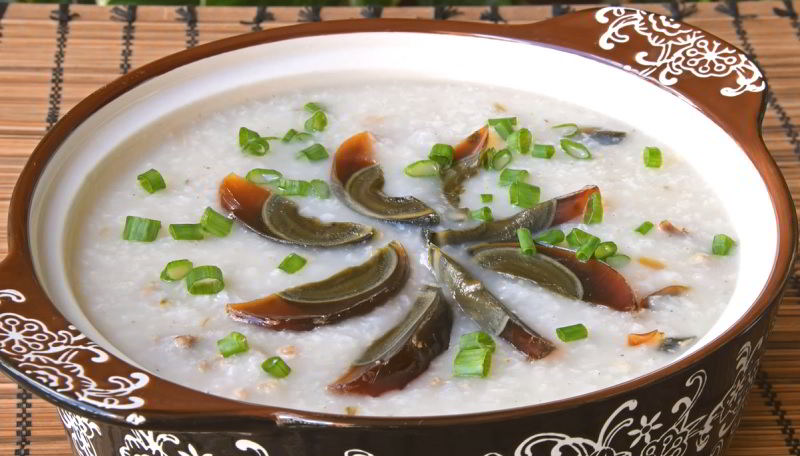
Congee, a quintessential dish in Chinese culinary tradition, stands out for its comforting and adaptable nature, earning it a revered status. Rooted in ancient China, congee has evolved into a versatile rice porridge, celebrated for its simplicity and smooth consistency. This dish involves simmering rice in an ample amount of water or broth, creating a porridge that captivates with its appeal.
Congee's charm extends to its flexibility, making it suitable for breakfast or serving as a soothing remedy for the unwell. What sets congee apart is its ability to transform through various toppings and condiments, such as pickled vegetables, century eggs, crispy shallots, and sesame oil. This adaptability mirrors the diverse regional influences across China, giving rise to distinct variations like Cantonese-style lean pork congee or the robust seafood-infused renditions found in southern regions. Congee, with its rich history and dynamic adaptations, exemplifies the artistry within Chinese cuisine, offering a comforting and delightful culinary experience.
Pastel De Nata

Pastel de nata, also known as pastel de Belém, emerges as a delectable Portuguese pastry featuring an egg custard tart, optionally adorned with a sprinkling of cinnamon. Beyond Portugal, these treats have garnered widespread popularity in Western Europe, Asia, and former Portuguese colonies like Macau, Goa, Brazil, Mozambique, and East Timor. Notably, the Macanese pastel de nata has found an unexpected home in KFC, becoming available in regions including mainland China, Taiwan, Hong Kong, and Thailand.
In Indonesia, particularly in Jakarta, this pastry experiences heightened popularity, notably in culturally Portuguese enclaves like Kampung Tugu, rooted in the Mardijker heritage. The global resonance of pastel de nata attests to its universal appeal, transcending borders and cultural boundaries. Its adoption by international chains like KFC underscores the widespread love for this Portuguese delight, showcasing its ability to captivate taste buds far beyond its place of origin. The journey of pastel de nata reflects not only its deliciousness but also its ability to become a cherished treat in diverse corners of the world.
Jiaozi
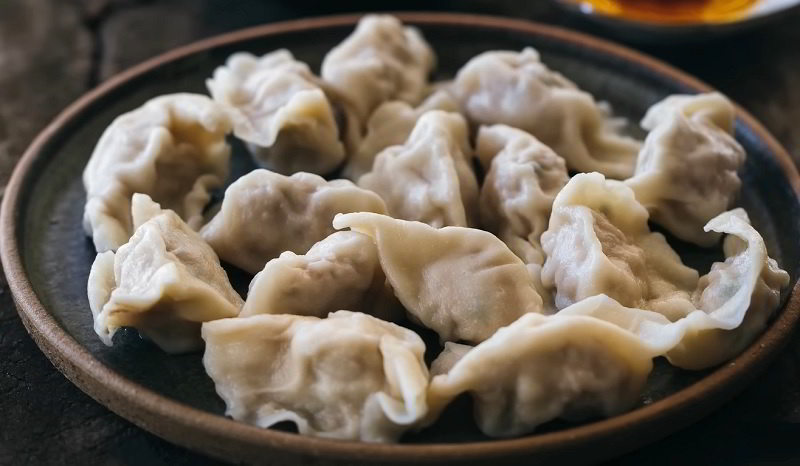
Jiaozi, a prominent Chinese dumpling, embodies a culinary tradition that spans various cooking methods and cultural celebrations. These dumplings typically feature a filling of ground meat and/or vegetables enveloped in thinly rolled dough, sealed by pressing the edges together. The versatility of jiaozi allows for pan-frying (jiān jiǎo), steaming (zhēng jiǎo), boiling (shuǐ jiǎo), or deep-frying (zhá jiǎo), each method offering a unique texture. Traditionally accompanied by a black vinegar and sesame oil dip, jiaozi can also be served in a comforting soup (tāng jiǎo).
Beyond their culinary diversity, jiaozi holds immense cultural significance, particularly during the Chinese New Year in northern China and as a year-round staple in the northern provinces. Symbolizing wealth and good fortune due to their resemblance to gold and silver ingots, these dumplings are ingrained in Chinese traditions. Jiaozi's popularity extends globally, with a fried variation known as potstickers in Western cuisine.
In Cantonese, jiaozi is referred to as gaau ji, a standard offering in dim sum. Distinguished by smaller size and thinner, translucent wrappers, Cantonese gaau ji are usually steamed. The challenging process of creating thin yet resilient wrappers makes homemade versions rare. The array of fillings, including har gow, tofu, scallop, chicken, and mixed vegetables, showcases the culinary creativity found in dim sum restaurants.
Wonton
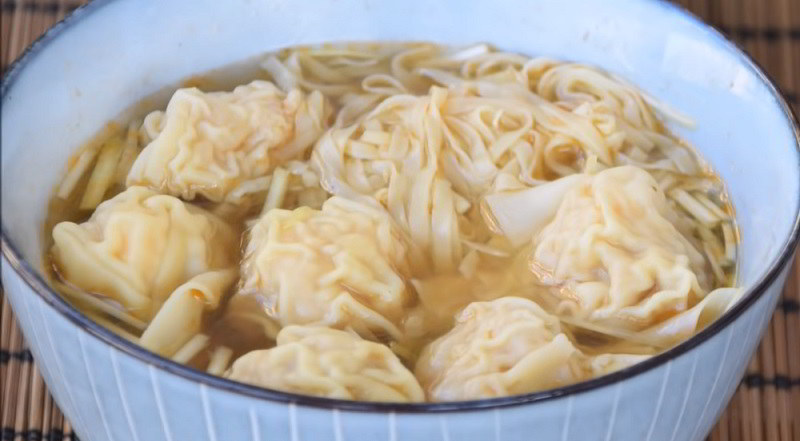
Wontons, a prevalent type of Chinese dumpling with variations across regional cuisines, are celebrated for their diverse styles. The term is transliterated as wantan in Cantonese, wuntun in Shanghainese, reflecting the linguistic richness of Chinese culinary traditions. While a myriad of wonton styles is enjoyed throughout China, Cantonese wontons have gained prominence in the West, primarily due to the prevalence of Cantonese restaurants abroad.
These dumplings, originating in China, have become a coveted delicacy appreciated not only in East Asian cuisine but also within Southeast Asian culinary traditions. Cantonese wontons often take center stage in dishes like wonton noodles, where shrimp-filled wontons and minced pork accompany thin noodles in a steaming hot soup. Consumed with red vinegar, the distinct flavor of the soup is achieved by boiling shrimp shells, pork bones, and dried flounder. The versatility of wontons extends to various sizes, with the smallest version, known as sai yung, consisting of two wontons and noodles. Wontons, with their rich history and diverse preparations, embody the culinary ingenuity that has made them a cherished delight across continents.
Shumai
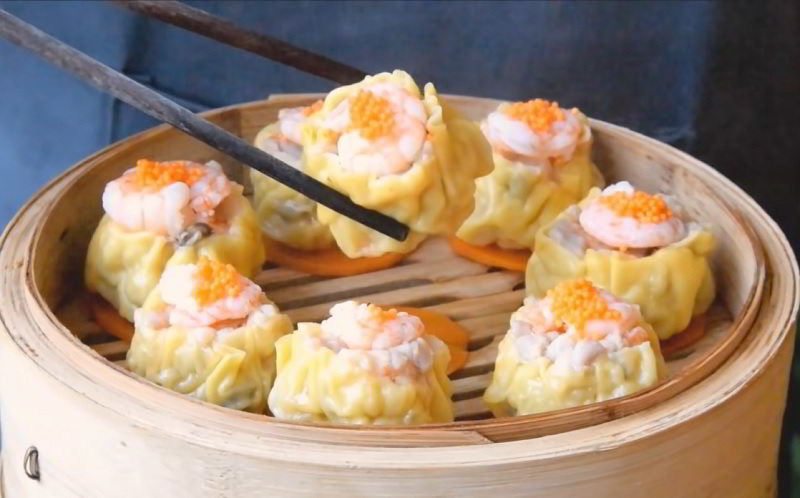
Shumai, a classic Chinese dumpling, is a revered dish, particularly cherished in Cantonese cuisine where it commonly graces dim sum tables as a delightful snack. Beyond its roots, this delectable treat has journeyed with the Chinese diaspora, leaving its flavorful mark across the globe. A notable variation of shumai has found a place in Japanese culinary traditions, and its presence extends to various Southeast Asian nations and even reaches the shores of Australia, where it is embraced as the dim sim.
In Cantonese culinary realms, shumai unfolds as a savory delight, showcasing a harmonious blend of flavors and textures. Its appeal transcends cultural boundaries, resonating with both enthusiasts of authentic Chinese cuisine and those seeking culinary adventures. The global popularity of shumai is a testament to its adaptability, as it seamlessly integrates into diverse culinary landscapes while retaining its essence as a symbol of traditional Chinese culinary craftsmanship. From dim sum tables in Cantonese teahouses to international kitchens, shumai stands as a delectable ambassador of Chinese culinary excellence, celebrated and relished across continents.
Egg Foo Young
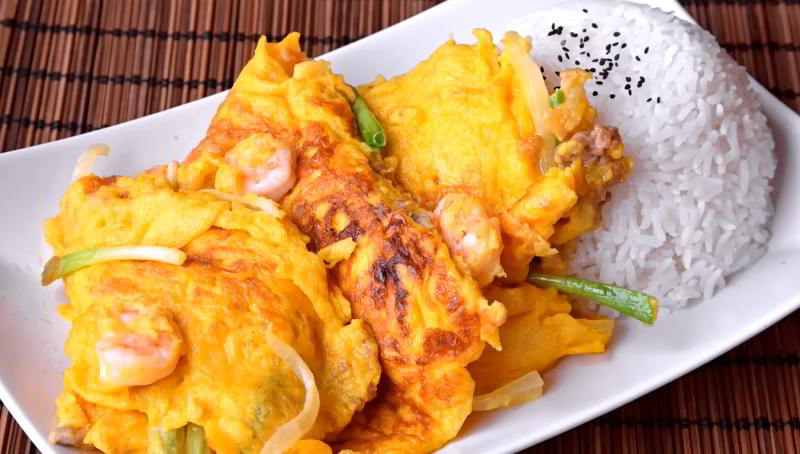
Egg foo young, a dish embraced in Chinese Indonesian, British Chinese, and Chinese American cuisine, draws its name from the Cantonese language. The term "Egg foo young" originates from the Cantonese "fu yung egg slices," rooted in a mainland Chinese recipe hailing from Guangdong. Born in the coastal province of Guangdong, historically known as Canton, this dish has evolved into a Cantonese hybrid, prevalent both in the United States and Asia.
Crafted with beaten eggs, egg foo young commonly features an array of vegetables, such as bean sprouts, bamboo shoots, cabbage, spring onions, mushrooms, and water chestnuts. For those seeking a heartier option, various proteins like roast pork, beef, shrimp, chicken, or lobster may be included. This dish mirrors the culinary fusion prevalent in Cantonese cuisine, reflecting a blend of textures and flavors that transcends geographical boundaries. Egg foo young stands as a testament to the adaptability and creativity within Chinese culinary traditions, finding its place and appreciation across diverse cultures and culinary landscapes.
Baozi
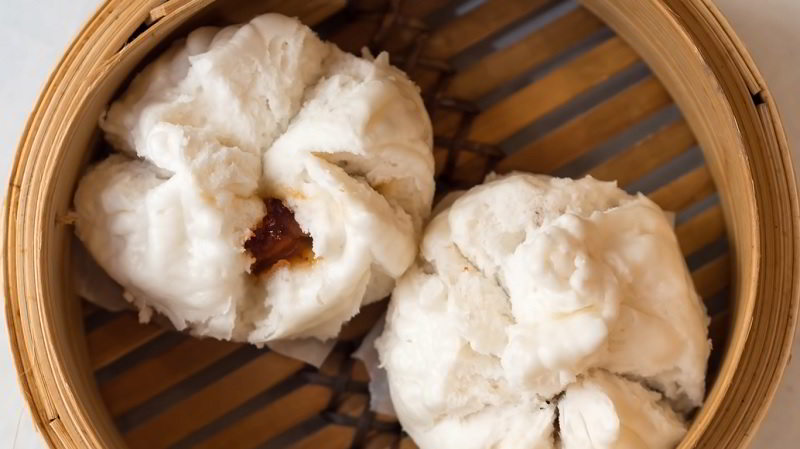
Baozi, commonly known as bao, represents a diverse category of yeast-leavened filled buns prevalent in numerous Chinese cuisines. These delectable buns come in a myriad of variations, featuring an array of fillings, ranging from succulent meats to vegetarian options, all harmoniously enclosed within the soft dough. The predominant cooking method for baozi involves steaming, preserving the delicate texture of the buns, making them a culinary delight.
Hailing from Northern China, baozi shares its roots with mantou, evolving into a distinct culinary form celebrated across the country. One notable variant is the charsiu bao, a creation emblematic of Cantonese cuisine originating in Guangdong province and Hong Kong. Filled with barbecue-flavored char siu pork, these buns showcase the artistry and expertise of Cantonese culinary traditions.
Whether brimming with savory meats or embracing a vegetarian palette, baozi embodies the culinary creativity within Chinese gastronomy. Its prevalence, adaptability, and regional variations showcase the enduring appeal of these steamed buns, solidifying their place as a cherished component of Chinese culinary heritage.
Spring Roll

Spring rolls, esteemed as rolled appetizers or dim sum, grace the tables of both Chinese and Southeast Asian cuisines, captivating taste buds with their diverse culinary expressions. The cultural nuances reflected in the kind of fillings, wrapper, cooking techniques, and nomenclature impart a unique character to these delightful rolls, offering a wide spectrum of flavors and textures.
Varied across regions, the essence of spring rolls lies in their vegetable-filled core, providing a canvas for culinary creativity. The wrapper's composition and the choice of ingredients showcase the distinctive influences of each culture, creating a rich tapestry of tastes. Chinese and Southeast Asian kitchens may craft spring rolls using differing wrappers, such as rice paper or wheat flour, while the fillings may include an assortment of vegetables.
Embodying versatility, these rolls may be deep-fried, steamed, or served fresh, each method enhancing the culinary experience. The name "spring rolls" encompasses a plethora of regional interpretations, reflecting the multicultural roots of this beloved dish. From the vibrant markets of Southeast Asia to the dim sum carts of Chinese teahouses, spring rolls stand as a testament to the culinary ingenuity and global appreciation of this cherished appetizer.
Char Kway Teow
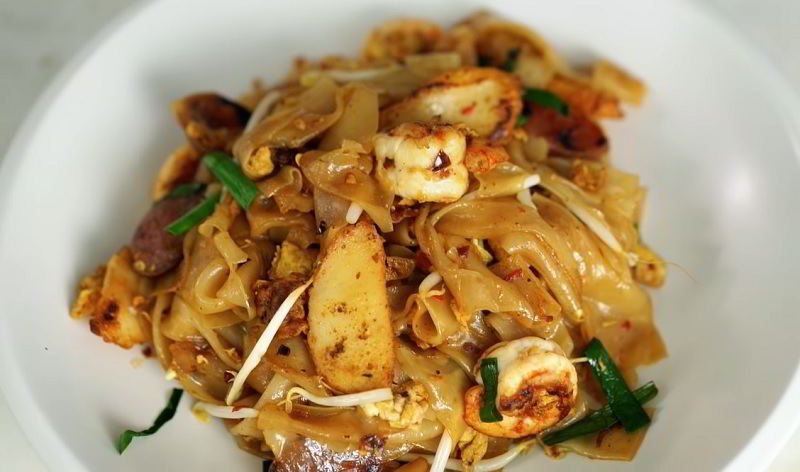
Char kway teow, a stir-fried rice noodle dish with its roots in southern Chinese cuisine, has become a culinary icon in Maritime Southeast Asia. The name, derived from Hokkien and Teochew, signifies 'stir-fried' (char) and flat rice noodles (kway teow). These noodles, approximately 1 cm wide, undergo a high-heat stir-frying process with garlic, light and chili paste, dark soy sauce, blood cockles, whole prawns, Chinese sausage, Chinese chives, bean sprouts, fishcake, and belachan.
Initially crafted for overseas-born Chinese laborers in Southeast Asia, char kway teow has gained widespread popularity, especially in Malaysia and Singapore, since the late 20th century. Notably, the dish has garnered a reputation for being indulgent, primarily due to its traditional preparation in pork fat and the addition of crisp croutons of pork lard, contributing to its rich, savory flavor. Char kway teow stands as a delectable testament to the cultural fusion and regional adaptations within Southeast Asian cuisine, capturing the palates and hearts of those who savor its bold and savory essence.
Mapo Tofu
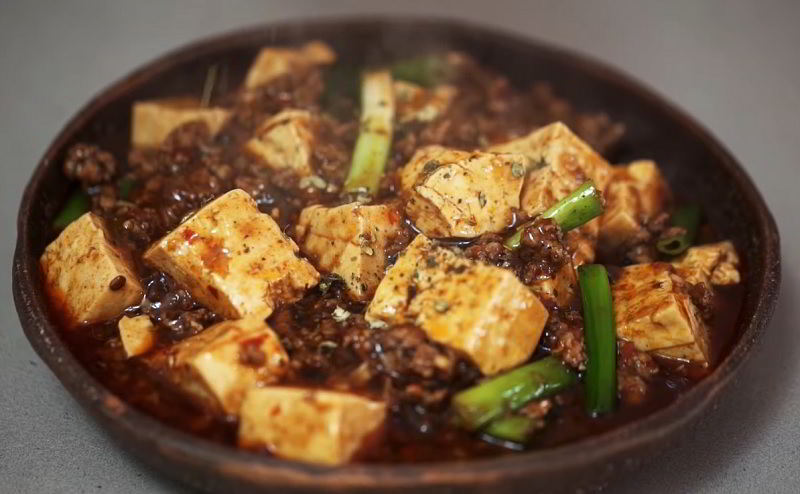
Mapo tofu, a beloved Chinese delicacy hailing from Sichuan province, encapsulates the region's culinary prowess. This dish features tofu enveloped in a spicy sauce, typically a vibrant, thin, and oily suspension with a bright red hue. The sauce derives its bold flavor from douban, a fermented broad bean and chili paste, and douchi, fermented black beans, complemented by minced meat, often beef. Variations abound, incorporating water chestnuts, onions, assorted vegetables, or wood ear fungus for added complexity.
Historical accounts offer intriguing glimpses into the origins of Mapo tofu. One source traces its existence back to 1254 in a Chengdu suburb, while others posit its inception in the 1860s, at a Chengdu restaurant. Regardless of its exact origins, Mapo tofu has transcended time, evolving into a staple of Sichuan cuisine cherished for its spicy, flavorful profile. The dish stands as a testament to the culinary artistry of Sichuan, captivating taste buds with its rich history and diverse variations that continue to tantalize palates worldwide.
Char Siu
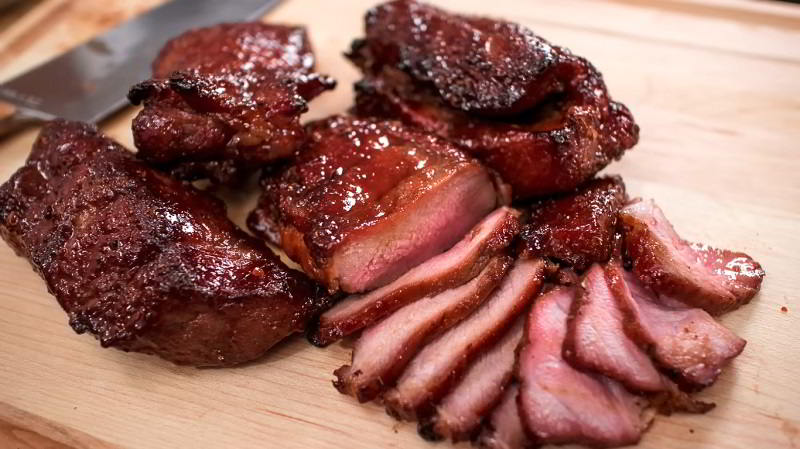
Char siu, a delectable Cantonese-style barbecued pork, traces its origins to Guangdong and has become an integral element in various culinary applications. This succulent dish, infused with the rich flavors of Cantonese cuisine, is commonly paired with rice, incorporated into noodle dishes or stir-fries, and employed as a flavorful filling for Chasiu baau or pineapple buns. The quintessential spice, five-spice powder, imparts its distinctive aroma, while a glaze of honey or other sweeteners contributes to its irresistible sweetness. Traditionally, the vibrant red color is achieved through the use of red yeast rice.
Char siu holds a distinguished status within Cantonese cuisine, categorized as a type of siu mei, referring to Cantonese roasted meats. This beloved barbecue pork has evolved from its Guangdong roots to captivate palates globally. Its versatility and delightful combination of sweet and savory notes make char siu a culinary treasure, cherished not only in its place of origin but also as a celebrated ingredient in various international dishes, showcasing the enduring appeal of Cantonese flavors.
Chicken Feet
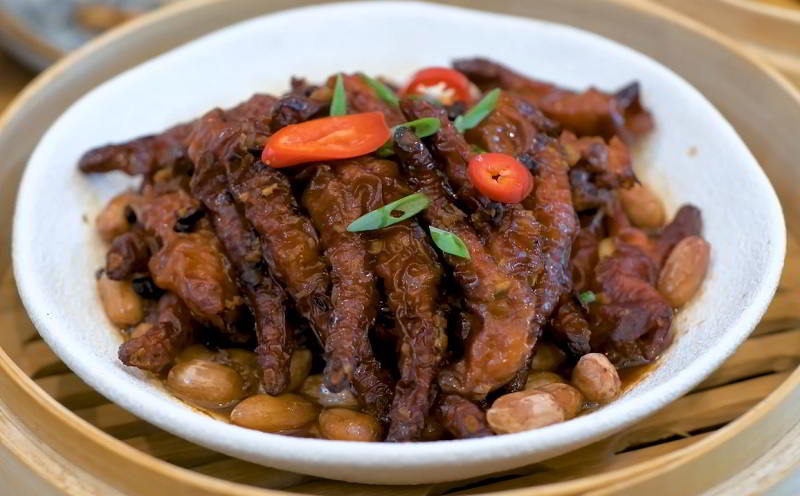
Chicken feet, a culinary delicacy savored in various countries, undergo a unique preparation process. Following the removal of an outer layer of tough skin, the edible portion mainly comprises skin and tendons, devoid of muscle, resulting in a distinctive gelatinous texture that sets it apart from other chicken meat.
In regions like Guangdong and Hong Kong, chicken feet receive an exquisite treatment. Initially deep-fried and steamed to achieve a puffiness, they are subsequently stewed and simmered in a flavorful sauce. This sauce, rich with nuances, incorporates ingredients such as black fermented beans, bean paste, and sugar, creating a delectable symphony of tastes. Alternatively, some indulge in the sublime experience of chicken feet stewed in abalone sauce, elevating the dish to a pinnacle of culinary artistry. The culinary journey of chicken feet showcases the diversity and creativity in global cuisines, where seemingly unconventional parts transform into culinary masterpieces through skillful preparation and a blend of unique flavors.
Stinky Tofu
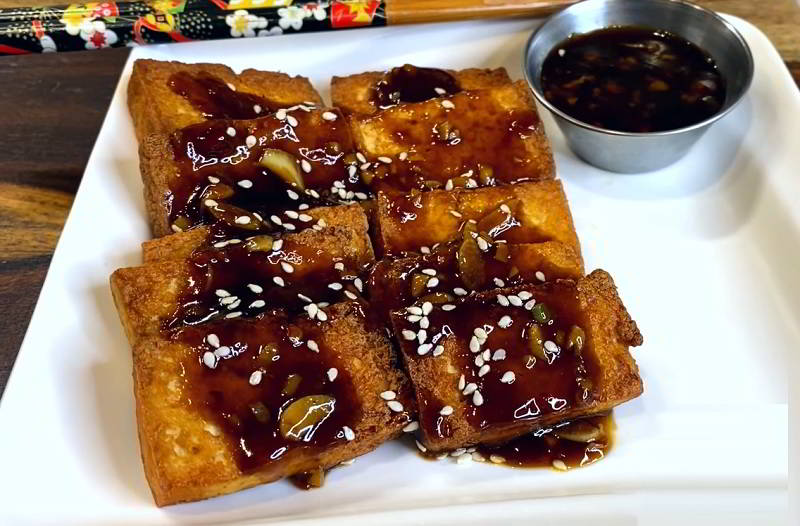
Stinky tofu, an intriguing facet of Chinese culinary exploration, stands as a form of fermented tofu celebrated for its bold and distinctive aroma. Often discovered in lively night markets and roadside stands, this distinct snack or side dish holds a more pronounced presence outside conventional restaurant settings. Traditionally, stinky tofu undergoes an extended fermentation process in a brine infused with vegetables and meat, sometimes lasting for months. However, contemporary factory production opts for a briefer marination period of one or two days to achieve the desired pungency.
Crafted in diverse manners, stinky tofu can be relished steamed, stewed, cold, or, deep-fried, offering a spectrum of textures and flavors. Accompanied by chili sauce or soy sauce, this culinary marvel showcases a variety of hues, from the golden, fried Zhejiang-style to the distinctive black tone of Hunan-style stinky tofu.
Despite the initial whiff possibly conjuring thoughts of rotten garbage or smelly feet, the varied palate of stinky tofu enthusiasts draws parallels to blue cheese or even the complexity of aged meats. A prevailing belief suggests that the more potent the aroma, the richer and more nuanced the flavor experience.
Dandan Noodles
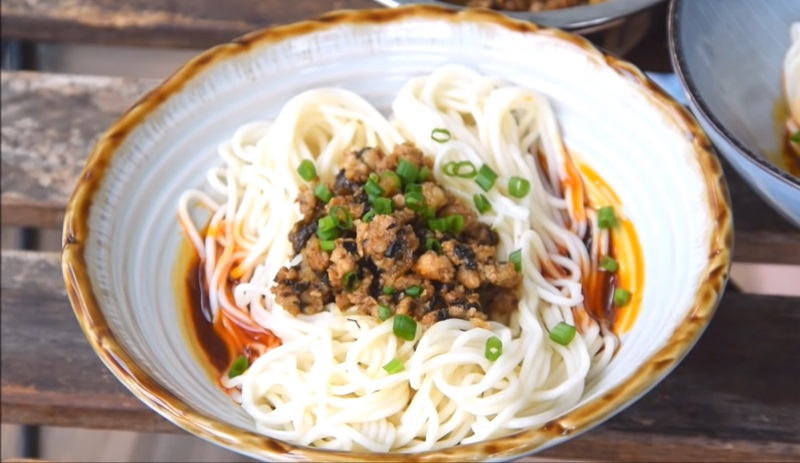
Dandan noodles, or dandanmian, emerge from the rich tapestry of Chinese Sichuan cuisine, offering a flavor-packed noodle experience. Originating in Chengdu, the capital of Sichuan province, this dish boasts a spicy sauce featuring preserved Sichuan pepper, minced pork, vegetables, chili oil, and scallions, generously draped over a bed of noodles. Whether served dry or as a noodle soup, dandanmian enchants with its diverse textures and bold flavors.
The original rendition, hailing from Chengdu, presents a dry version in a small bowl enveloped in a mala meat sauce, adorned with pickled vegetables, peanuts, and spring onions. The soup variation, more prevalent outside Sichuan, particularly in Hong Kong, diverges from the traditional dry style.
Some delightful variations include the addition of sesame paste or peanut butter, occasionally substituting the spicy sauce, a nod to the American Chinese style. In such cases, dandanmian transforms into a delightful variation of ma jiang mian, showcasing the adaptability and creativity within the realm of Chinese noodle dishes.
Yangzhou Fried Rice
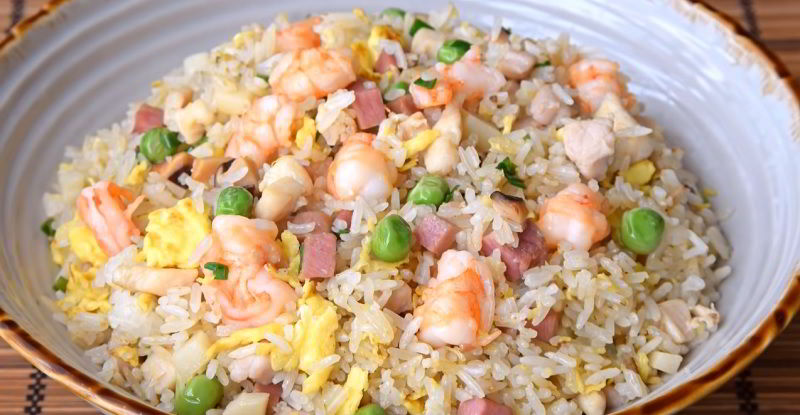
Yangzhou fried rice, a beloved Chinese wok-fried rice creation, goes by various spellings and names, captivating taste buds with its flavorful medley. This dish finds its essence in egg fried rice blended with an assortment of vegetables and two protein sources, typically featuring pork and shrimp, all intertwined with scallions. What sets Yangzhou fried rice apart from its counterparts is the inclusion of a protein symphony.
Unlike traditional fried rice where a single protein takes center stage, Yangzhou style harmonizes a variety. The quintessential blend often comprises shrimp and pork, although roasted or boiled duck and chicken also make delightful appearances. This culinary masterpiece thrives in the realm of Cantonese cuisine, enchanting palates with its diverse textures and savory richness. Yangzhou fried rice stands as a testament to the artful fusion of flavors and proteins, creating a dish that resonates not just as a Chinese culinary staple but as a celebration of gastronomic ingenuity.
Youtiao
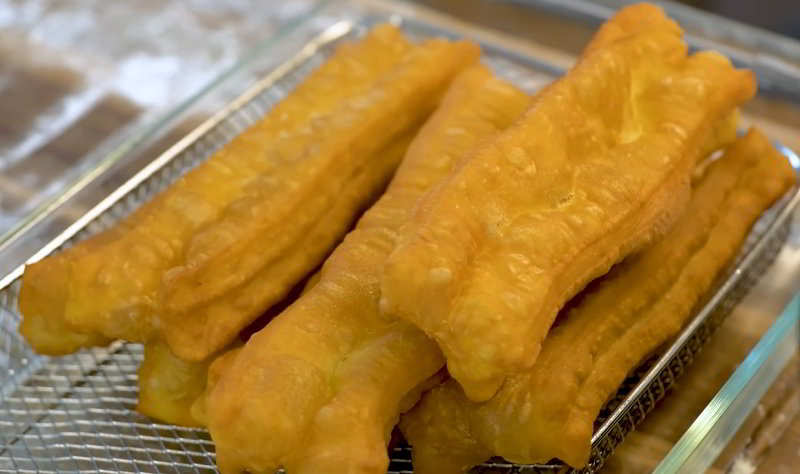
Youtiao, alternatively known as Yu Char Kway in Southern China, stands as a long, golden-brown, deep-fried strip of wheat flour dough, originating from Chinese culinary traditions. This delectable creation transcends its Chinese roots, finding popularity in various East and Southeast Asian cuisines under different names, such as Chinese cruller, Chinese oil stick, Chinese donut [sticks], or fried breadstick.
Conventionally lightly salted and tearable, youtiao has become a breakfast staple, harmonizing perfectly with rice congee, soy milk, or sweetened regular milk. The versatility of youtiao is evident in its various monikers across Asia, including bicho, you kueh, kuay, shakoy, char kway, cakwe, cakoi, or pathongko. Regardless of the name, the charm of youtiao lies in its crispy exterior and soft interior, creating a delightful texture that has captured the hearts and palates of breakfast enthusiasts across diverse cultures.
Lo Mein
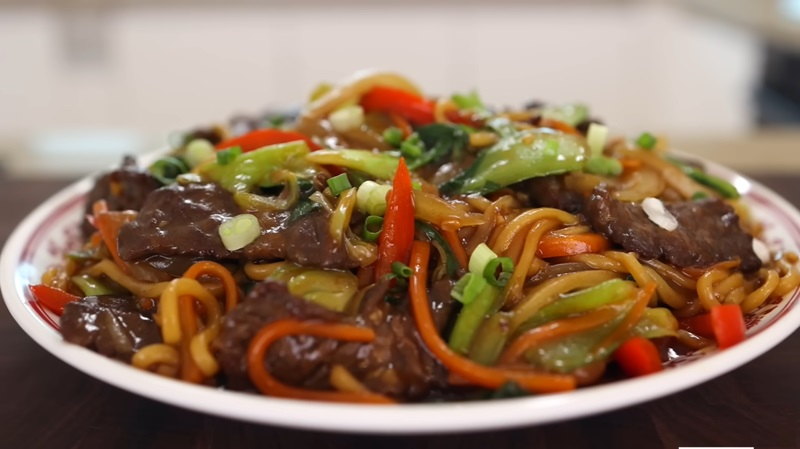
Lo Mein stands as a beloved Chinese noodle dish embraced worldwide for its delightful blend of textures and flavors. Its adaptability allows for an array of ingredient combinations, catering to diverse preferences. This culinary gem typically features stir-fried wheat flour noodles, harmoniously mixed with an assortment of vegetables, protein choices like chicken, beef, or shrimp, and a savory sauce that ties everything together. The noodles themselves boast a delightful soft and chewy texture, creating a satisfying mouthfeel.
Common vegetable additions include the vibrant crunch of carrots, the earthy broccoli, the sweet bell peppers, and the savory mushrooms. The protein, thinly sliced and cooked alongside the noodles, infuses both taste and substance, enhancing the overall dining experience. At the heart of this culinary masterpiece is the sauce, a crucial component that unites all the flavors. Comprising soy sauce, oyster sauce, sesame oil, and an array of seasonings, the sauce contributes to the dish's rich and savory profile, making Lo Mein a universally cherished and customizable delight for noodle enthusiasts worldwide.
Shark Fin Soup
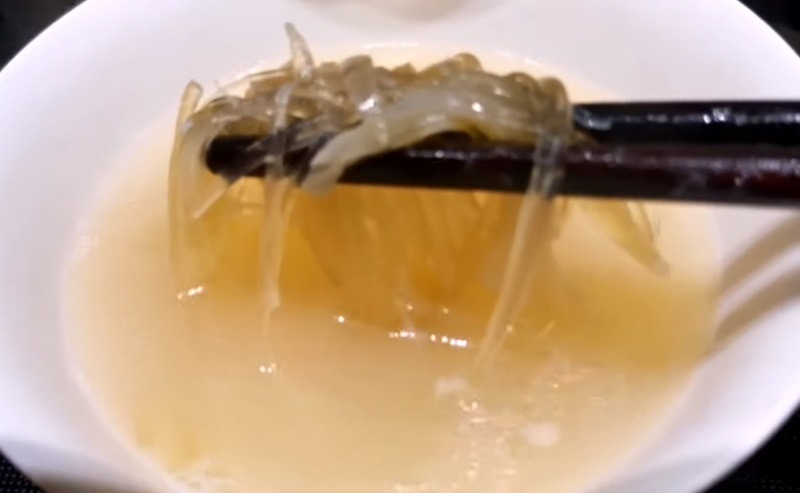
Shark fin soup, a culinary tradition in parts of China, Taiwan, and Southeast Asia, is a dish renowned for its unique texture provided by shark fins and its rich taste derived from a blend of soup ingredients. Typically reserved for special occasions like weddings and banquets, this dish has garnered criticism from animal welfare advocates due to the significant environmental impact of shark finning. The Humane Society International estimates that around 72 million sharks are killed annually for their fins.
Global concerns about the sustainability and ethical treatment of sharks have led to a decline in the consumption and availability of shark fin soup. Additionally, health issues related to the high concentration of BMAA in shark fins have surfaced, further challenging the dish's popularity.
To address these concerns, shark fin soup substitutes have emerged on the market, eliminating the need for actual shark fins and mitigating the environmental impact associated with shark finning. Traditional shark fin soup involves processing raw fins by removing the skin and denticles, shaping, and bleaching. Shark fins are available in various forms, including dried, cooked, wet, and frozen, with ready-to-eat shark fin soup also accessible in Asian markets. The preparation of dried fins, whether cooked and skinned or raw and unskinned, requires softening before they can be used in soup recipes.
Egg Tart

The egg tart, a delightful treat in Chinese cuisine, draws inspiration from both English custard tarts and Portuguese pastel de nata. This culinary creation features a pastry crust that cradles a luscious filling of egg custard. Egg tarts have become a popular offering at dim sum restaurants, Chinese bakeries, and cha chaan tengs, charming the palates of those who appreciate their delicate sweetness and velvety texture.
Originating in the early 20th century in Guangzhou (Canton), Guangdong province, the egg tart reflects the influence of European custard tarts on Chinese culinary traditions. This fusion of flavors and techniques has resulted in a beloved pastry that captures the essence of both Western and Eastern culinary delights. Today, the egg tart stands as a testament to the cross-cultural exchange of culinary ideas, enchanting taste buds with its harmonious blend of flaky pastry and creamy custard. Whether enjoyed as a delightful dim sum addition or a sweet indulgence from a local bakery, the egg tart remains a cherished delicacy, offering a taste of culinary history and cultural fusion.
Fish Ball

Fish balls, delectable orbs crafted from fish paste, offer a tantalizing experience with their unique textures and flavors. Composed of surimi or fish mince, salt, and a culinary binder like corn, tapioca flour or potato starch, these spheres are versatile and well-loved in East and Southeast Asia.
Popular in Chinese cuisine, the fish ball industry, predominantly operated by individuals of Chinese descent, has elevated these savory treats to a cultural culinary staple. Whether boiled, deep-fried, or incorporated into soups and hotpot dishes, fish balls are a favored snack, celebrated for their contribution to various culinary creations.
While European renditions tend to be less processed, employing ingredients like milk or potatoes for binding, Nordic countries also boast their unique variations. Embracing diverse forms across cultures, fish balls symbolize the global appreciation for seafood delights, showcasing the adaptability of this humble creation in the culinary landscape.
XO Sauce
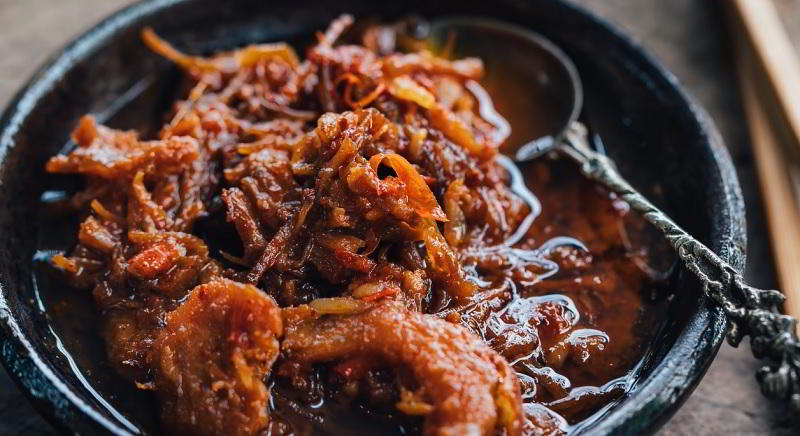
XO sauce, a culinary gem originating from Hong Kong, adds a spicy and umami-rich dimension to Cantonese cuisine, particularly in southern Chinese regions like Guangdong. This sauce, conceived in the 1980s, reflects the vibrant flavors of its birthplace.
Crafted with precision, XO sauce incorporates roughly-chopped dried seafood, including prized ingredients like dried scallops (conpoy), fish, and shrimp. These elements undergo a meticulous cooking process alongside chili peppers, onions, and garlic, resulting in a sauce that tantalizes the taste buds with its complex and savory profile.
Widely regarded as a Hong Kong creation, the Peninsula Hong Kong hotel's Chinese restaurant, Spring Moon, is often credited with introducing XO sauce to the culinary scene. However, some narratives attribute its origin to neighboring establishments in the bustling Tsim Sha Tsui area of Kowloon. Regardless of its exact birthplace, XO sauce stands as a testament to Hong Kong's culinary innovation, representing a perfect blend of tradition and modern flair in the realm of seafood-infused condiments.
Har Gow
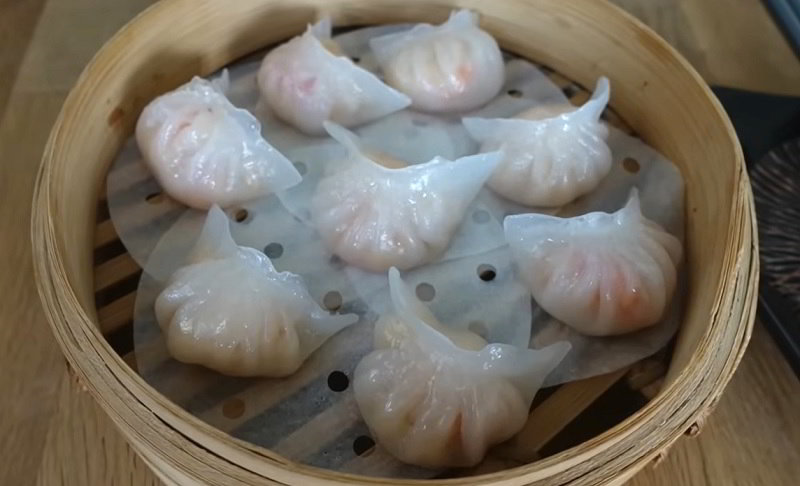
Har gow, a quintessential Cantonese dim sum, stands out as a delicate dumpling often referred to as a "shrimp bonnet" due to its intricate pleated shape. This culinary gem is part of the esteemed quartet known as The Four Heavenly Kings of Cantonese cuisine, alongside cha siu bao, shumai, and egg tarts.
Emerging in the outskirts of Guangzhou near the creek bazaar Deli, har gow earned its reputation as a benchmark for a dim sum chef's skill. The dumpling's hallmark is its smooth and transparent skin, resembling a meticulously crafted bonnet. Traditionally, it boasts seven to ten pleats, showcasing the chef's expertise. The skin is a delicate balance—thin and translucent, yet resilient enough to withstand handling with chopsticks without tearing or sticking.
Har gow's excellence lies in the meticulous cooking of the prawns, ensuring they are tender and flavorful without being overdone. Generously filled yet designed for a single, satisfying bite, har gow represents the epitome of artistry and precision in Cantonese dim sum.
Yuenyeung

Yuenyeung, a distinctive beverage hailing from Hong Kong, is a harmonious blend of coffee and tea that has stood the test of time in its place of origin. This flavorful concoction, widely popular and cherished, showcases the ingenuity of Hong Kong's culinary culture.
The precise method of crafting yuenyeung may vary among vendors and regions, but it typically involves a combination of brewed coffee, black tea, sugar, and milk. According to the Hong Kong Leisure and Cultural Services Department, the ideal mixture comprises three parts coffee to seven parts Hong Kong–style milk tea, creating a delightful symphony of flavors. Whether served steaming hot or refreshingly cold, yuenyeung has evolved from its origins at dai pai dongs (open-air food vendors) and cha chaan tengs (cafés) to grace the menus of diverse restaurants.
Yuenyeung's enduring popularity reflects its unique ability to offer a comforting and invigorating experience, blending the robust richness of coffee with the smooth, sweet notes of Hong Kong–style milk tea. This delightful fusion continues to be a beloved icon of Hong Kong's culinary landscape.
Jian Dui
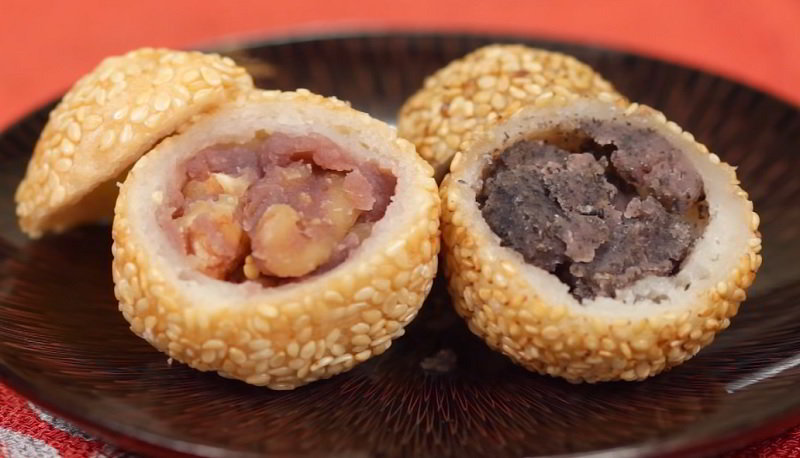
Jiandui, also known as sesame balls, stands out as a delectable fried Chinese pastry crafted from glutinous rice flour, reflecting a perfect blend of crispness and chewiness. The outer layer is generously coated with sesame seeds, contributing to its distinct texture. Upon immediate cooking, the pastry forms a large hollow, expanded by the dough's unique characteristics.
The indulgent core of jiandui harbors a delightful filling, traditionally featuring lotus paste. However, variations abound, incorporating sweet black bean paste or red bean paste, adding layers of flavor to this beloved treat. Regional nomenclature adds a touch of diversity, with terms such as mayuan in Northeast China, matuan in North and Northwest China, and zhendai in Hainan.
In the Philippines, jiandui takes on the name butsi, echoing centuries of Chinese influence on Filipino cuisine. This fusion has transformed buchi into an icon of Chinese Filipino culinary tradition, symbolizing auspiciousness. Local establishments, regardless of their culinary origins, including popular chains like Chowking, have embraced the delicacy. The Filipino version, beyond lotus and red bean paste, introduces diverse ingredients like ube, expanding the palette of flavors. Notably, unlike traditional jiandui, Filipino buchi and its derivatives can be boiled or steamed, broadening the culinary possibilities.
Rice Noodle Roll
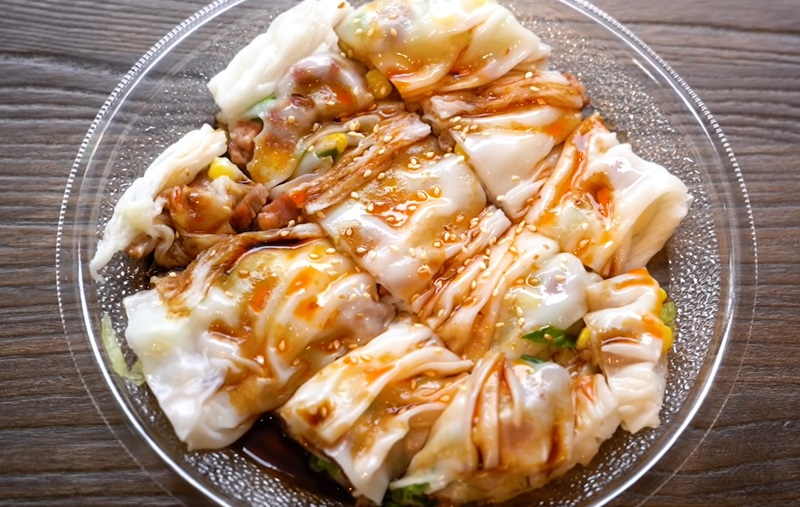
A culinary delight originating from Guangdong Province in southern China, the rice noodle roll, or cheung fun, stands as a versatile Cantonese dish enjoyed as a snack, small meal, or part of dim sum. This thin roll is crafted from a wide strip of shahe fen (rice noodles), offering a delicate texture that captivates the palate.
The rice noodle roll embraces a variety of fillings, such as succulent shrimp, flavorful beef, or vibrant vegetables, elevating its taste and appeal. Upon serving, the dish is generously adorned with seasoned soy sauce, occasionally enriched with siu mei drippings, imparting a savory finish.
When prepared without fillings, the plain rice noodle roll is known as jyu cheung fun, colloquially referred to as "pork intestine noodle" due to its resemblance to pig's intestines. The dish's history, though not officially documented, is often traced back to the 1930s, with its creation credited to the culinary ingenuity of Guangzhou, Guangdong Province. Locally, it is known as laai cheung, highlighting its unique hand-pulled noodle roll preparation.
Fermented Bean Curd
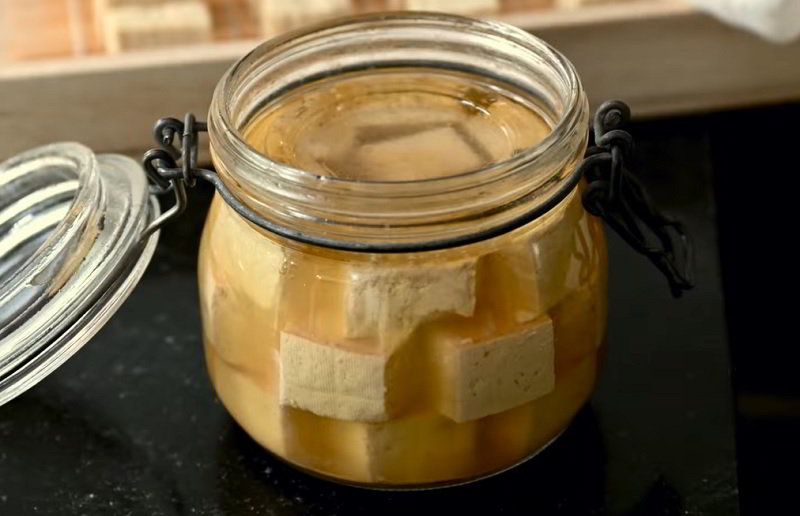
Embarking on a culinary journey through East Asian cuisine, one may encounter the unique and flavorful condiment known as fermented tofu, also referred to as fermented bean curd, tofu cheese, or sufu. Hailing from Chinese culinary traditions, this condiment involves a meticulous process of processing and preserving tofu to create a distinctive product.
The key ingredients in fermented tofu include soybeans, salt, rice wine, and sesame oil or vinegar, resulting in a harmonious blend of flavors. In mainland China, this culinary gem is often freshly distributed, embodying the authenticity of traditional preparation methods.
Beyond China, in Southeast Asian communities, commercially packaged versions are prevalent, housed in jars containing blocks of fermented tofu. These compact blocks, measuring 2 to 4 centimeters square and 1 to 2 centimeters thick, are immersed in brine and infused with select flavorings. This preservation method ensures a consistent and delectable taste, allowing enthusiasts to savor the unique charm of fermented tofu across various culinary creations.
Douhua
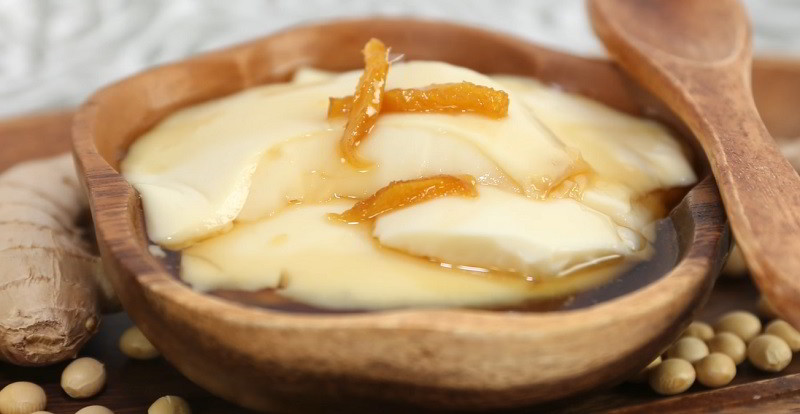
Douhua, a cherished Chinese delicacy, presents itself as a versatile snack crafted from silken tofu, captivating the palate with both sweet and savory variations. Known by several names such as doufuhua, soybean pudding, or tofu brains, this culinary gem graces tables across China, with Taiwanese and Cantonese renditions earning acclaim as symbols of Southern Chinese cuisine.
In northern China, it goes by the endearing moniker "tofu brains," showcasing its soft and silky texture. An integral part of yum cha, douhua often takes center stage in the vibrant tapestry of Southern Chinese culinary traditions.
Beyond formal dining, douhua is a beloved presence along popular hiking trails and beaches in Hong Kong, where it is locally known as tofu fa. This delightful treat, with its subtle sweetness or savory charm, encapsulates the essence of Chinese culinary creativity and continues to be a source of culinary joy and cultural significance.
Pineapple Bun
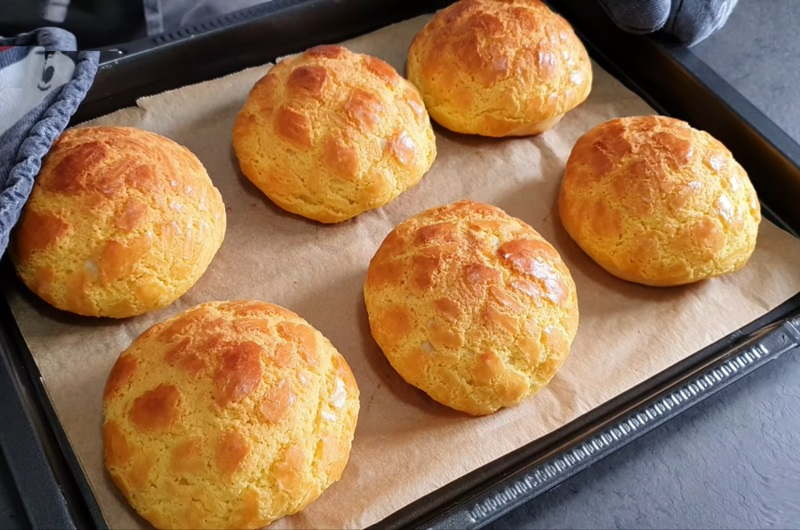
A pineapple bun, a beloved sweet bun originating from Hong Kong and embraced in Chinatowns worldwide, boasts a distinctive appearance rather than an actual pineapple-infused flavor. Contrary to its name, the nomenclature stems from the textured topping's resemblance to a pineapple's skin. A culinary icon in Hong Kong, it graces the menus of cha chaan tengs and dai pai dongs.
One delectable variation gaining popularity is the buttered pineapple bun, known as boh loh yau in Cantonese. These buns are often served piping hot, straight from the oven to the diner's table. The hallmark presentation involves the bun being halved, revealing a generous slice of butter nestled within. This infusion of butter enhances the delightful contrast of textures and flavors. Some innovative renditions even substitute butter with luscious custard, offering a tantalizing twist to this iconic treat. The pineapple bun, with its visual charm and culinary versatility, stands as a testament to the vibrant fusion of tradition and creativity in Chinese baking culture.
Singapore-style Noodles
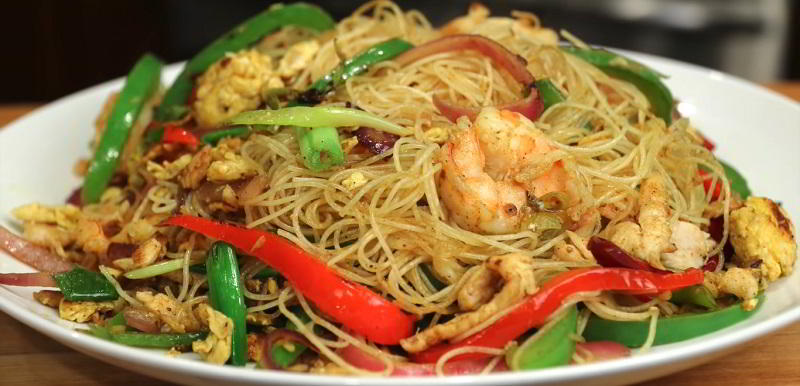
Singapore-style noodles, a delectable stir-fried creation, showcases a delightful medley of flavors and textures. This Cantonese-inspired dish harmoniously blends cooked rice vermicelli, scrambled eggs, curry powder, crisp vegetables, and a choice of meats, often featuring the savory notes of char siu pork or succulent prawns and chicken. Although widely enjoyed in Cantonese-style eateries and takeout joints in Hong Kong, the dish, curiously, has no roots or recognition in Singapore.
The naming misdirection extends to a similarly titled dish known as Xingzhou mifen or Xing Chow bee hoon, where Xingzhou poetically refers to Singapore in neighboring Malaysia. The divergence between the name and its origin adds an intriguing layer to the culinary narrative, emphasizing the creative evolution and cross-cultural influences that characterize the dynamic world of Chinese cuisine. As diners savor the rich interplay of curry-infused noodles, vibrant vegetables, and savory proteins, the Singapore-style noodles stand as a testament to the global appeal and adaptability of Cantonese culinary innovations.
Wonton Noodles
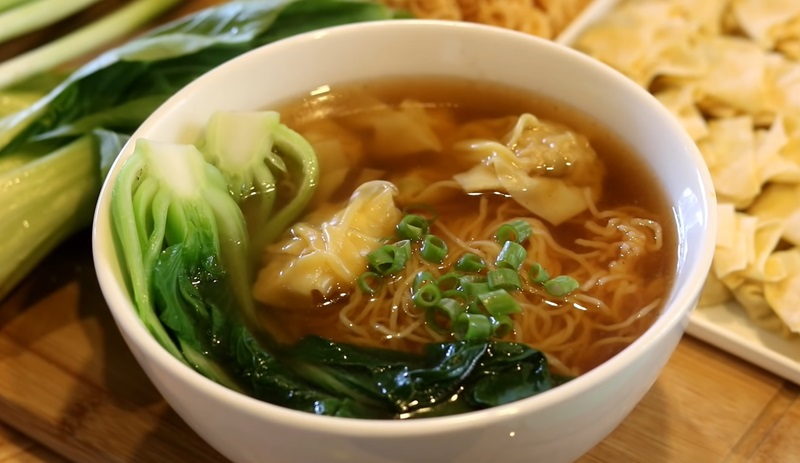
Wonton noodles, a culinary gem with roots dating back to the Tang Dynasty, have evolved into a beloved dish of Cantonese origin, celebrated across Southern China, Malaysia, Singapore, Hong Kong, Indonesia, and Thailand. This delightful creation features egg noodles immersed in a flavorful hot broth, adorned with vibrant leafy vegetables and succulent wonton dumplings. In the bustling streets of Guangzhou and Hong Kong, the dish takes center stage, presenting a steaming bowl of soup housing shrimp-filled wontons, accompanied by the crisp freshness of gai-lan, also known as Chinese broccoli or Chinese kale.
Wonton noodles display a remarkable variety, with chefs experimenting with diverse toppings and garnishes. The classic shrimp wontons, or Hong Kong dumplings, boast a filling of chicken, prawns, or pork, mingled with spring onions, and occasionally enriched with the earthy notes of mushrooms and black fungus. The inclusion of shui jiao, an alternative dumpling, adds further depth to the gastronomic experience. As this dish continues to captivate palates with its harmonious blend of textures and flavors, wonton noodles stand as a testament to the enduring legacy and adaptability of Cantonese culinary traditions.
Beef Chow Fun
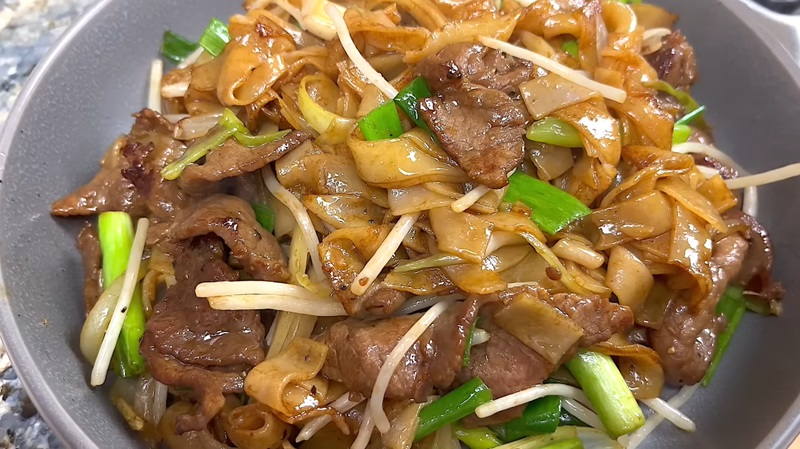
Beef chow fun, a quintessential Cantonese delicacy, masterfully combines the robust flavors of stir-fried beef, wide rice noodles (hor fun), and crisp bean sprouts. This culinary masterpiece graces the menus of yum cha establishments in Guangdong, Hong Kong, and international cha chaan tengs. The hor fun noodles, also known as shahe fen, originate from the town of Shahe in Guangzhou, boasting a wide and flat profile, cut to perfection.
Chow fun, or stir-fried hor fun, presents a myriad of preparations, akin to the diverse landscape of pizza varieties in American cuisine. In the Philippines, this delectable creation is fondly referred to as "beef hofan." The primary distinction lies in the cooking methods, with hor fun being either dry-fried, where it's skillfully sautéed with condiments like soy sauce, or wet-fried, featuring a sumptuous thickening sauce. The dry-fried variant commonly stars beef or chicken, while wet-fried hor fun often showcases delightful seafood. Whether enjoyed in a cozy cha chaan teng or a traditional yum cha setting, beef chow fun stands testament to the rich tapestry of Cantonese culinary excellence.
Custard Tart

Custard tarts, also known as flan pâtissier/parisien, artfully merge a delicately baked pastry with a sumptuous egg custard filling. This delectable creation transcends cultural boundaries, finding a cherished place in Chinese cuisine through the adaptation of the egg tart. Drawing inspiration from the English custard tart and Portuguese pastel de nata, the egg tart boasts a luscious egg custard within a delicate pastry crust. Renowned for its delightful interplay of textures and flavors, egg tarts grace bakeries, dim sum restaurants, and cha chaan tengs, weaving into the culinary tapestry of diverse dining experiences. Whether relished as a sweet indulgence or during dim sum sessions, custard tarts showcase the universal appeal of this time-honored pastry, marrying tradition with a rich, custard-filled essence.
Spare Ribs
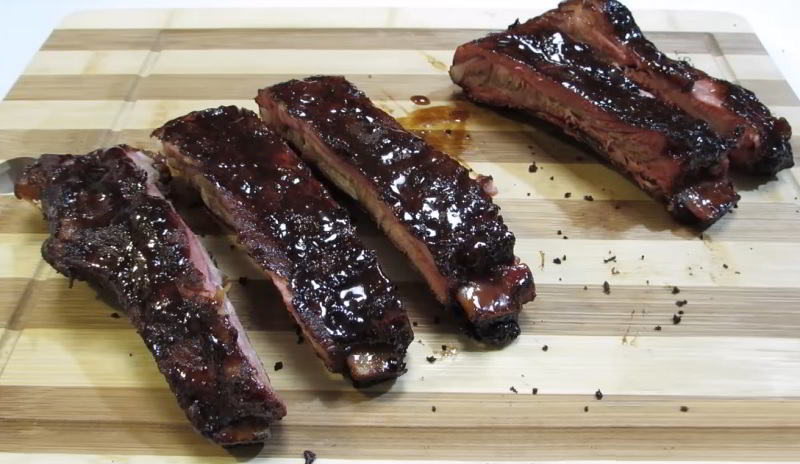
Spare ribs, also known as side ribs or spareribs, encompass a variety of ribs cut from the lower section of a pig, specifically the breastbone and belly, behind the shoulder, featuring 11 to 13 long bones covered with meat and fat. Distinguished from beef short ribs, pork spare ribs are renowned for their rich flavor and versatility, commonly prepared through low and slow methods such as grilling, smoking, or braising.
These ribs are enjoyed globally, with notable popularity in Chinese and American Chinese cuisines, referred to as paigu. In Cantonese cuisine, spare ribs are characterized by a red hue, roasted with a sweet and savory sauce, often appearing in siu mei, Cantonese roasted meat dishes. American Chinese cuisine favors the char siu style, showcasing pork spare ribs as part of appetizer platters like the pu pu platter. Their widespread appeal stems from the succulent combination of meat, fat, and flavorful preparations, making spare ribs a culinary delight enjoyed in diverse cultural contexts.
Pig Blood Curd
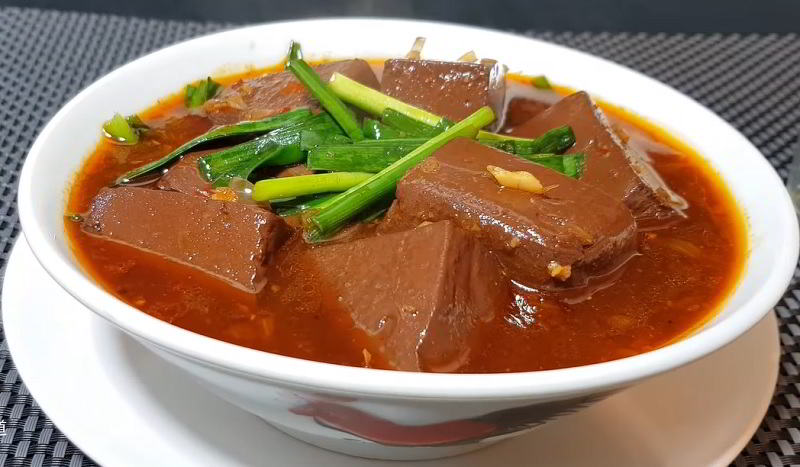
Pig blood curd, alternatively known as "blood pudding" or "blood tofu," stands as a sought-after Cantonese delicacy with widespread popularity in Hong Kong, Taiwan, southern China, and Vietnam. This unique culinary creation is often paired with carbohydrates, seamlessly blending with noodles or congee to create a flavorful and satisfying dish. The distinctively dark and rich pig blood curd adds a robust and earthy flavor to the meal, contributing to the diverse tapestry of Cantonese cuisine. Appreciated for its velvety texture and capacity to absorb surrounding flavors, pig blood curd has become a celebrated ingredient, reflecting the culinary ingenuity and cultural significance embedded in the gastronomic traditions of the regions it graces.
Whether enjoyed as part of a comforting bowl of congee or combined with the subtle notes of noodles, pig blood curd holds its own as a distinctive and cherished element in the vibrant world of Cantonese delicacies.
Buddha's Delight
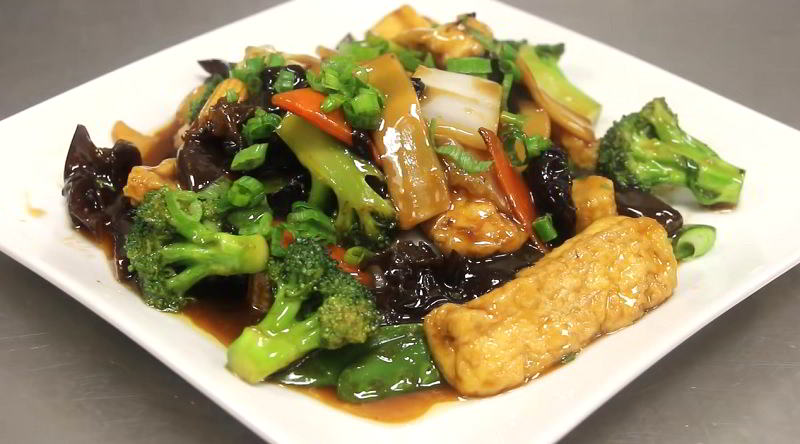
Buddha's delight, or Luóhàn zhāi, stands as a renowned vegetarian dish deeply rooted in Chinese and Buddhist culinary traditions. Originally crafted for Buddhist monks adhering to a vegetarian diet, this dish has transcended monastic kitchens and gained international recognition, becoming a popular vegetarian option in Chinese restaurants worldwide. The recipe features an array of vegetables and vegetarian components, occasionally complemented by seafood or eggs, all delicately simmered in a soy sauce-based liquid infused with various seasonings until achieving a tender perfection.
The diverse selection of ingredients contributes to the versatility of Buddha's delight, allowing for regional and personal variations in its preparation, both within Asia and beyond. With its rich history and adaptability, Buddha's delight symbolizes the harmonious intersection of culinary traditions and spiritual values, offering a flavorful and nutritious vegetarian experience that has captivated palates globally.
Pickled Onion
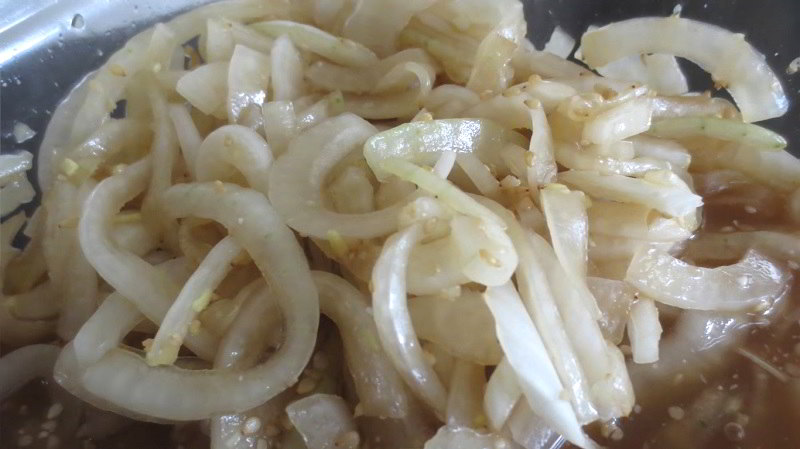
Pickled onions, a culinary delight, comprise onions submerged in a brine of vinegar and salt, often infused with additional preservatives and flavorings. Among the variations, 'silverskin' onions, derived from small white onions, undergo pickling to repurpose imperfect ones, preventing wastage. Silverskin onions, commonly pickled in white vinegar, present a petite profile. However, full-sized onions, like Spanish onions, can also undergo pickling if sliced beforehand.
The tangy and crisp nature of pickled onions makes them a versatile addition to various culinary creations. In the realm of mixology, they play a starring role in the Gibson cocktail, adding a distinctive touch to this variation of the classic Martini.
Beyond cocktails, pickled onions find a place in Cantonese cuisine, particularly in Hong Kong. Served in many Cantonese restaurants, especially during dinner, they serve as a delightful prelude, tantalizing the taste buds before the main course takes center stage. The global appeal of pickled onions lies in their ability to elevate flavors and complement diverse culinary experiences.
Zha Cai
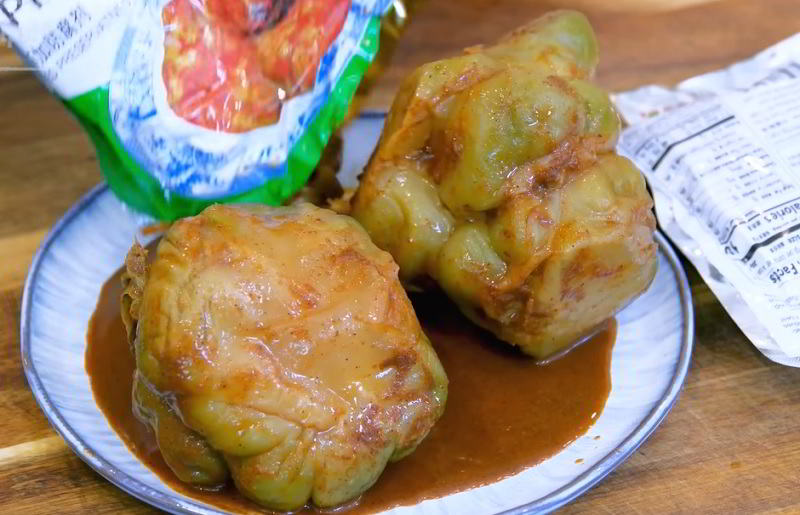
Zha cai, also known as Cha tsai, stands as a distinctive pickled delicacy hailing from Chongqing, China. Derived from mustard plant stems, this culinary gem tantalizes the taste buds with a unique blend of sour, spicy, and salty notes. Its exceptional texture, striking a balance between crunchiness and tenderness, draws a subtle parallel to Western pickled cucumbers.
To prepare zha cai, a thorough wash is recommended to eliminate the chili paste, while excess salt is expertly removed through a refreshing soak in fresh water. The preserved vegetable's umami richness, coupled with its varying spiciness levels determined by the chili paste quantity, contributes to its culinary allure.
In the realm of flavor complexity, zha cai is a standout, offering a sensory symphony that enriches a myriad of dishes. From its roots in Chongqing to international kitchens, this pickled mustard plant stem has become a symbol of culinary diversity, transcending cultural boundaries with its distinctive taste and versatile application in diverse cuisines.
Nian Gao
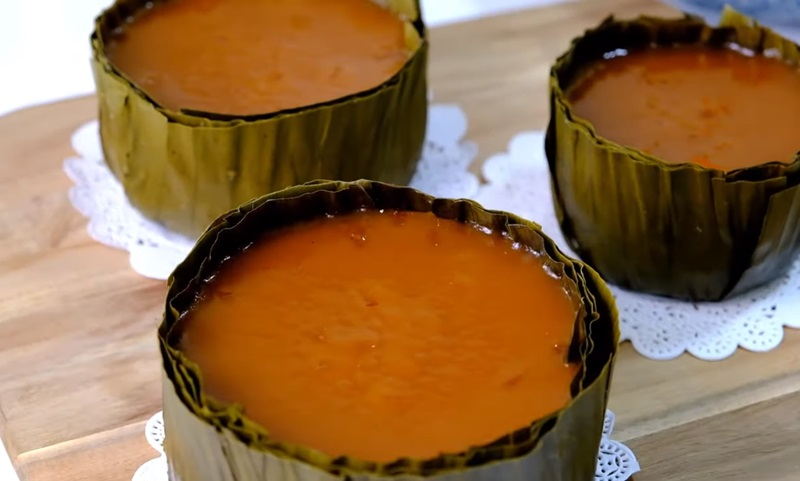
Nian Gao, also known as the Chinese New Year cake, holds a cherished place in Chinese cuisine, particularly during Lunar New Year celebrations. This sweet and sticky delight, whose name translates to "sticky cake," is believed to usher in good luck and prosperity for the upcoming year. Crafted from glutinous rice flour, the process begins with soaking the rice overnight, followed by fine grinding into flour. The resulting mixture combines this flour with water and sugar, forming a dense batter that is steamed until it transforms into a soft and chewy cake.
Variations of nian gao may incorporate additional elements such as red dates, coconut, or sesame seeds to elevate its flavor profile. Typically, nian gao is sliced into thick pieces, offering the flexibility to enjoy it plain or pan-fried. The pan-fried version presents a delightful contrast between a crispy outer layer and a chewy interior.
In Guangdong, the nian gao variant leans towards sweetness, often using brown sugar, resulting in a distinct dark yellow hue. The mixture is steamed once more to settle, creating a stretchy and extremely sticky texture. Whether enjoyed as is or flavored with rosewater or red bean paste, nian gao encapsulates the festive spirit and culinary traditions of the Lunar New Year.
Cha Siu Bao
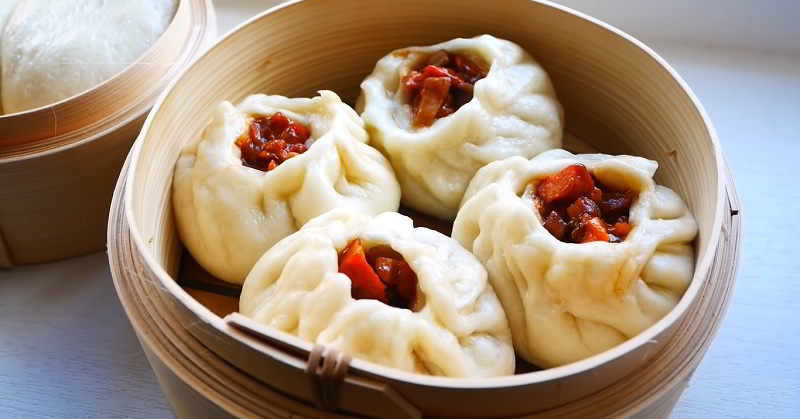
Cha Siu Bao, a delectable Cantonese baozi, offers a culinary symphony with its barbecue-flavored cha siu pork filling. This delightful dim sum dish graces the tables of yum cha and finds its way into the offerings of Chinese bakeries.
Visually resembling other steamed baozi, what sets the dough of steamed cha siu bao apart is its unique combination of yeast and baking powder as leavening agents. This blend creates a slightly dense yet fine, soft bread texture. Tangzhong, a water roux, is occasionally incorporated to maintain the bread's softness over extended periods, enhancing its overall texture.
In addition to the steamed variety, an alternative baked version exists. The dough closely resembles its steamed counterpart, but the baked cha siu bao takes on characteristics of a sweetened, breadier bun. Often brushed with an egg and sugar wash before baking, it achieves a subtle sweetness.
At the heart of this delectable treat lies tender, sweet, slow-roasted pork tenderloin. Diced and combined with a flavorful mixture of roasted sesame seed oil, hoisin sauce, soy sauce, sugar, rice vinegar, oyster sauce, shaoxing wine or dry sherry, and cornstarch, the cha siu filling encapsulates a symphony of savory and sweet notes within the embrace of the soft, textured bun.
Yusheng

Yusheng, a vibrant Malaysian and Singaporean creation, unfolds as a captivating raw fish salad that tantalizes the taste buds with its unique medley of flavors and textures. Typically featuring strips of raw fish, often salmon, this culinary masterpiece entwines with a colorful array of shredded vegetables, presenting a delightful harmony of freshness.
The artistry of Yusheng extends beyond its primary ingredients, as it embraces a diverse ensemble of sauces, condiments, and other flavorful components. This captivating dish orchestrates a symphony of tastes, textures, and visual appeal, making it a culinary centerpiece during festive occasions.
For those opting for a vegetarian rendition, Yusheng gracefully transforms, with soy "fish" stepping in to mirror the essence of salmon. This thoughtful adaptation ensures that the dish remains inclusive, catering to various dietary preferences without compromising on the vibrancy and richness that define Yusheng.
Beyond being a feast for the senses, Yusheng holds cultural significance, often gracing tables during celebratory moments, symbolizing prosperity, good fortune, and the shared joy of communal gatherings. With its dynamic composition and cultural resonance, Yusheng stands as a testament to the culinary diversity and creativity embedded in Malaysian and Singaporean cuisine.
Dried Shredded Squid
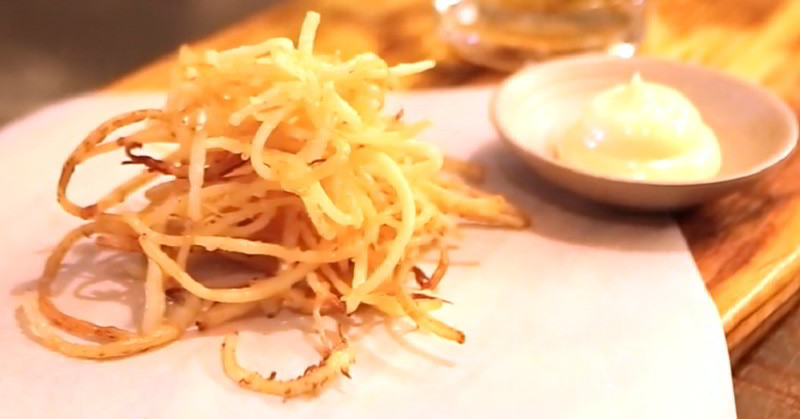
Dried shredded squid, a savory delight with roots in coastal Asian regions, Russia, and Hawaii, emerges as a delectable seafood product that showcases the culinary prowess of these diverse locales. Crafted from squid or cuttlefish, this treat is meticulously dried, shredded, and seasoned to perfection, resulting in a snack that captivates the taste buds with its unique combination of flavors and textures.
Known interchangeably as dried shredded cuttlefish, this culinary creation holds a cherished place in the snacking traditions of coastal communities. The meticulous process of drying and seasoning transforms the squid or cuttlefish into a portable, flavorful delight that can be enjoyed on various occasions.
Whether relished as a standalone snack or incorporated into diverse culinary preparations, dried shredded squid stands as a testament to the culinary ingenuity embedded in coastal Asian cultures and beyond. Its popularity in various regions speaks to its universal appeal, making it a beloved treat with a rich tapestry of flavors that transcends geographical boundaries.
Sweetheart Cake
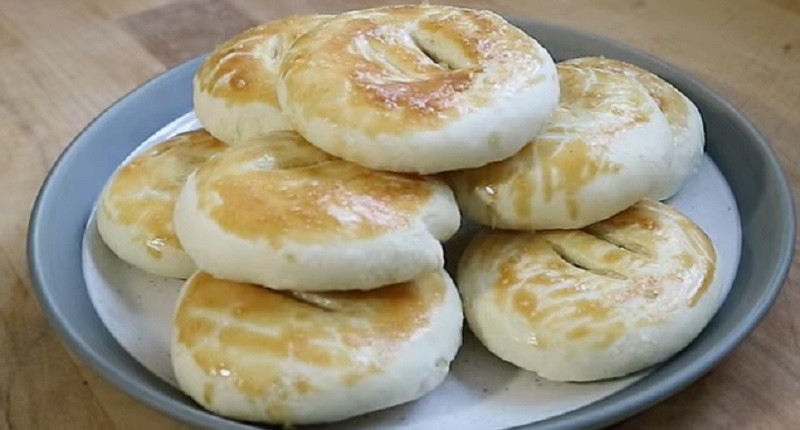
A sweetheart cake, also known as a wife cake or marriage pie, encapsulates the essence of traditional Chinese pastry craftsmanship. Originating from Guangdong province and celebrated as a specialty in Hong Kong's Yuen Long District, this delicacy boasts a flaky crust crafted with precision, enveloping a delectable filling featuring candied winter melon, white sesame seeds, and glutinous rice flour. The amalgamation of coconut, almond paste, and a hint of vanilla enhances the symphony of flavors within.
The pastry's authenticity is marked by the use of pork lard shortening, providing a flaky texture that harmonizes with the mild sweetness of the filling. In Western adaptations influenced by immigration, butter may replace lard, subtly altering the taste while maintaining the essence of this cherished treat. Renowned for its distinctive blend of textures and flavors, the sweetheart cake represents the culinary artistry embedded in Chinese traditions, making it a beloved symbol of craftsmanship and cultural richness.
Egg Waffle
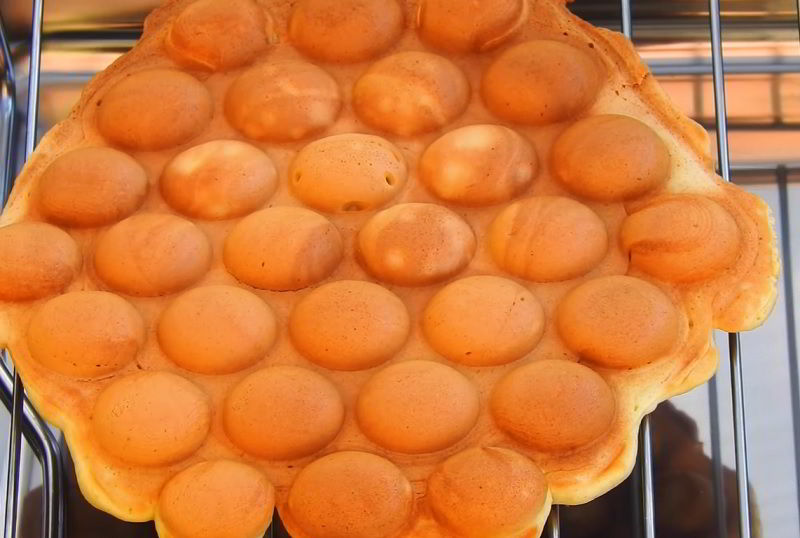
Egg waffles, or gai daan jai in Cantonese, have become a cherished street snack with roots in Macau and Hong Kong, celebrated for their iconic spherical shape. These delightful treats are crafted from a leavened batter rich in eggs, cooked between two semi-spherical plates to achieve a texture that is both crispy and fluffy. Served piping hot, egg waffles are enjoyed in their pure form or adorned with a variety of flavors like coconut, strawberry, or chocolate.
Known by different names such as bubble waffle, egg puff, pancake balls, and occasionally referred to as Hong Kong cakes in Chinatowns across America, each piece of egg waffle features 20 to 35 small round 'balls,' enhancing the snack's appeal. With a history dating back to the 1950s, egg waffles have transformed from street kiosks and coal fire heating to become one of the most popular and beloved street snacks in Hong Kong.
Hong Kong–style Milk Tea

Hong Kong–style milk tea, a beloved tea drink, is meticulously crafted from Ceylon black tea and a blend of milks, often including evaporated milk and condensed milk. Integral to Hong Kong's tea culture, it is a staple during lunchtime, with an astounding consumption of approximately 900 million glasses/cups annually by Hongkongers. Despite its origin in Hong Kong, this distinctive tea blend has transcended borders and can be savored in restaurants worldwide that specialize in Hong Kong cuisine and Hong Kong–style western dishes. Recognized for its cultural significance, the unique technique of preparing Hong Kong–style milk tea has earned a spot on the representative list of the Intangible Cultural Heritage of Hong Kong. This iconic beverage has further solidified its popularity, earning the 4th position in the ranking of the most cherished food and drinks in Hong Kong, as showcased in the Top Eat 100 television show aired on 4 February 2012.
Pig's Ear
-1703151613.jpg)
Pig's ear, a culinary delicacy, involves the preparation of the cooked ear of a pig and is featured in various global cuisines. In Cantonese culinary traditions, pig's ear becomes a notable ingredient incorporated into lou mei, a dish celebrated for its utilization of all edible parts of the pig. Unlike some delicacies, lou mei, and pig's ears in general, are not elevated to the status of gourmet delights in Cantonese cuisine. Instead, they are valued for their role in maximizing the use of all parts of the pig, showcasing the culinary ethos of minimizing waste and utilizing every edible component. This approach reflects a practical and sustainable approach to food preparation, ensuring that diverse parts of the animal are transformed into flavorful and textured dishes within the rich tapestry of Cantonese culinary offerings.
Roast Goose
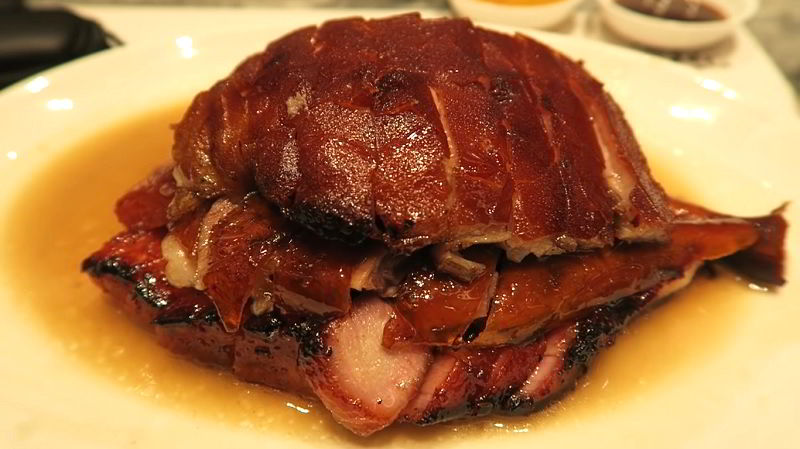
Roast goose, a culinary technique involving the dry heat roasting of goose meat, is a globally celebrated dish found in various cuisines such as Cantonese, European, and Middle Eastern. This cooking method, characterized by enveloping the goose evenly on all sides with hot air, enhances its flavor, creating a delectable culinary experience.
In Guangdong and Hong Kong, roast goose stands out as a distinguished member of siu mei, a celebrated classification comprising a diverse array of roasted meat delicacies within Cantonese culinary traditions. This culinary tradition entails roasting geese to perfection, meticulously seasoned and cooked in a charcoal furnace at elevated temperatures. The hallmark of a high-quality roast goose lies in its crisp skin coupled with juicy and tender meat, offering a delightful contrast of textures.
Served traditionally with plum sauce to augment its flavor profile, roast goose has secured its status as a beloved dish. According to a 2016, survey conducted by the municipal government of Guangzhou, roast goose emerged as the top choice among diners, outshining other renowned dishes such as white cut chicken and roast squab in terms of culinary preferences.
Turnip Cake
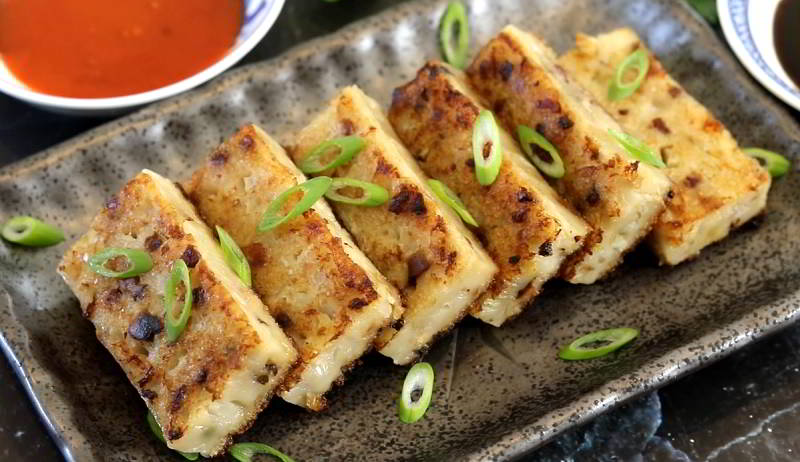
Turnip cake, a beloved Chinese dim sum offering, is more accurately known as radish cake due to the use of shredded Chinese radish and plain rice flour, distinct from Western-style turnips.
In Singapore, it goes by the name "carrot cake." This culinary delight is a staple in Cantonese yum cha, where it is often served in rectangular slices, occasionally pan-fried for a crispy exterior. The pan-fried version boasts a thin, crunchy layer outside, while the non-fried variant remains soft throughout. Turnip cake holds its place as a standard dish in the dim sum repertoire in China and overseas Chinatown restaurants.
Particularly significant during Chinese New Year, the Hokkien language adds a layer of symbolism, as the word for radish is a homophone for "good fortune." Beyond dim sum, turnip cake finds a place in Taiwanese breakfast menus, showcasing its versatility and widespread appeal. Whether enjoyed during festive celebrations or as part of everyday breakfast, turnip cake continues to captivate taste buds with its unique texture and flavors.
Shahe Fen
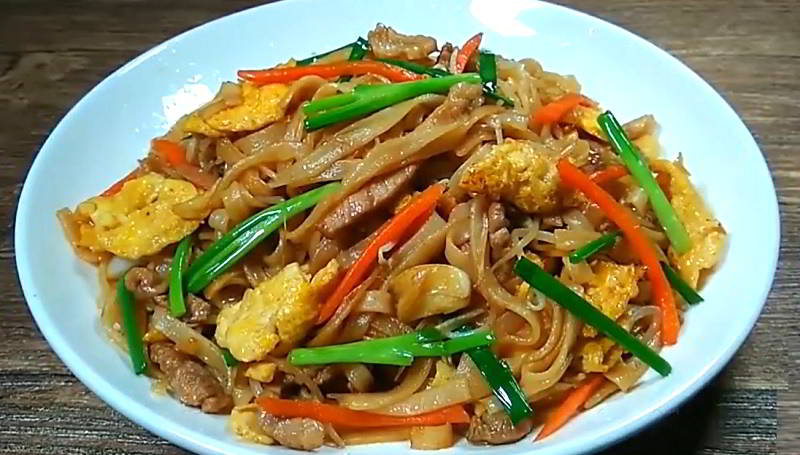
Shahe fen, a wide Chinese rice noodle, is a key ingredient in the popular dish known as chao fen, often stir-fried with a delectable combination of meat and vegetables. In Chinese restaurants across North America, the dish is commonly referred to as chow fun, derived from the Cantonese pronunciation, even though the term chao fen is a transliteration from Mandarin. The wide, smooth texture of shahe fen lends itself well to stir-frying, creating a satisfying and flavorful dish that has become a favorite among both locals and international diners.
Suan Cai
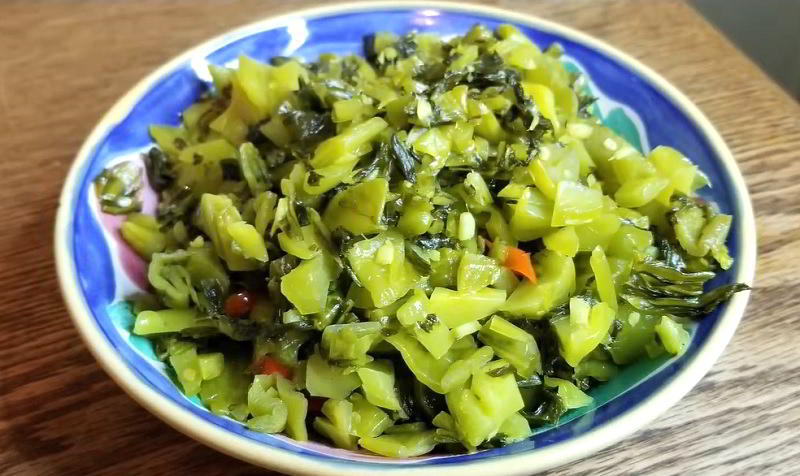
Suancai, a traditional Chinese pickled cabbage or mustard made from napa cabbage, stands out as a distinctive form of paocai, thanks to its unique ingredients and production method. In Cantonese cuisine, suancai takes on various roles, commonly served in small dishes, often as complimentary appetizers in restaurants. Occasionally, it is presented in mini-containers directly on the dining table. The versatility of suancai allows for different variations, including the Cantonese rendition known as salted suancai. This pickled delicacy adds a flavorful touch to meals, contributing to the rich tapestry of Cantonese culinary traditions.
Chenpi
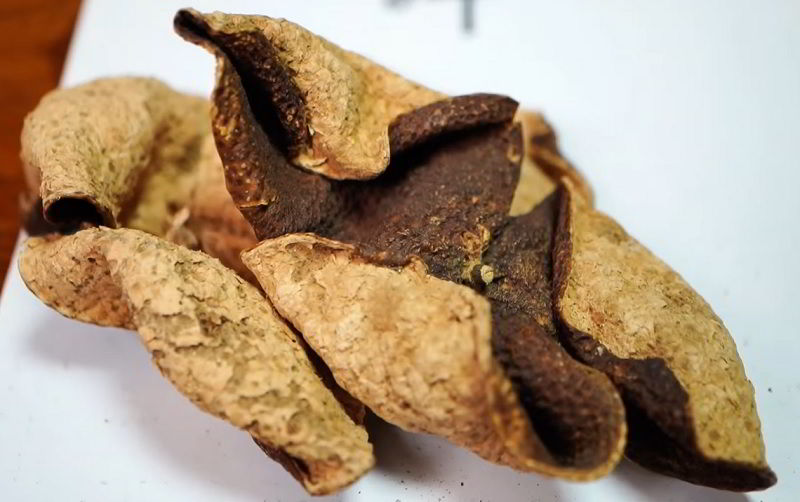
Chenpi, commonly known as sun-dried mandarin orange peel, serves as a traditional seasoning in Chinese cuisine and finds applications in traditional medicine. To enhance its flavor profile, chenpi undergoes an aging process through dry storage. Initially, the taste is subtly sweet, followed by a lingering and robust combination of pungency and bitterness. In Chinese herbology, chenpi is classified as warm in its attributes. Often referred to by its alternative name, 'ju pi' or mandarin orange peel, this ingredient adds a distinctive and nuanced dimension to dishes, showcasing its significance in both culinary and medicinal practices within Chinese culture.
Tong Sui
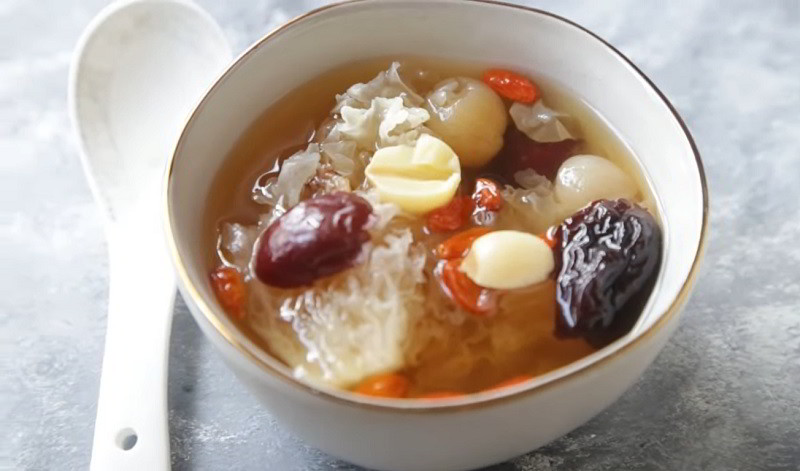
Tong sui, also known as tim tong, encompasses a diverse array of sweet soups or custards served as desserts, typically concluding a Chinese meal. Originating from the Lingnan region, which includes Guangdong, Macau, Hong Kong, Guangxi, Hainan, and certain parts of other provinces in China, tong sui holds cultural significance. In a narrower sense, the term specifically refers to soupy desserts from Lingnan, but it is also used more broadly to encompass any soupy dessert in Chinese-speaking regions.
Specialized establishments, known as tong sui stores, offer an extensive variety of these desserts, reflecting the rich culinary tradition of Lingnan. Over time, tong sui has gained popularity beyond its place of origin, reaching various parts of China and extending to international locations such as Australia, Canada, and the United States. The global presence of tong sui stores attests to the widespread appeal and appreciation for these delightful sweet treats.
Lo Mai Gai
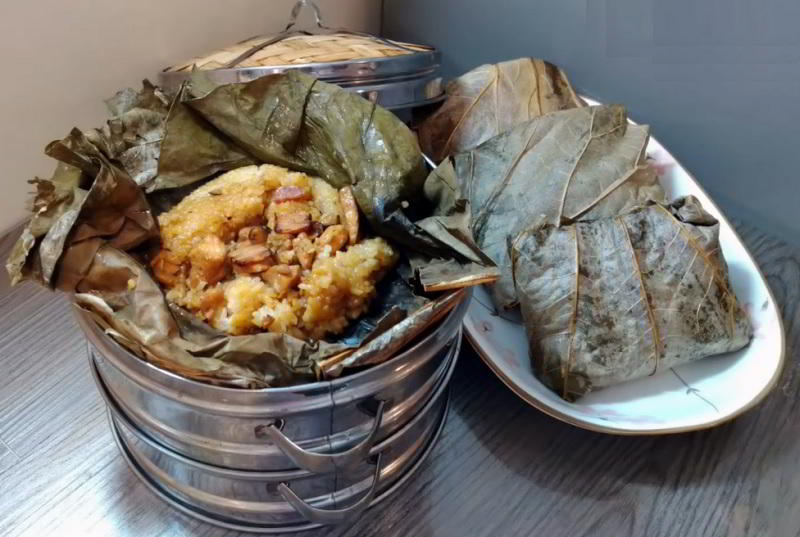
Lo mai gai, a quintessential dim sum delight served during yum cha, features a generous portion of glutinous rice enveloping a flavorful medley of ingredients. Typically associated with southern Chinese cuisine, this dish showcases a harmonious blend of chicken, scallions, Chinese sausage, Chinese mushrooms, and occasionally dried shrimp or salted egg encased in the glutinous rice. The rice bundle is meticulously wrapped in a dried lotus leaf and subjected to gentle steaming. In North America, creative adaptations may employ banana or grape leaves as substitutes for the traditional lotus leaf. Recognizing the substantial size of lo mai gai, a smaller variant named jan ju gai has been crafted to offer a more petite portion. This dim sum delicacy, with its rich combination of textures and flavors, remains a beloved choice among enthusiasts of Chinese cuisine, embodying the artistry and tradition of yum cha dining experiences.
Crispy Fried Chicken
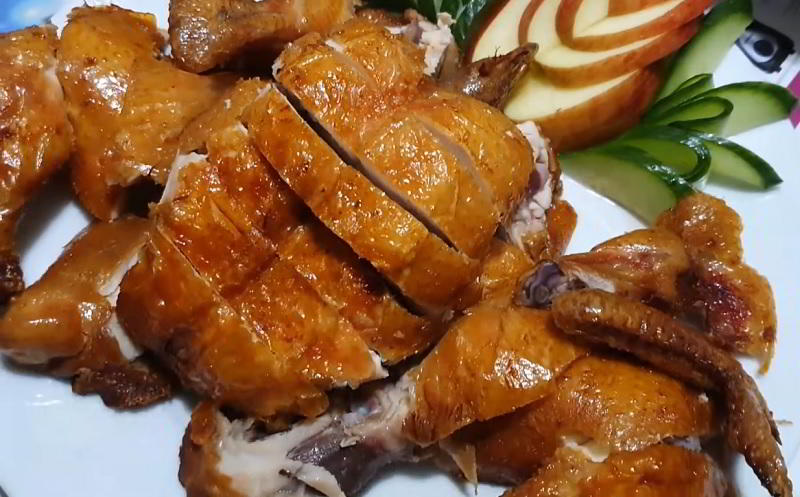
Crispy fried chicken, a hallmark of Cantonese cuisine in southern China and Hong Kong, boasts a preparation method that results in an irresistibly crunchy skin and tender white meat. The chicken undergoes a multi-step process, beginning with poaching in a flavorful spice-infused water mixture featuring ingredients like nutmeg, Sichuan pepper, star anise, ginger, fennel, cinnamon, and scallions. Following poaching, the chicken is meticulously dried, coated in a vinegar and sugar syrup for a touch of sweetness, and allowed to thoroughly air-dry, contributing to the coveted crispiness of the skin. The final step involves deep-frying to perfection.
Served alongside the crispy fried chicken are two complementary side dishes. Pepper salt, prepared by dry-frying with a distinctive dark white to gray hue, consists of salt and Sichuan pepper. Accompanying the ensemble are prawn crackers, adding a delightful crunch to the dining experience. This delectable dish, often enjoyed during nighttime meals, holds a place of honor at Chinese weddings and various Asian celebrations, showcasing its significance in festive culinary traditions.
Snake Soup

Snake soup, a celebrated Cantonese delicacy and esteemed health supplement in Hong Kong, features the meats of at least two snake varieties as its primary ingredients. This culinary masterpiece combines chrysanthemum leaves and an assortment of spices, imparting a subtly sweet flavor to the soup. The snake meat within the broth is renowned for its texture and taste, often likened to that of chicken. This exotic dish not only captivates the palate with its unique blend of flavors but is also revered for its perceived health benefits in traditional Chinese medicine. With its distinct combination of ingredients and cultural significance, snake soup stands as a testament to the rich culinary heritage and diverse gastronomic offerings found in Cantonese cuisine.
Chai Tow Kway
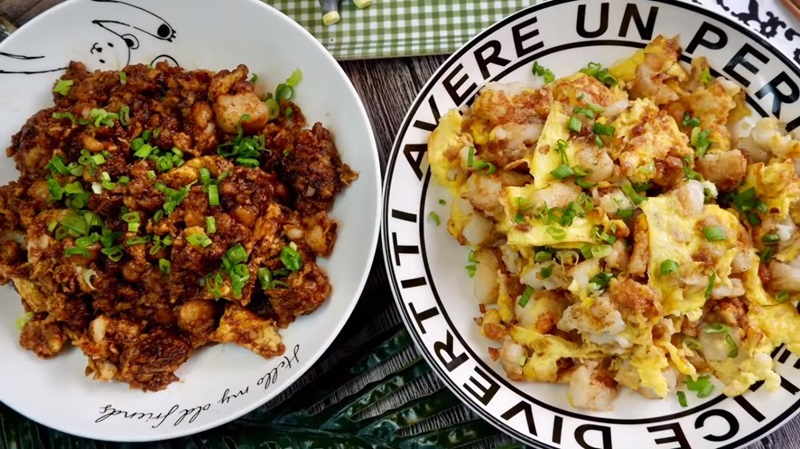
Chai tow kway, a staple in Chaoshan cuisine, delights palates with its popularity extending to Malaysia, Indonesia, Thailand, Taiwan, Singapore, and Vietnam. This dish comprises stir-fried cubes of radish cake, showcasing the culinary expertise of Chaoshan cuisine. Notably, in locations like Singapore, it is occasionally misinterpreted as carrot cake, leading to a bit of culinary confusion. The radish cake, crafted into savory cubes and expertly stir-fried, presents a delightful medley of textures and flavors, capturing the essence of Chaoshan culinary traditions. This gastronomic treasure has traversed borders, becoming a beloved dish in various Southeast Asian countries, where its delectable radish goodness takes center stage in the diverse tapestry of regional cuisine.
Lemon Chicken
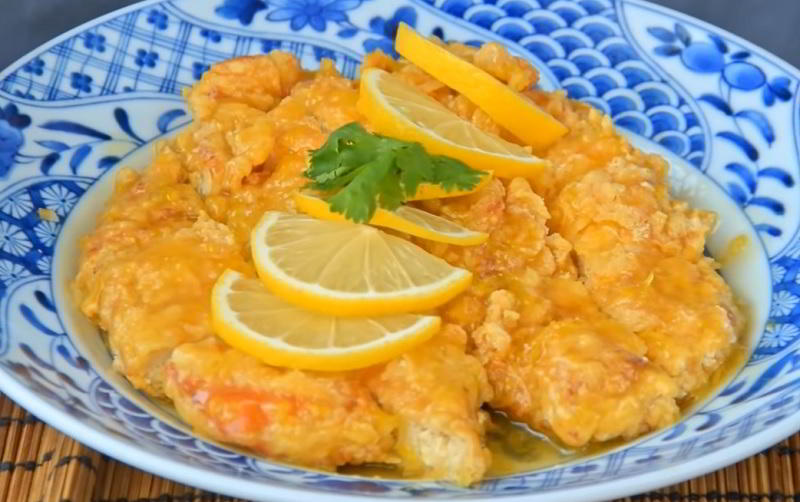
Lemon chicken, a dish celebrated across diverse culinary traditions, manifests in various interpretations worldwide, each highlighting the harmonious marriage of chicken and lemon. In Canadian and British-Chinese cuisine, this delicacy often features sautéed or deep-fried chicken pieces, adorned with a luscious, sweet lemon-infused sauce. An intriguing variation from the Panda Hotel in Tsuen Wan, Hong Kong, involves batter-coated chicken, rolled in almond slivers, deep-fried to golden perfection, and drizzled with a tantalizing lemon glaze.
Across Australasia, a beloved rendition emerges, encompassing battered and fried chicken, generously bathed in a zesty lemon sauce. This global culinary phenomenon underscores the universal appeal of combining succulent chicken with the vibrant, citrusy notes of lemon, creating a symphony of flavors that transcends borders and captivates taste buds with its sweet, tangy allure.
Subgum
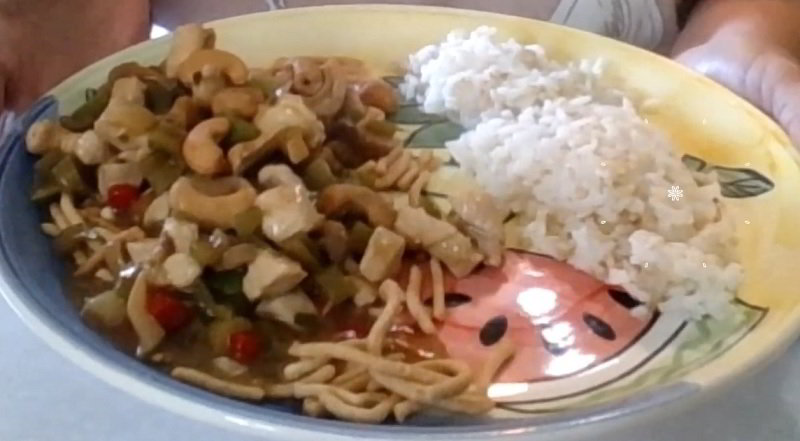
Subgum, a delectable dish rooted in Cantonese cuisine, graces Chinese restaurant menus across North America, captivating diners with its harmonious blend of meats, seafood, vibrant vegetables, and occasionally rice, noodles, or soup. This culinary creation, known for its versatility and rich flavors, reflects the artful fusion of textures and tastes that characterizes Cantonese gastronomy.
The term "subgum" itself encompasses a variety of delightful combinations, showcasing the culinary ingenuity of Cantonese chefs. Each iteration of subgum may feature a unique medley of ingredients, offering a delightful experience for diners seeking a symphony of flavors. Whether it's the succulence of meats, the brininess of seafood, or the crisp freshness of vegetables, subgum stands as a testament to the culinary legacy of Cantonese cuisine, celebrated for its ability to elevate simple ingredients into a delightful and satisfying gastronomic experience.
Shrimp Toast
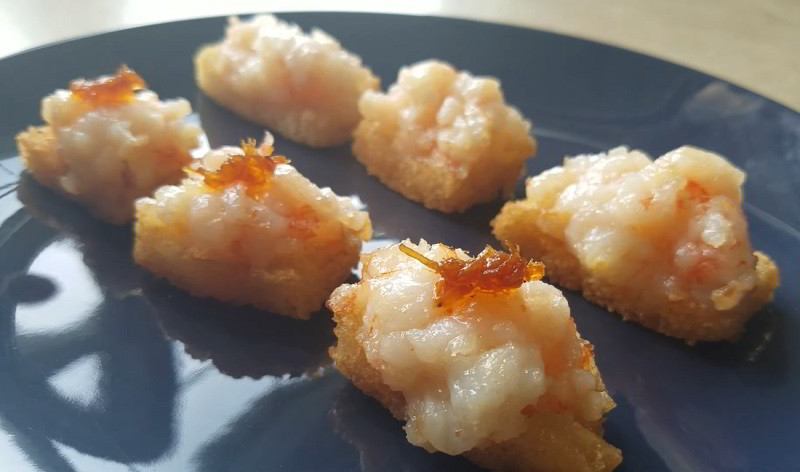
Shrimp toast, a delightful Cantonese dim sum originating from Hong Kong, has become a beloved appetizer in Western Chinese cuisine, captivating taste buds with its exquisite blend of flavors and textures. Crafted from small triangles of bread, this dish undergoes a delectable transformation as it gets coated with a paste meticulously fashioned from minced shrimp. The culinary journey of shrimp toast culminates in either baking or deep frying, resulting in a crispy exterior and a sumptuously savory core.
The dish's popularity has transcended cultural boundaries, finding a special place on tables in Australia, the United Kingdom, and Ireland. A variant known as sesame prawn toast adds an extra layer of flavor by incorporating sesame seeds into the preparation process, enhancing both the visual appeal and taste profile of this culinary masterpiece. Whether enjoyed as part of a dim sum spread or relished as an appetizer, shrimp toast continues to captivate global palates with its irresistible combination of crusty exterior and succulent shrimp-infused interior.
Fun Guo
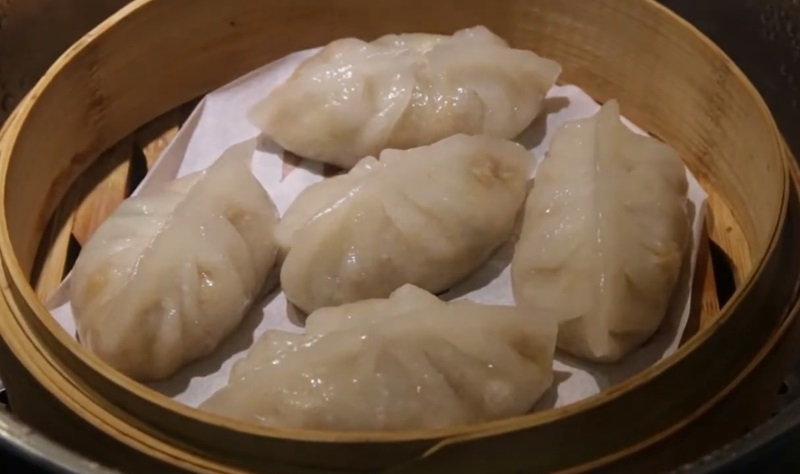
Fun guo, or Chaozhou fun guo, emerges as a delectable variety of steamed dumplings hailing from the coastal eastern Guangdong province in Southern China, specifically from the Chaoshan region. Distinctive in its appearance, fun guo bears a striking resemblance to the well-known har gaw, a popular Cantonese-style shrimp dumpling featured in dim sum. This culinary creation showcases the rich and diverse tapestry of regional Chinese cuisine, with each dumpling encapsulating the unique flavors and traditions of the Chaoshan culinary heritage. Fun guo stands as a testament to the artistry and innovation present in Chinese dim sum, offering a delightful culinary experience that captivates both the eyes and the taste buds.
Chinese Steamed Eggs
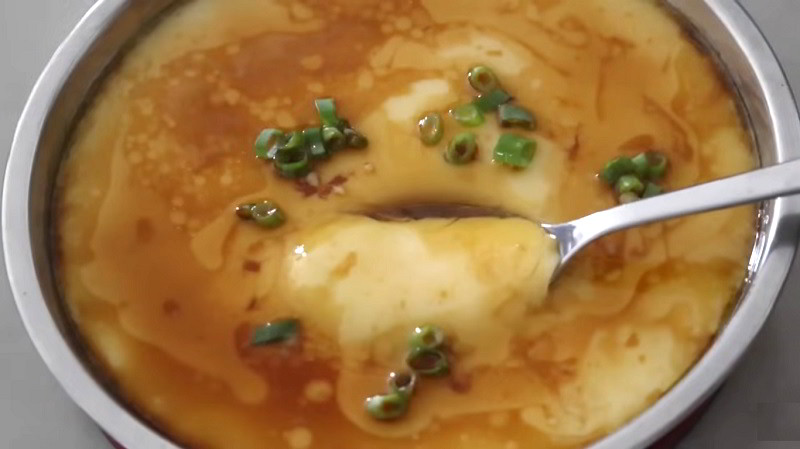
Chinese steamed eggs, also known as water egg, represent a traditional culinary delight that spans the diverse regions of China. This classic dish involves beating eggs to a consistency reminiscent of an omelette and then subjecting them to the gentle embrace of steam. Renowned for its simplicity and subtle elegance, Chinese steamed eggs offer a velvety texture and delicate flavor that has earned it the colloquial moniker of "egg custard" on restaurant menus. The art of steaming transforms humble ingredients into a harmonious symphony of taste and texture, showcasing the culinary finesse embedded in Chinese gastronomy. Whether enjoyed as a comforting home-cooked meal or savored in restaurants, Chinese steamed eggs stand as a testament to the time-honored culinary traditions that continue to captivate palates across the vast expanse of China.
Mango Pomelo Sago
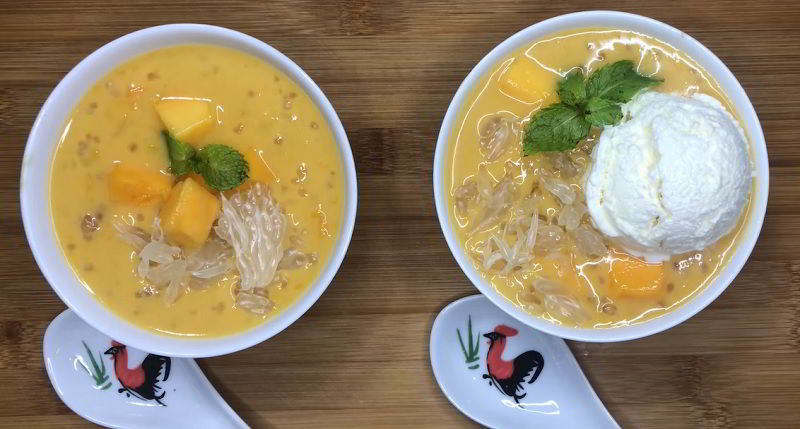
Mango pomelo sago emerges as a delectable contemporary Hong Kong dessert, reflecting the dynamic culinary landscape of the region. This enticing treat typically features a delightful medley of diced mango, sago pearls, coconut milk, pomelo, and milk, harmonizing flavors and textures in every spoonful. Widely available in Chinese restaurants and dessert establishments, its popularity extends beyond Hong Kong to Guangdong, Malaysia, Singapore, and Taiwan. Over time, this dessert has undergone creative evolution, giving rise to diverse variations that include its incorporation into other desserts and beverages, showcasing the adaptability and innovation inherent in culinary traditions. Mango pomelo sago stands as a testament to the vibrant and ever-evolving nature of Hong Kong's dessert culture, captivating taste buds with its sweet, creamy, and refreshing profile.
Almond Tofu
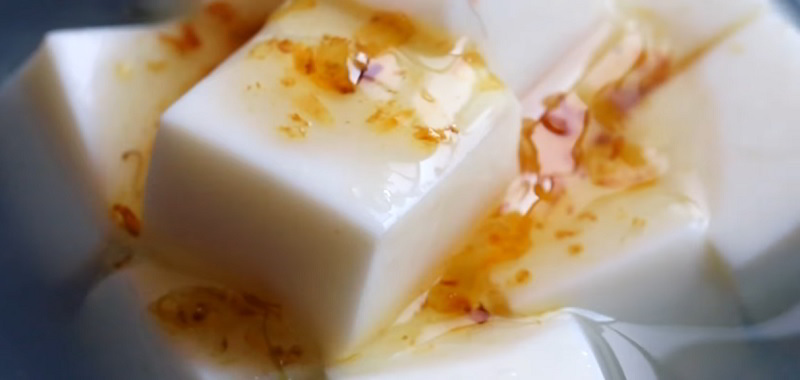
Almond tofu, a luscious and jellied dessert, emerges as a delectable creation rooted in Chinese culinary heritage. Crafted from the essence of apricot kernel milk, sugar, and the subtle embrace of agar, this delicacy has found widespread acclaim, extending its influence to regions such as Hong Kong, Singapore, Japan, Malaysia, and Hawaii. The dessert's velvety texture and harmonious fusion of sweet notes make it a beloved treat in various culinary landscapes. Drawing parallels to the French blancmange, almond tofu exemplifies the artful blending of tradition and innovation in the realm of global desserts, captivating palates with its delightful taste and cultural resonance. Whether savored as a sweet conclusion to a meal or embraced as a cultural delicacy, almond tofu stands as a testament to the enduring appeal of Chinese culinary creations that transcend borders and captivate the senses.
Siu Yuk
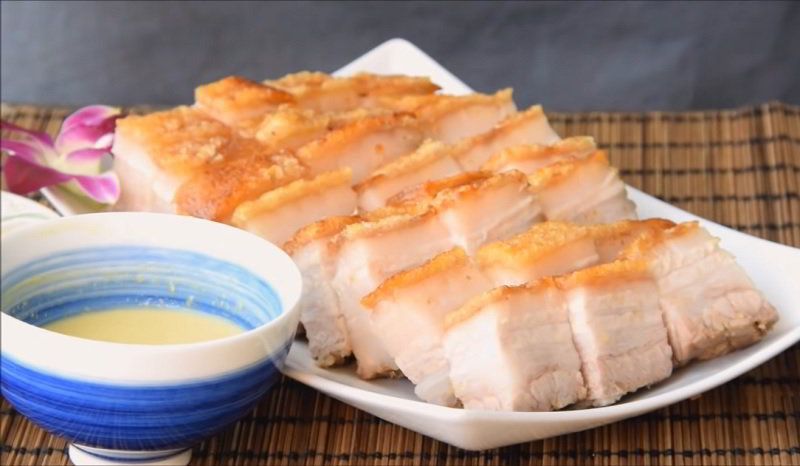
Siu yuk stands as a distinguished member of Cantonese cuisine's siu mei family, celebrated for its enticing preparation involving the roasting of an entire pig. In this culinary masterpiece, the pig is carefully seasoned with a blend of salt and vinegar before meeting the intense heat of a charcoal furnace. The result is nothing short of spectacular—crispy, golden-brown skin enveloping succulent and tender meat within. The high-quality siu yuk showcases a perfect interplay of textures, a crisp exterior yielding to juicy and flavorful meat.
Traditionally, siu yuk is served in its pure form, allowing the rich taste of the roasted pig to take center stage. Some variations may accompany this gastronomic delight with soy sauce or hoisin sauce, enhancing the overall dining experience. Siu yuk's allure lies not only in its exceptional flavor profile but also in the meticulous roasting process that transforms it into a culinary masterpiece, a testament to the artistry embedded in Cantonese siu mei traditions.
Ginger Beef
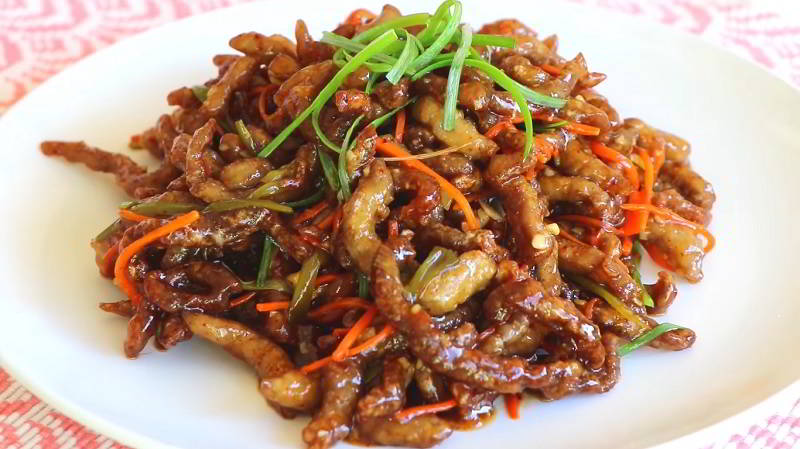
Ginger beef, a beloved Canadian Chinese creation, boasts a flavorful blend of ginger-infused beef and a unique sweet sauce that sets it apart. Its ingredients can vary based on regional influences, with the Albertan version typically featuring deep-fried beef strips enveloped in a dark, sweet sauce reminiscent of various Asian sauces rooted in vinegar and sugar. Complemented by the aromatic notes of garlic, ginger, and a touch of heat from hot peppers, this dish is often served with a garnish of julienned carrots and onions, enhancing both its visual appeal and taste. Originating from the original Geung Ngao Yuk, ginger beef has become a staple in Canadian Chinese cuisine, showcasing a delightful fusion of flavors that has garnered widespread appreciation. The dish's crispy texture, succulent beef, and distinct sauce contribute to its popularity, making it a flavorful representation of the culinary crossroads found in Canadian Chinese gastronomy.
Yi Mein
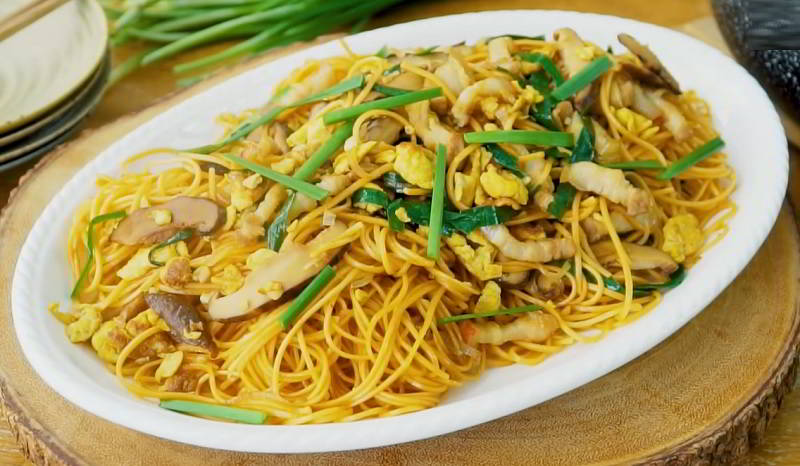
Yi mein, a cherished variety of Cantonese egg noodles, stands out with its distinctive golden-brown hue and delightful chewy texture. Crafted from wheat flour, these noodles acquire their unique characteristics through the inclusion of soda water in the dough-making process. The resulting dough is fried, forming flat, patty-like dried bricks. Often referred to as long life or longevity noodles when consumed on birthdays, yi mein carries special significance during celebratory occasions.
Traditional customs dictate that the chef refrains from cutting the noodles, emphasizing the belief that each unbroken strand symbolizes longevity and good fortune. Additionally, yi mein holds a prominent place in Lunar New Year festivities, adding a touch of cultural significance to this beloved dish. The noodles, boasting a slight chewiness and sponginess, embody the artful fusion of texture and flavor, contributing to their popularity and cultural relevance.
Poon Choi
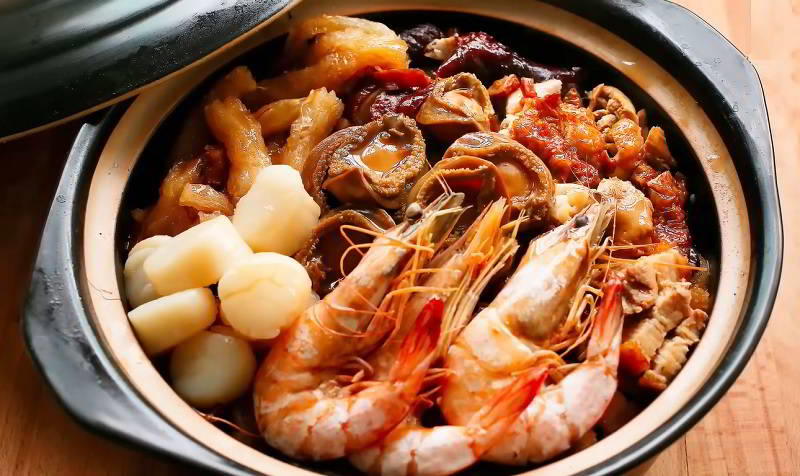
Poon choi, a revered traditional Cantonese festival banquet, unfolds as a culinary masterpiece with layers of diverse ingredients harmoniously arranged in large wooden, porcelain, or metal basins called "poon." The communal style of consumption encapsulates the essence of this grand feast.
This elaborate dish reflects the rich tapestry of Cantonese culinary tradition, showcasing a medley of flavors, textures, and aromas carefully layered within the basin. Each ingredient, thoughtfully selected, contributes to the symphony of tastes that unfold during the communal celebration. Poon choi not only serves as a feast for the palate but also as a cultural expression, embodying the spirit of togetherness and festivity deeply rooted in Cantonese heritage.
Barquillo
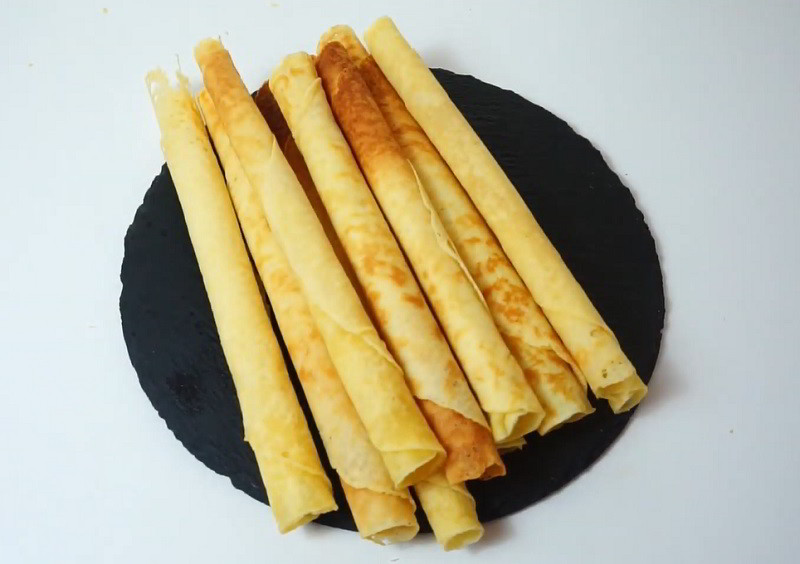
Barquillo, a delectable crispy rolled wafer pastry originating from Spain, takes shape through a blend of essential cookie ingredients – egg whites, flour, sugar, and butter. Crafted by rolling out the thin pastry and then skillfully shaping it into a hollow cylinder or cone, barquillo embodies the artistry of traditional Spanish baking.
Historically, this enticing treat was vended by barquilleros, roving roadside vendors with iconic red roulette tins, adding a touch of nostalgia to its cultural significance. Introduced during colonial times, barquillo made its way to Latin America and the Philippines, becoming a cherished part of their culinary heritage.
In Spain, barquillos are elevated to the status of Christmas cookies, symbolizing festive celebrations. Widely enjoyed during various fiestas, this delightful creation has transcended borders and become a culinary treasure in East and Southeast Asian countries, offering a crispy and sweet indulgence that bridges diverse cultures with its rich history and tempting flavors.
Fried Dace with Salted Black Beans
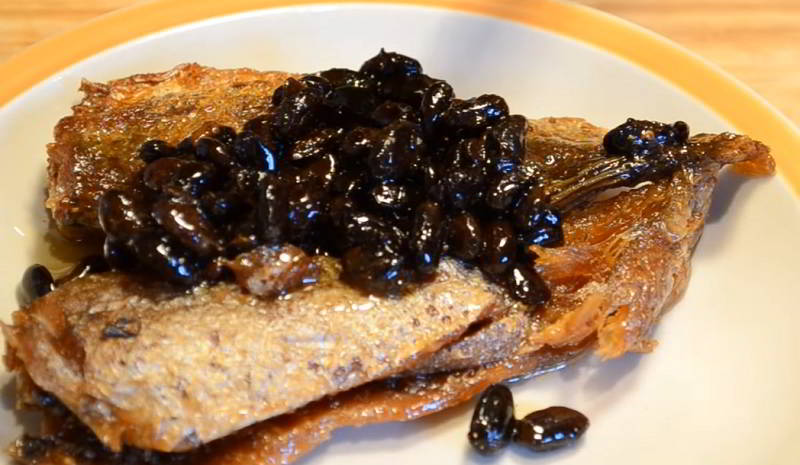
Fried dace with salted black beans, a Chinese culinary treasure, centers around Cirrhinus molitorella, commonly known as dace, sourced from the Pearl River in China. Dace, a distinctive trade name for this fish, intertwines with the rich flavors of fermented black soybeans, referred to as "dau si" in Cantonese, creating a delectable and unique gastronomic experience.
This canned delicacy is meticulously crafted by blending dace with salted black beans, and then preserving the harmonious fusion in oil. The result is a flavorful masterpiece, showcasing the inherent richness of the dace, complemented by the savory and nuanced notes of salted black beans. With a history rooted in Chinese culinary traditions, fried dace with salted black beans has become a versatile and convenient ingredient, elevating various dishes with its umami-packed profile. Whether enjoyed on its own or incorporated into diverse recipes, this culinary creation continues to captivate palates with its authentic taste and cultural significance.
White Cut Chicken
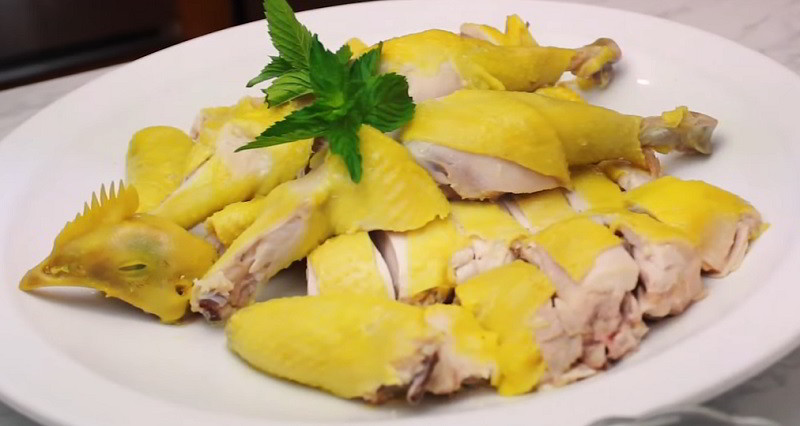
White cut chicken, also known as white sliced chicken, stands out within the siu mei repertoire as a distinctive dish, deviating from the traditional roasting method and embracing a delicate steaming process. This culinary creation finds its roots in the rich culinary traditions of Southern China, with strong influences from Guangdong, Fujian, and Hong Kong.
Contrary to the common siu mei practices, white cut chicken undergoes a gentle steaming method that imparts a uniquely tender and succulent texture to the meat. The dish transcends cultural boundaries, captivating taste buds across various regions. In Hawaii, it earns the moniker "cold ginger chicken," showcasing its adaptability and popularity.
The preparation of white cut chicken involves a meticulous balance of flavors, allowing the natural essence of the chicken to shine. Enhanced with subtle yet aromatic notes, this dish continues to hold a special place in culinary traditions, reflecting both the cultural diversity and culinary expertise that characterize Southern Chinese cuisine.
Cart Noodle
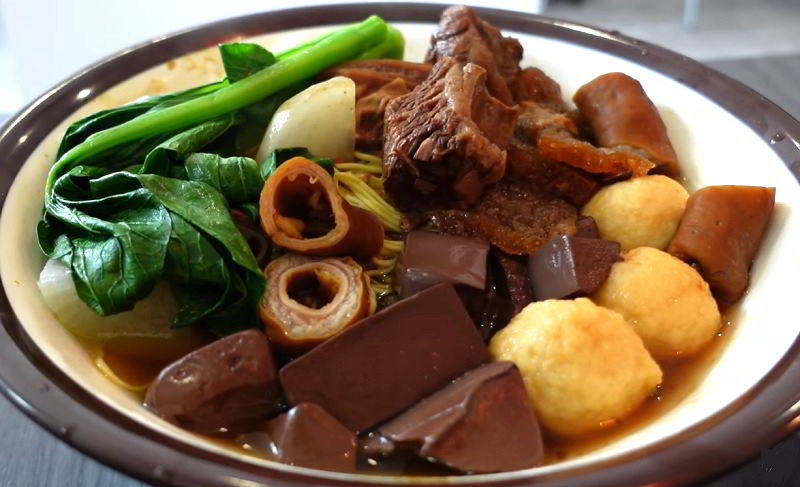
Cart Noodle, also known as daipaidong noodle, emerges as a cherished street food in Hong Kong, harking back to the traditions of noodle peddlers. This culinary gem invites a delightful exploration of flavors, allowing patrons to personalize their culinary journey. At its heart, cart noodle encompasses a bowl of impeccably prepared noodles, available in both thin and thick wheat variations.
The allure of cart noodles lies in the diverse array of toppings that adorn the noodles, presenting a feast for the senses. Options range from fried tofu and fish balls to succulent beef brisket, pork chops, and an assortment of vegetables. To further enhance the gastronomic experience, these toppings are often simmered or braised in fragrant broths, imparting richness to every bite.
What distinguishes cart noodles is the freedom for customization, empowering patrons to curate a bowl that perfectly aligns with their palate. By handpicking ingredients and toppings, individuals can relish a personalized symphony of flavors and textures, making each cart noodle encounter a uniquely satisfying culinary adventure.
Lou Mei
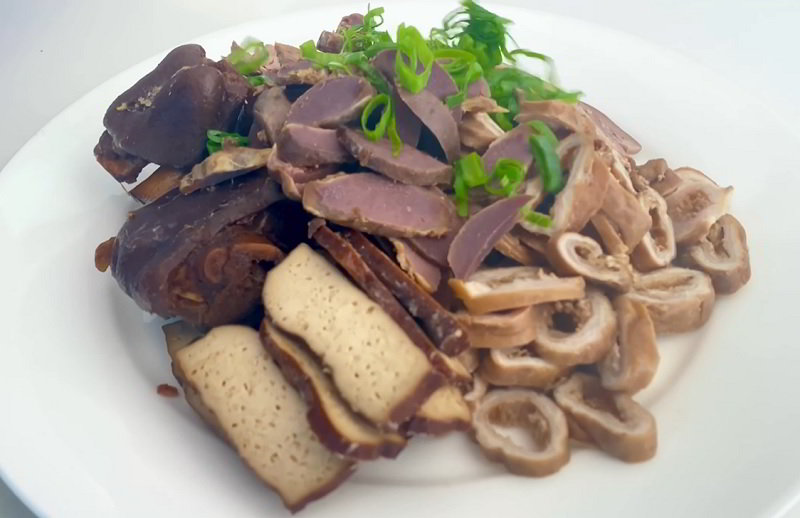
Lou mei, known as lu wei in Taiwan, encompasses a Cantonese culinary tradition that involves braising various ingredients in a flavorful sauce called a master stock or lou sauce. This culinary practice extends to Taiwan, where it is referred to as lu wei.
Featuring a diverse range of components, lou mei utilizes offal, meat, and other off-cuts to create a tantalizing array of dishes. Common variations include duck, beef, pork, chicken, and even a vegan option known as zaai lou mei, crafted from wheat gluten, prevalent in Hong Kong. Originating in Southern China, lou mei holds a significant place in Hokkien and Teochew cuisine and has expanded its influence to China and Taiwan, exhibiting numerous regional adaptations. The selection of lou mei varies widely in overseas Chinatowns, reflecting the diverse immigrant mix.
Lou mei can be enjoyed either cold or hot, with cold servings often accompanied by a side of hot braising liquid for immediate blending. Hot lou mei is typically served directly from the pot of rich and aromatic braising liquid, showcasing the depth of flavors infused during the cooking process.
Beef Ball
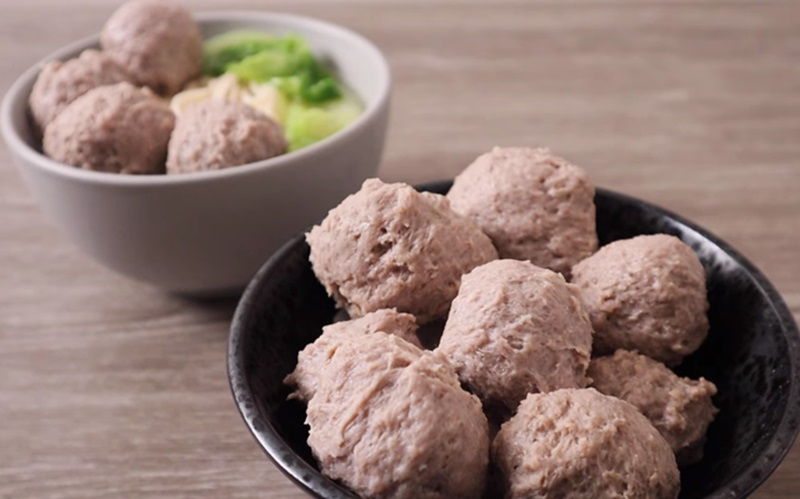
Beef balls, a culinary staple in Cantonese and overseas Chinese communities, trace their origins to the Teochew people. Crafted from pulverized beef, these meaty delights share similarities in form and preparation with fish balls but boast a distinct darker hue.
Renowned for their versatility, beef balls frequently accompany wonton noodles and other variations of fish ball noodles, gracing traditional markets and supermarket shelves alike. Beyond noodle pairings, beef balls claim their place as a favored ingredient in hot pot dishes, adding savory depth to communal dining experiences. This versatile ingredient finds widespread application within Chinese cuisine, adapting to various culinary contexts.
Whether enhancing the texture of noodle dishes or contributing to the rich flavors of hot pot creations, beef balls stand as a testament to the Teochew culinary legacy, enriching a spectrum of Chinese culinary traditions both locally and across global Chinese communities.
Malay Sponge Cake
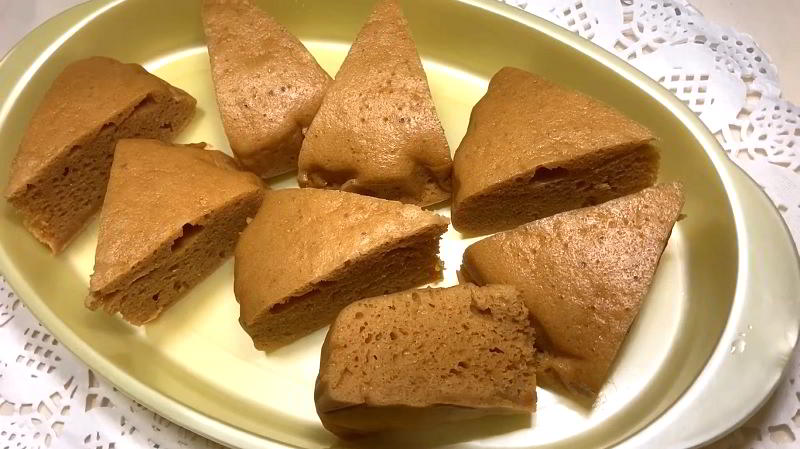
Malay sponge cake, a revered dessert in Guangdong and Hong Kong, graces traditional teahouses with its delectable presence. Crafted from a blend of flour, lard or butter, and eggs, this culinary masterpiece undergoes a transformative steaming process within a bamboo steamer to achieve its signature puffiness.
The visual allure of an entire Malay sponge cake, a grand, golden round creation, is a sight to behold. However, in teahouses, it is often presented in enticing slices, beckoning enthusiasts to savor its rich flavors. The cake's popularity has surged in Hong Kong, where it earned the distinguished title of the "national cake" according to CNN, a testament to its cultural significance and widespread appeal.
With each slice, Malay sponge cake transcends its culinary origins, becoming a cherished symbol of indulgence, tradition, and the vibrant teahouse culture that has ingrained itself into the hearts and palates of Guangdong and Hong Kong.
Seafood Birdsnest
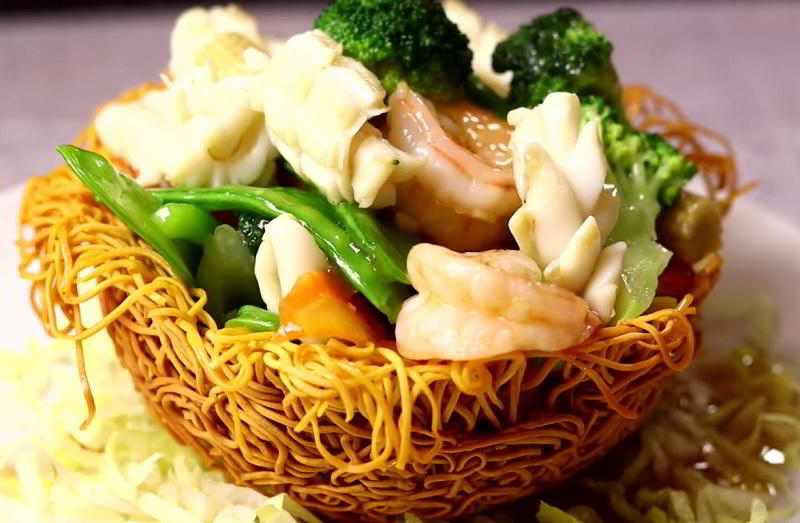
Seafood birdsnest, a prominent dish within Cantonese cuisine, graces tables in Hong Kong, China, and Chinatown restaurants across the globe. Often positioned as a mid to high-end culinary delight, its allure lies in a carefully crafted nest, presenting a visual and textural feast for discerning palates.
The nest, a masterpiece of culinary ingenuity, is meticulously fashioned from fried taro or noodles. Exhibiting intricate netting, the nest achieves a delightful balance of toughness and crunchiness, adding a layer of complexity to the dish.
Contrary to its name, Seafood birdsnest contains no bird-related elements or dried ingredients. Instead, it showcases a vibrant selection of premium seafood such as calamari, boneless fish fillet, scallops, shrimp, alongside crisp vegetables like celery sticks and peapods. This medley of flavors and textures elevates Seafood birdsnest to a culinary masterpiece, embodying the essence of Cantonese gastronomy and inviting diners into a world where artistry meets gastronomic delight.
Hong Dou Tang
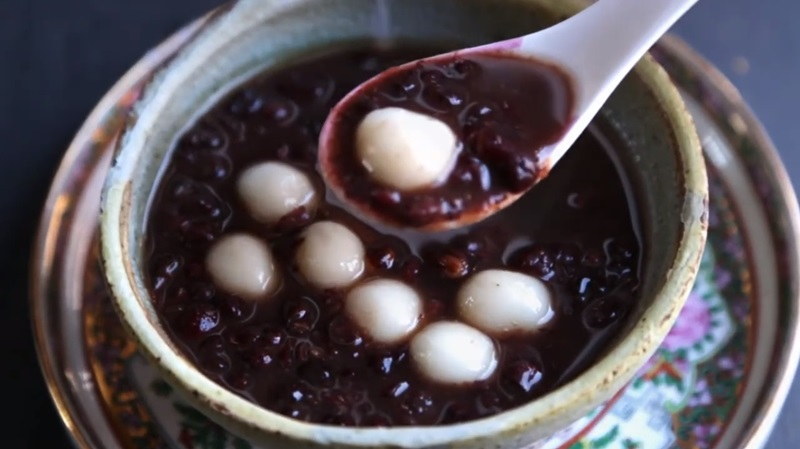
Hong dou tang, a cherished Chinese sweet soup, graces tables across Mainland China, Taiwan, Hong Kong, Macau, and various global destinations with Chinese communities. Classified as tang shui, this delightful concoction holds a versatile position, offering a refreshing chill during the summer and a comforting warmth in winter. Its appeal extends beyond the bowl, as leftover red bean soup transforms into frozen delights, crafting popular red bean ice pops that sweeten the hottest days.
In the realm of Cantonese cuisine, a distinctive red bean soup emerges, featuring sun-dried tangerine peels, rock sugar, and lotus seeds. This rendition stands out as a revered dessert, often concluding restaurant meals or banquet feasts with a touch of sweetness. Whether enjoyed steaming hot to soothe winter chills or served cold for a summertime treat, Hong dou tang weaves its way into the tapestry of Chinese culinary traditions, offering a sweet symphony of flavors that captivates taste buds across diverse occasions and seasons.
Hokkien Fried Rice

Hokkien fried rice, a beloved Cantonese-style culinary creation, has earned its place on the menu in countless Chinese restaurants. This delectable dish revolves around a vibrant interplay of textures and flavors, with a saucy stir-fried topping gracefully blanketing a bed of classic egg fried rice. The artful concoction of this topping encompasses an array of ingredients, from crisp vegetables and savory mushrooms to succulent meats, all harmoniously melded together in a dance of culinary alchemy.
Despite its name, Hokkien fried rice did not trace its origins to Fujian; rather, it emerged as an inventive masterpiece in the kitchens of Chinese restaurants in Taiwan. The dish encapsulates the essence of Taiwanese cuisine, which draws heavily from its Fujianese roots. The preparation involves a meticulous wok-frying process, where the ingredients are stirred, seasoned with a blend of oyster sauce, soy sauce, and flavorful broth, and artfully presented atop a canvas of egg-fried rice. Hokkien fried rice stands as a testament to the ingenuity of Chinese culinary traditions, delighting palates with its enticing medley of tastes and textures.
Put Chai Ko

Put chai ko, a beloved snack gracing the streets of Hong Kong, manifests as a palm-sized pudding cake that enchants taste buds with its delightful sweetness. This soft confection, though tender, maintains a firm molded shape, showcasing its culinary prowess beyond the confines of a bowl. Crafted from a blend of white or brown sugar, long-grain rice flour, and a hint of wheat starch or cornstarch, this delectable creation occasionally embraces the addition of red beans for an extra layer of flavor.
The preparation involves pouring the batter into porcelain bowls, guiding them through a steaming process until perfection is achieved. Once cooled, the cakes are presented at room temperature, offering a delightful treat for those craving a taste of Hong Kong's vibrant culinary landscape. Traditionally, hawkers utilized bamboo skewers to artfully release the cake, a practice that has evolved with time, with most Put Chai Ko now finding their way to eager consumers in convenient plastic bags, ready to be enjoyed and savored.
Dragon Tiger Phoenix

Dragon tiger phoenix, a culinary gem in Cantonese cuisine, graces the dining tables of Guangdong with its distinctive combination of three symbolic animals. This classic dish creatively incorporates snake as the representative of the dragon, cat (occasionally substituted with masked palm civet) embodying the tiger, and chicken symbolizing the majestic phoenix. The name itself conjures images of mythical creatures, and each element contributes to a harmonious blend of flavors, showcasing the culinary finesse of the region. From the dragon's allure to the tiger's strength and the phoenix's elegance, this dish not only tantalizes the taste buds but also reflects the rich symbolism embedded in traditional Cantonese culinary artistry.
Soy Sauce Chicken
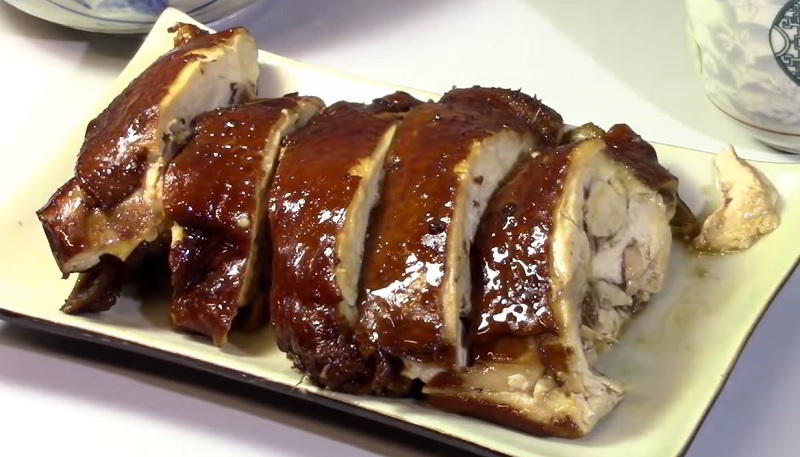
Soy sauce chicken, a classic in Cantonese cuisine, elevates the simplicity of chicken with the rich umami flavor of soy sauce. This traditional siu mei dish hails from Hong Kong, showcasing the culinary prowess of Cantonese chefs. In comparison, white cut chicken, another beloved Cantonese dish, takes a different approach, emphasizing the pure taste of the meat. Often accompanied by a savory ginger-onion paste, white cut chicken highlights the freshness of the poultry, providing a distinct dining experience. Both dishes contribute to the diverse tapestry of Cantonese culinary offerings, with soy sauce chicken presenting a flavorful and seasoned option, while white cut chicken focuses on the natural essence of the chicken itself.
Shark Fin Dumpling
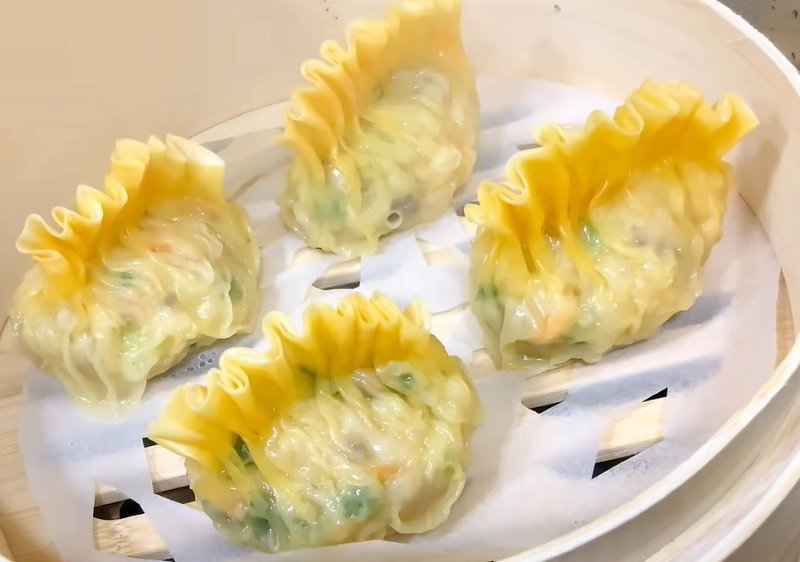
Cantonese cuisine is renowned for its exquisite flavors and delicate techniques, and one of its most celebrated dishes is the shark fin dumpling. This culinary masterpiece combines the luxuriousness of shark fin with the artistry of dumpling making. The shark fin dumpling is a delicate creation that starts with a thin and translucent dumpling skin made from a combination of wheat starch and tapioca starch. Inside this ethereal wrapper, a generous amount of shark fin is carefully folded, along with a medley of other ingredients such as minced shrimp, bamboo shoots, and water chestnuts. These ingredients are meticulously chopped and seasoned to create a harmonious blend of textures and flavors. The dumplings are then steamed to perfection, allowing the flavors to meld together while retaining their individual qualities. The result is a dish that showcases the natural sweetness of the shark fin and the freshness of the accompanying ingredients. Served in a savory broth or on their own, these shark fin dumplings are a symbol of opulence and sophistication. Each bite is a burst of umami flavors and a testament to the skill and creativity of Cantonese cuisine.
Double Skin Milk
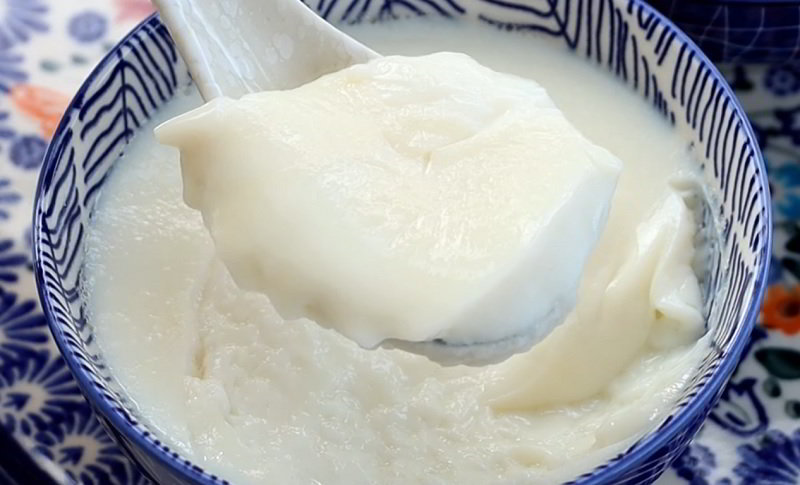
Double skin milk, an exquisite Chinese dessert with origins in Shunde, Guangdong, is a culinary delight known for its velvety smooth texture reminiscent of panna cotta. Crafted from a blend of milk, egg whites, and sugar, this delicacy boasts a unique dual-skin composition. The first skin forms during the cooling process of boiled milk, while the second emerges as the cooked custard cools. Traditionally, buffalo milk, recognized for its higher fat content, is utilized, imparting a luxurious and creamy consistency to the custard. Remarkably popular in Shunde, Macau, Guangzhou, Shenzhen, and Hong Kong, double skin milk represents a harmonious marriage of culinary craftsmanship and regional culinary preferences, offering a sensory experience that elevates it to a cherished dessert in Chinese gastronomy.
Zhaliang
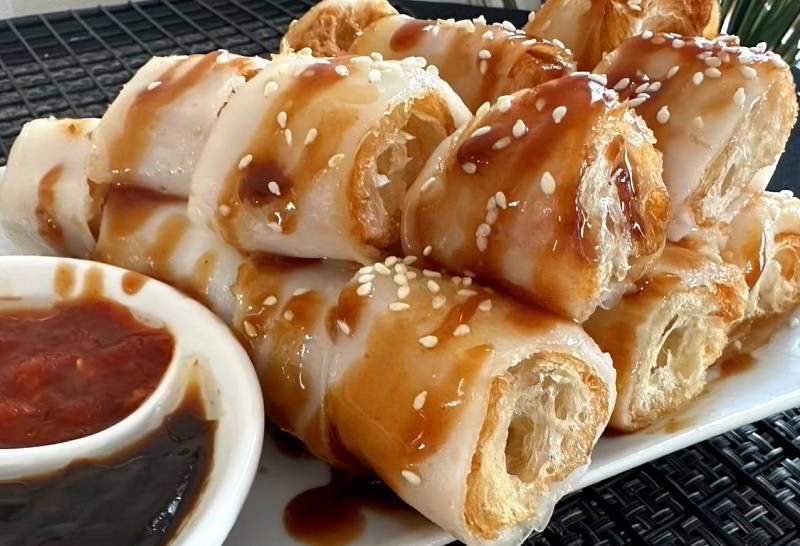
Zhaliang, also known as cha leung, stands as a delectable Cantonese dim sum that skillfully combines textures and flavors. This culinary creation features a tightly wrapped rice noodle roll embracing the crispiness of youtiao, or fried dough. Renowned in Chinese restaurants across Guangdong, Macau, Hong Kong, and Malaysia, zhaliang undergoes a delightful transformation when adorned with soy sauce, hoisin sauce, or sesame paste, culminating in a symphony of tastes. A sprinkle of sesame seeds adds a finishing touch to this dish, enhancing its visual and gustatory appeal. Typically enjoyed with soy milk or congee, zhaliang's harmonious blend of soft, chewy rice noodles and the satisfying crunch of youtiao offers a delightful experience that resonates with dim sum enthusiasts in various regions.
Taro Dumpling
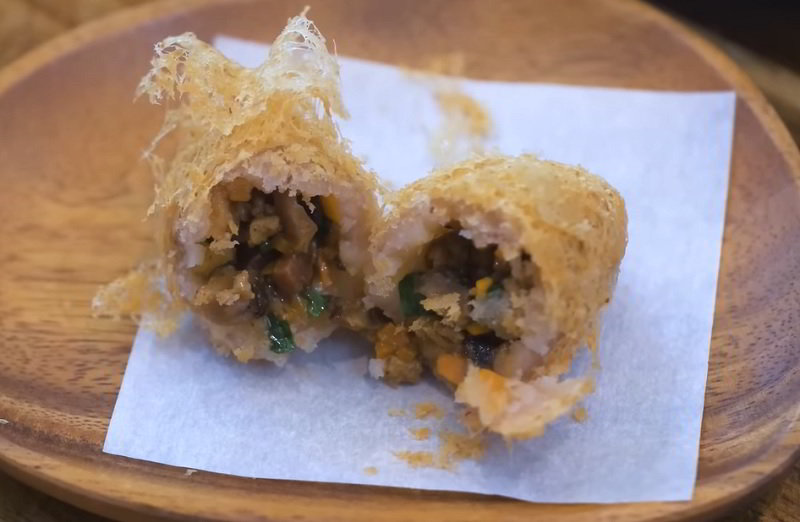
Taro dumpling, a cherished dim sum in Chinese cuisine, graces tables in Hong Kong and global dim sum establishments, earning its place as a culinary delight. Recognized by various names like taro croquette, deep-fried taro dumpling, and puff, or simply taro dumpling, it also finds its way into the offerings of Chinese pastries in overseas Chinatowns. Crafted with precision, the outer layer boasts a luscious thickness of boiled and mashed taro, creating a unique texture. Within, a flavorful blend of seasoned ground pork awaits, bringing depth to each bite. Upon deep-frying, the outer taro layer transforms into a delicate crispness, rendering the dumpling not just a feast for the palate but also a textural marvel. This tantalizing creation exemplifies the artistry of dim sum, appealing to both the connoisseurs in Hong Kong and those exploring its delights worldwide.
Mango pudding

Mango pudding, a beloved dessert deeply rooted in Hong Kong's culinary landscape, showcases a harmonious blend of British and Chinese influences. This delightful treat has transcended borders, making its mark in regions like Thailand, Singapore, Malaysia, and Macau, and earning a coveted spot on the dim sum menus of Chinese restaurants worldwide.
Prepared with meticulous care, the fresh variant features a medley of ripe mangoes, evaporated milk, agar, or gelatin, and sugar, creating a luxurious and creamy texture. It's often garnished with a burst of color from berries, strawberries, mango, or kiwifruit. Served chilled, mango pudding offers a refreshing indulgence.
Some Chinese restaurants add a whimsical touch by shaping the pudding like a fish, symbolizing good luck in Chinese culture. However, commercially produced mango pudding, while maintaining its delightful essence, might forgo fresh mangoes, incorporating mango essence, gelatin, or agar. This versatile dessert beautifully captures the fusion of flavors and cultural influences that make it a global culinary favorite.
Ham Chim Peng

Ham chim peng, a beloved deep-fried Chinese doughnut, has earned its place as a delightful breakfast treat, appreciated for its comforting flavors and diverse variations. This hollow pastry, sometimes coated in sesame seeds, holds a unique place in Southeast Asian cuisine, known as kue bantal in Indonesia and bánh tiêu in Vietnam. Offering at least three delectable versions, ham chin peng presents variations with five-spice powder, glutinous rice and red bean paste. This doughnut's appeal lies in its crispy exterior, while the diverse fillings contribute to its popularity across diverse culinary traditions. Whether savored as a quick breakfast indulgence or a delightful snack, ham chim peng seamlessly blends Chinese culinary roots with Southeast Asian flavors, making it a beloved treat with various local names in the region.
Ginger Milk Curd

Ginger milk curd, also recognized as ginger-juice milk curd, ginger milk, or ginger milk pudding, is a warm Chinese dessert with roots tracing back to Shawan Ancient Town in the Panyu District of Guangzhou, Guangdong Province, southern China. The primary components of this delectable treat are milk, ginger, and sugar, with the original recipe employing water buffalo milk.
This dessert is celebrated for its smooth and silky texture, achieved through a delicate preparation process. The milk is gently heated, and ginger juice is added, initiating a coagulation reaction that transforms the mixture into a velvety pudding. The use of water buffalo milk contributes to the dish's unique flavor profile, adding richness and depth.
Beyond its gastronomic appeal, ginger milk curd is revered for its potential health benefits, with ginger being traditionally associated with various medicinal properties. This dessert has evolved into a beloved treat, enjoyed not only for its delightful taste but also for the cultural and culinary heritage it embodies, particularly in the vibrant culinary landscape of southern China.
Snow Skin Mooncake

Snow skin mooncakes, also known as ice skin mooncakes, snowy mooncakes, or crystal mooncakes, constitute a unique Chinese delicacy traditionally savored during the Mid-Autumn Festival. Originating from Hong Kong, these non-baked mooncakes have gained popularity and are now enjoyed in various regions, including Mainland China, Macau, Singapore, Malaysia, Taiwan, and Indonesia.
Distinguished by their preparation method, snow skin mooncakes diverge from traditional counterparts as they are not baked in ovens. Unlike room-temperature traditional mooncakes, these delicacies are typically relished when cold. The concept of snow skin mooncakes materialized in the 1960s, pioneered by a Hong Kong bakery. The innovation was prompted by a desire to address concerns about the high sugar and oil content in traditional Cantonese mooncakes, which featured salted duck egg yolks and lotus seed paste. To create a lighter alternative, the bakery opted for fruit fillings and reduced oil content, resulting in a mooncake with less fat, catering to the preferences of health-conscious customers.
White Sugar Sponge Cake
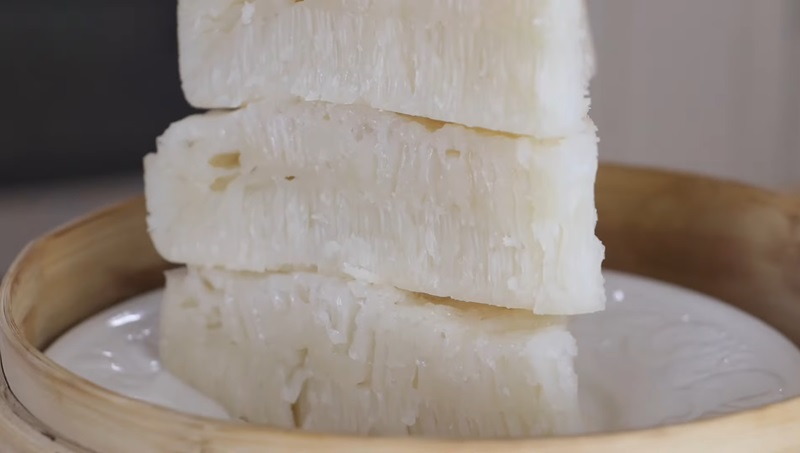
White sugar sponge cake, also known as Known as Baak Tong Gou in Cantonese cuisine, a distinctive Chinese pastry, is crafted from a blend of white sugar, water, rice flour, and a leavening agent. Despite its nomenclature, this "cake" is not presented in the traditional round form but is commonly found as individual square or mini-triangle pieces. Characterized by its snowy white appearance, the cake boasts a spongy and soft texture, delivering a sweet flavor profile with a subtle hint of sourness resulting from the batter's fermentation before cooking.
Typically steamed in the Chinese culinary tradition, this cooking method imparts a moist, fluffy consistency to the cake, in stark contrast to dry and firm alternatives. To preserve its moistness, the cake is often kept covered, preventing it from hardening when exposed to air. Best enjoyed when served hot, the cake's texture remains soft and moist, offering a delightful sensory experience.
Cantonese Seafood Soup
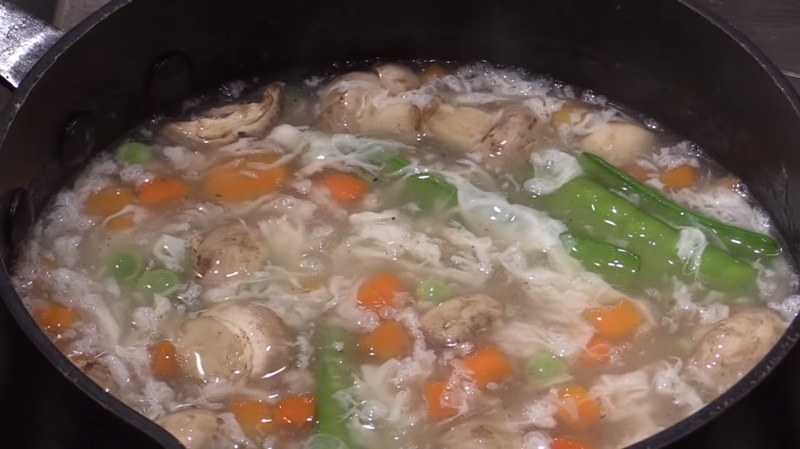
Cantonese seafood soup, a prominent dish within Cantonese cuisine, is a culinary gem often savored in Hong Kong and other Chinatowns worldwide. This soup stands out as a midrange to high-end delicacy, with the price varying based on the quality of its ingredients.
Renowned for its luxurious texture, the soup boasts a thick and velvety consistency achieved through the meticulous use of starch as a thickening agent. With a distinctive whitish hue and a hint of transparency, the soup exudes an elegant appeal. The nomenclature, referring to it as "gung," deviates from the standard Chinese term for soup, underscoring its Southern Chinese origin.
Cantonese seafood soup encapsulates the essence of fine dining, presenting a harmonious blend of flavors and textures. As a culinary masterpiece, it continues to captivate palates with its sophisticated profile, making it a sought-after choice for those seeking a refined and indulgent dining experience.
Ox-tongue Pastry

Ox-tongue pastry, also known as horse-ear pastry or Chinese doughnut, is a beloved Chinese delicacy hailing from the southern provinces of Guangdong and Fujian. Resembling an elliptical shape similar to a horse's ear or ox tongue, this fried dough treat boasts a distinctive texture—chewy on the inside with a satisfyingly crunchy crust. Lightly sweetened, the pastry is a delightful addition to breakfast when paired with soy milk. Crafted using a method similar to that of Youtiao, the addition of sugar to the flour enhances its flavor profile, creating a unique culinary experience. The ox-tongue pastry's popularity is rooted in its harmonious blend of textures and flavors, making it a cherished part of breakfast traditions in southern China.
Swiss Wing
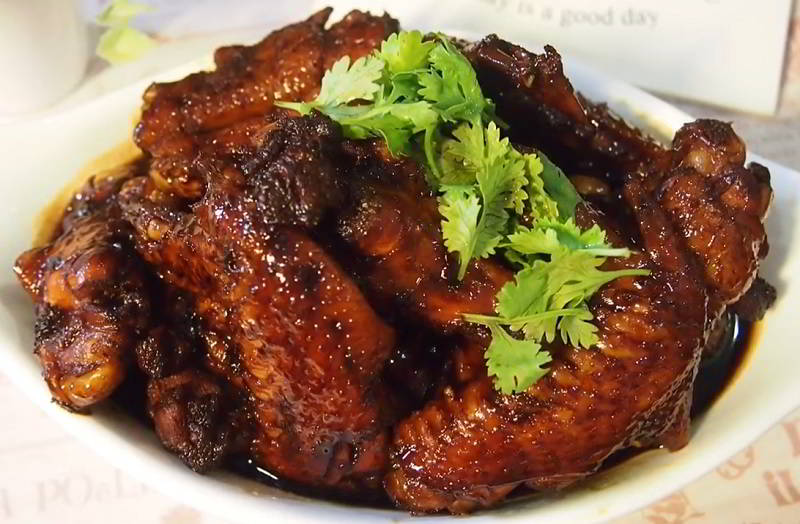
Swiss wings, a delectable dish served in select restaurants in Hong Kong, are chicken wings marinated in a savory sauce featuring a delightful blend of sweet soy sauce, Chinese wine, soy sauce, and aromatic spices. Despite the name "Swiss," this flavorful culinary creation has no connection to Switzerland, with its roots believed to trace back to Hong Kong or Guangzhou.
The marinade imparts a rich and complex taste to the chicken wings, creating a harmonious balance of sweet and savory notes. The dish showcases the influence of Cantonese cuisine, where intricate flavor profiles and careful preparation play a significant role. Swiss wings have become a popular choice among those seeking a unique and satisfying dining experience in the vibrant culinary landscape of Hong Kong, offering a delightful fusion of flavors that reflects the region's culinary creativity.
Malatang
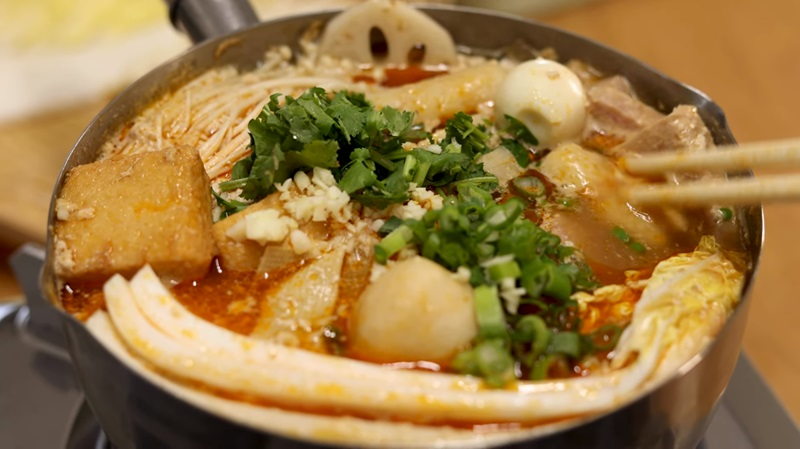
Malatang, a popular Chinese street food, traces its origins to Sichuan, China, although it diverges notably from the Sichuanese version, resembling more closely what Northern China recognizes as hot pot.
The dish takes its name from its central component, mala sauce, distinguished by a blend of Sichuan pepper and dried chili pepper. Unlike the traditional Sichuanese counterpart, malatang ventures into a distinct culinary realm, showcasing a unique interplay of flavors and textures.
Heralded by its piquant and numbing sensations, the mala sauce elevates malatang to a delightful and spicy experience, resonating with food enthusiasts across China. As a common sight in street food markets, malatang captures the essence of regional variations, serving as a testament to the culinary diversity that defines Chinese street gastronomy.
Shengjian Mantou
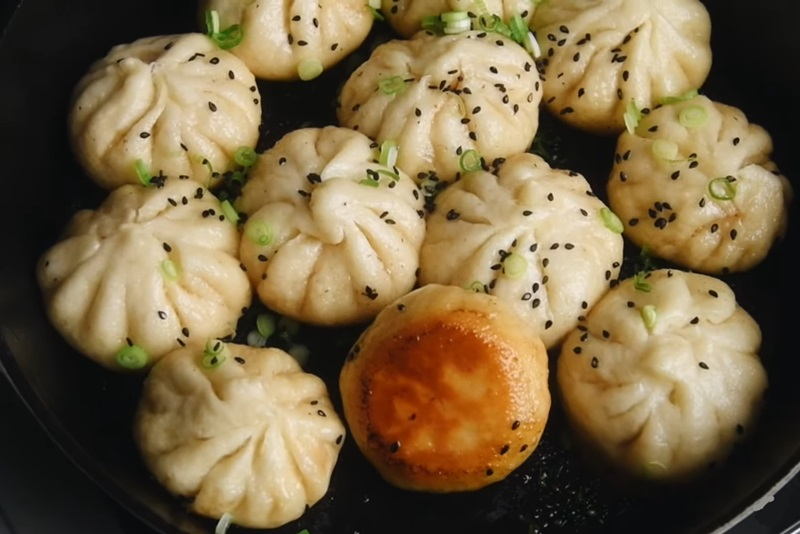
Shengjian mantou, a culinary gem hailing from Suzhou and Shanghai, epitomizes the art of small, pan-fried baozi, enriching the breakfast tables of China's Yangtze River Delta. These delectable morsels, distinguished by their filled, pork-laden interiors and gelatinous soup core, showcase culinary ingenuity.
In Shanghai, shengjian mantou exhibits a thin, crispy skin, while variants elsewhere may feature a thicker, bread-like exterior. Originating in Suzhou at the dawn of the 20th century, this savory creation swiftly captivated palates, its popularity radiating across the Yangtze River Delta. Since the early 1920s, shengjian mantou has claimed its place as a quintessential breakfast item in Shanghai, becoming a culinary icon embedded in the rich tapestry of Shanghai cuisine.
With each bite, these pan-fried baozi encapsulate not just a flavor, but a culinary legacy that has stood the test of time, affirming its significance in shaping the gastronomic landscape of the region.
Longevity Peach
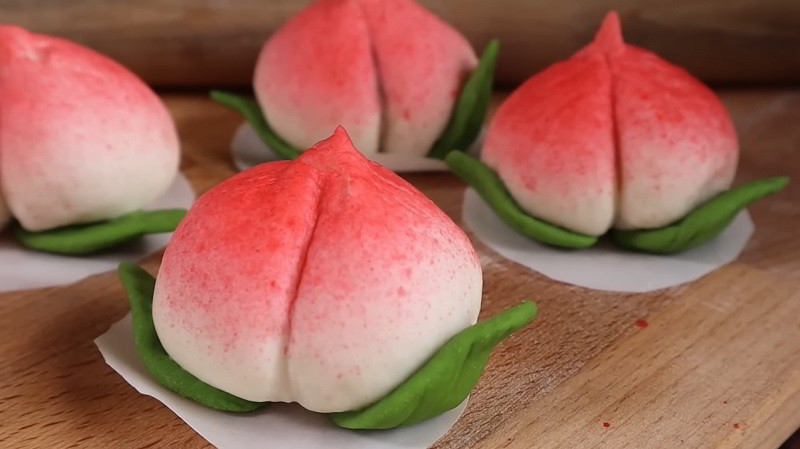
A longevity peach, known as shoutao, is a lotus seed bun characterized by its white exterior, red-dyed tip, and a crease along the side, cleverly designed to resemble a peach. Some variations may feature fillings such as lotus paste or red bean paste, enhancing the overall taste and texture. Occasionally, green decorations resembling leaves are added for visual appeal. This delectable treat holds symbolic significance as it represents the mythical Peaches of Immortality from Chinese folklore. Legend has it that these peaches ripen once every thousand years, bestowing immortality upon those who consume them.
Traditionally, the longevity peach pastry is served during the birthdays of elderly individuals as a gesture of celebration for their remarkable achievement of reaching old age. Beyond its delicious taste, the longevity peach carries cultural and symbolic importance, linking it to the wish for longevity and well-being for those who enjoy it during special occasions.
Lai fun
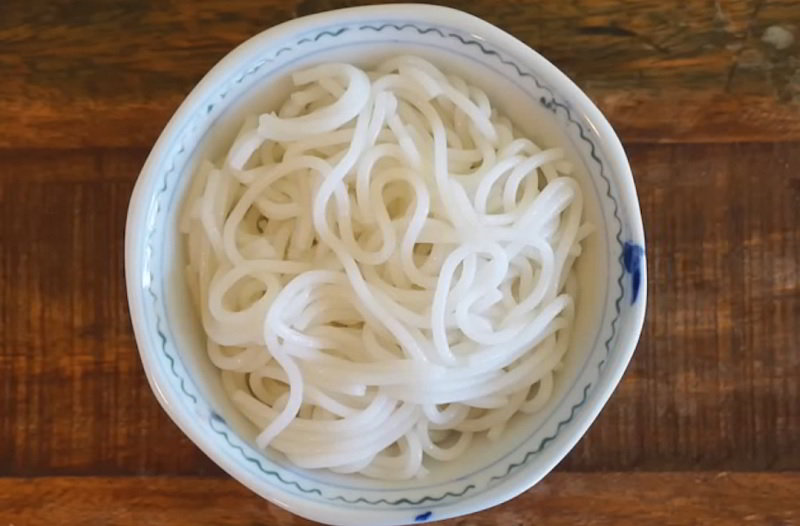
Fried milk
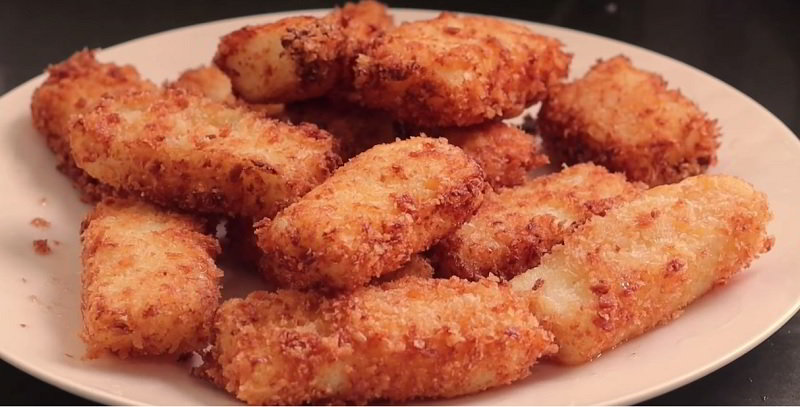
Youmian
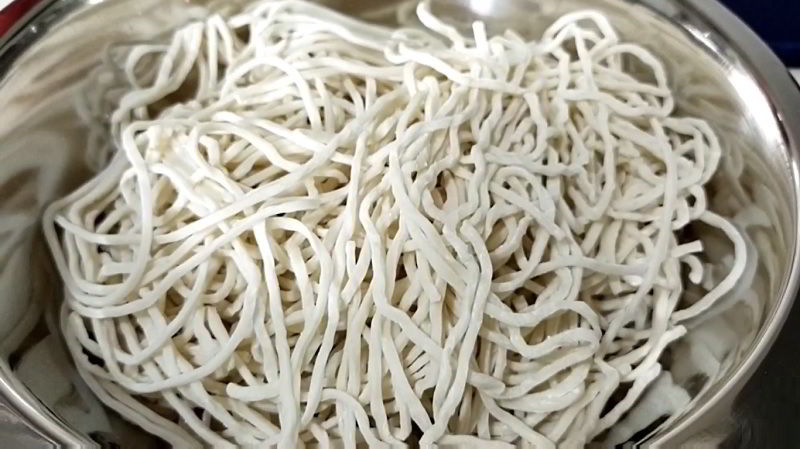
Taro cake
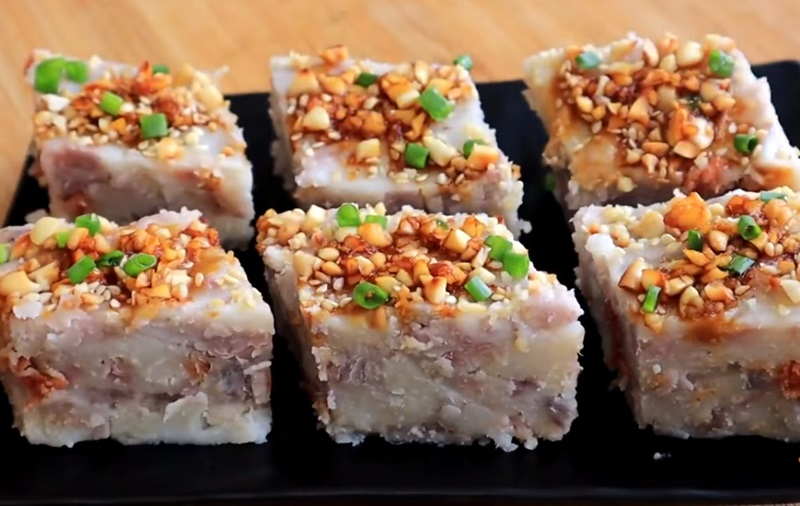
Water chestnut cake

Tofu skin roll
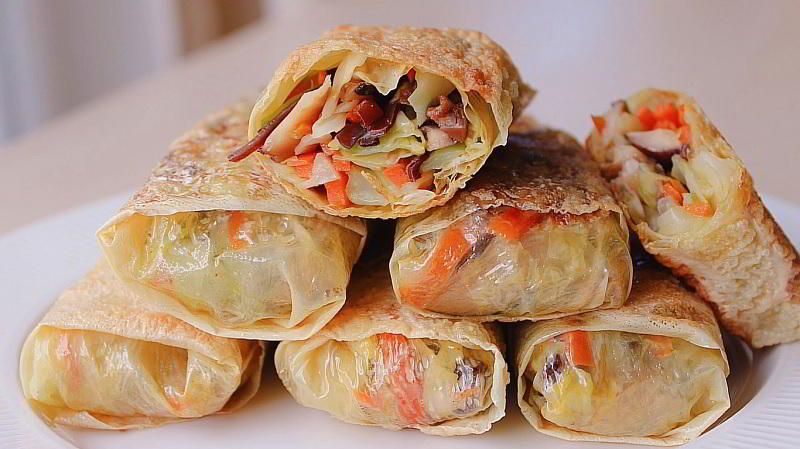
Pork chop bun

Beer in Hong Kong
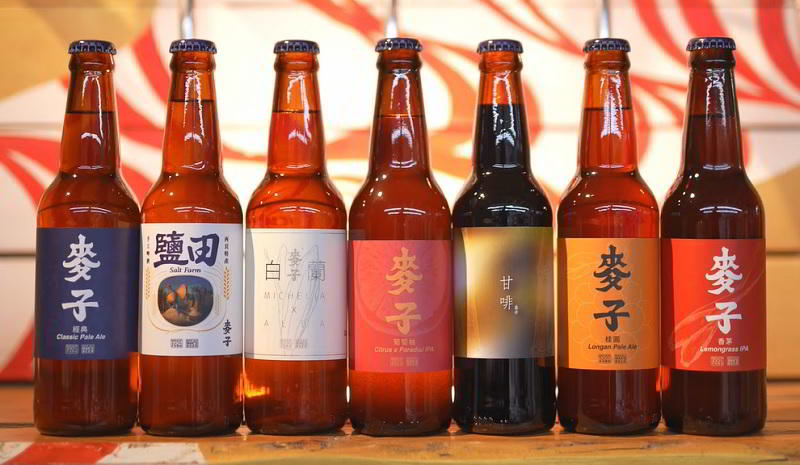
Black bean paste
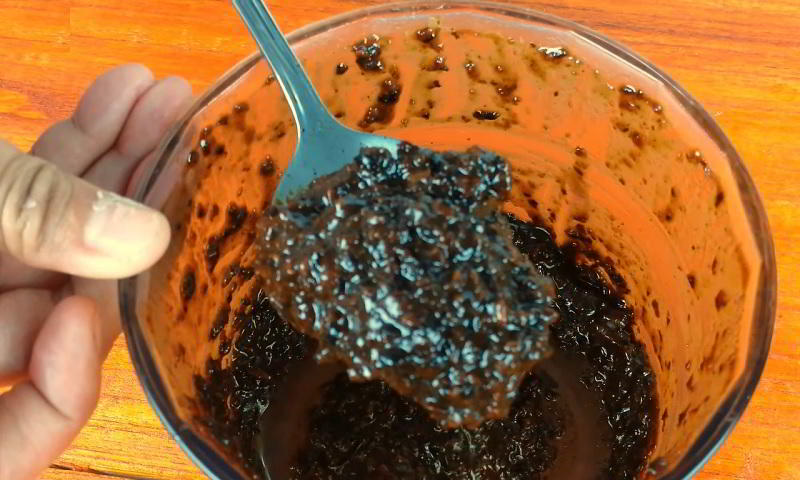
French roll
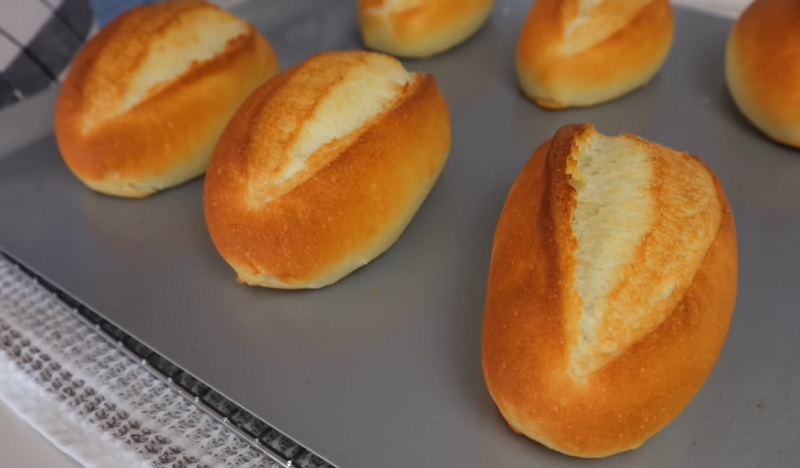
Lo mai chi
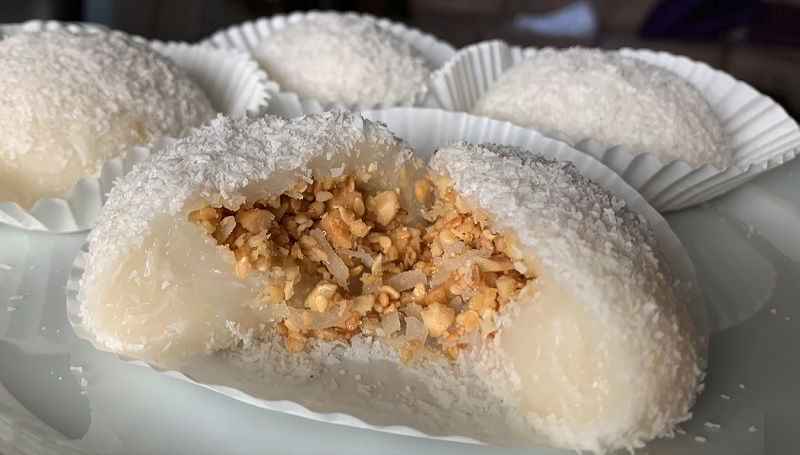
Shrimp roe noodles
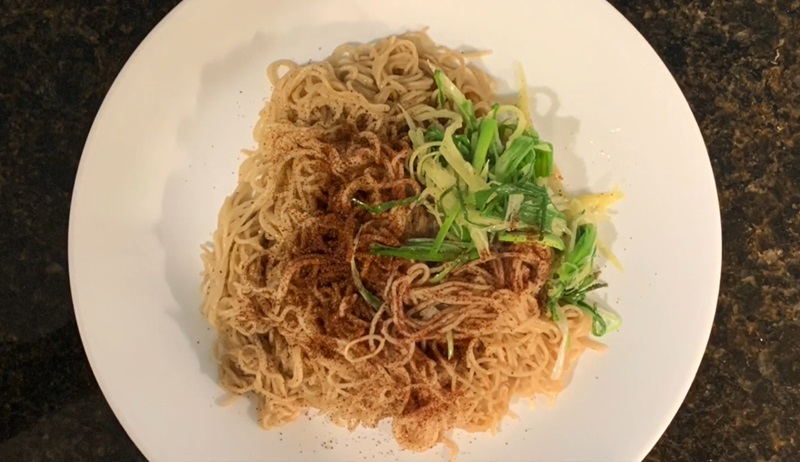
Portuguese sauce
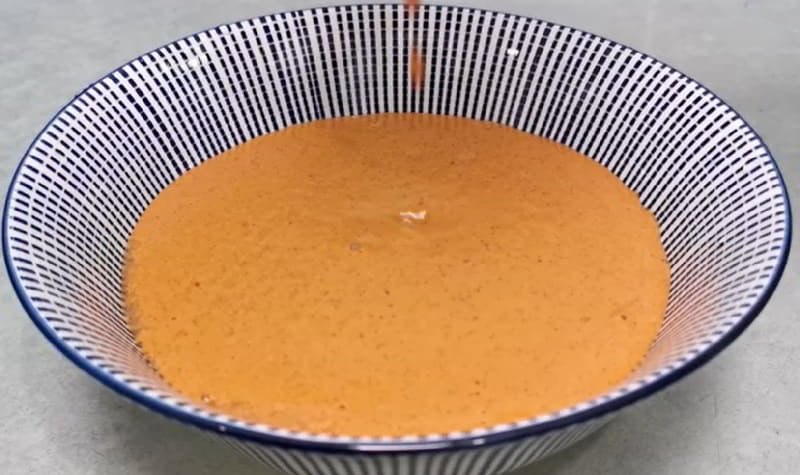
Oil noodles
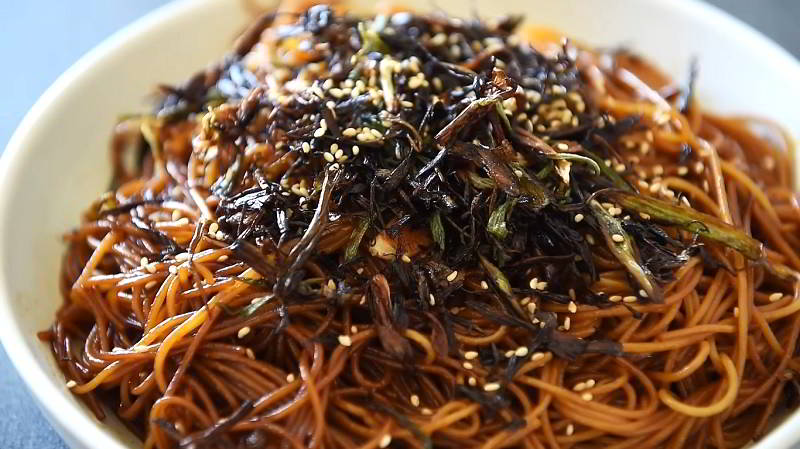
Galinha à portuguesa
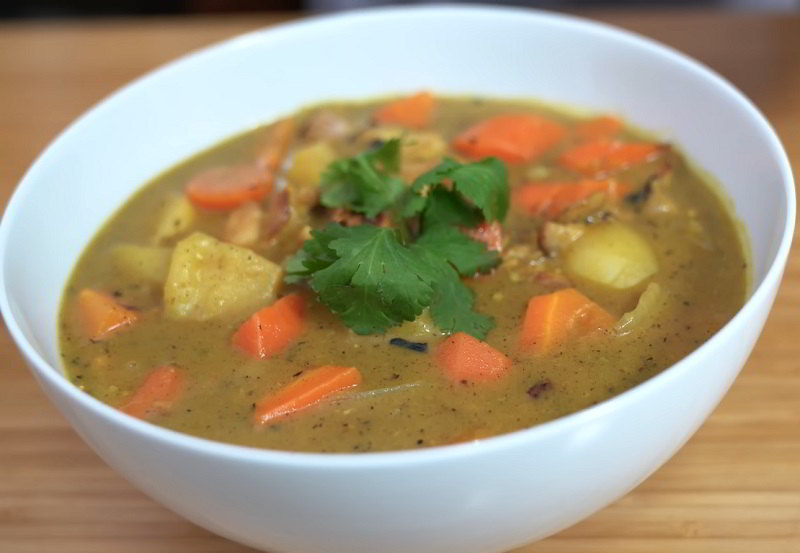
Banana roll
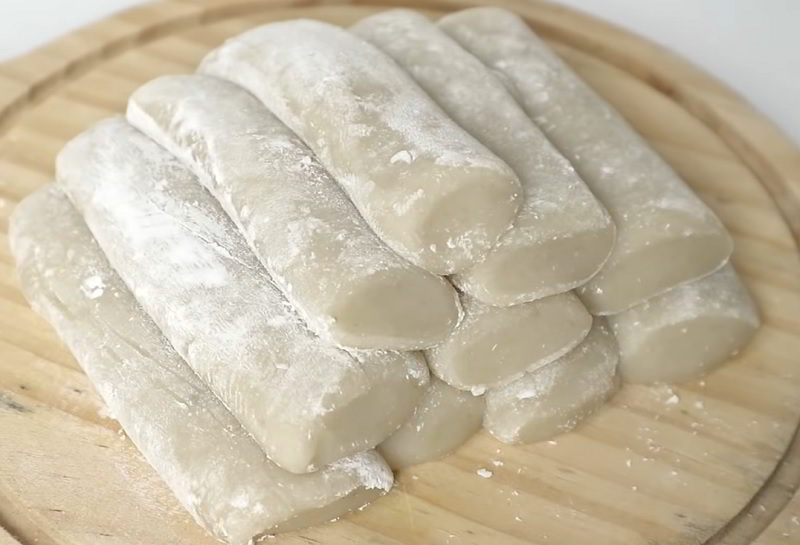
Yau gok

Lotus seed bun
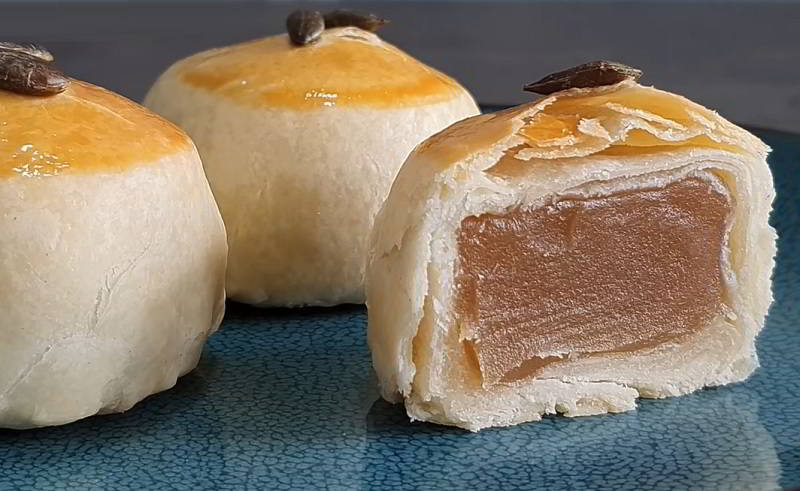
Red bean ice

Bing sutt

Mak's Noodle
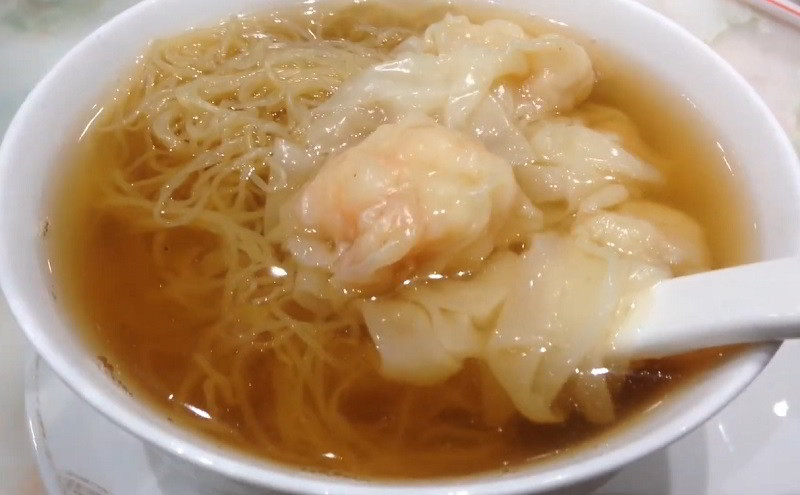
The Chinese Feast

Pork knuckles and ginger stew
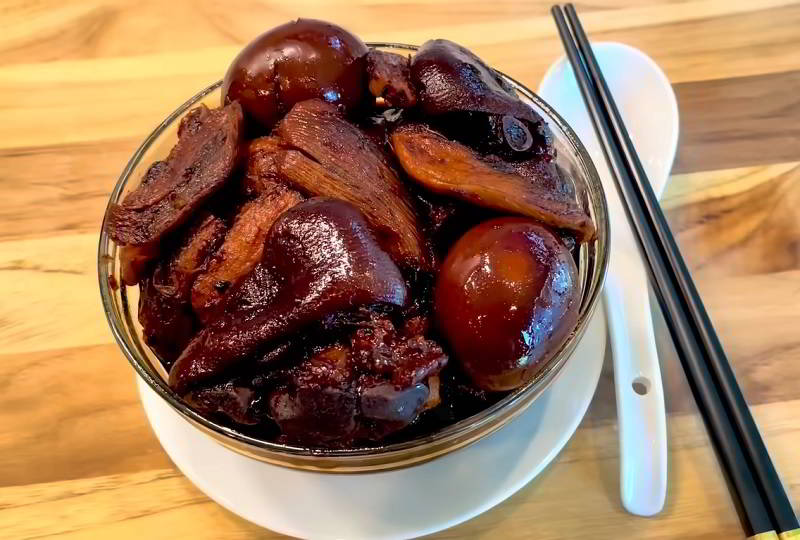
Ngau zap
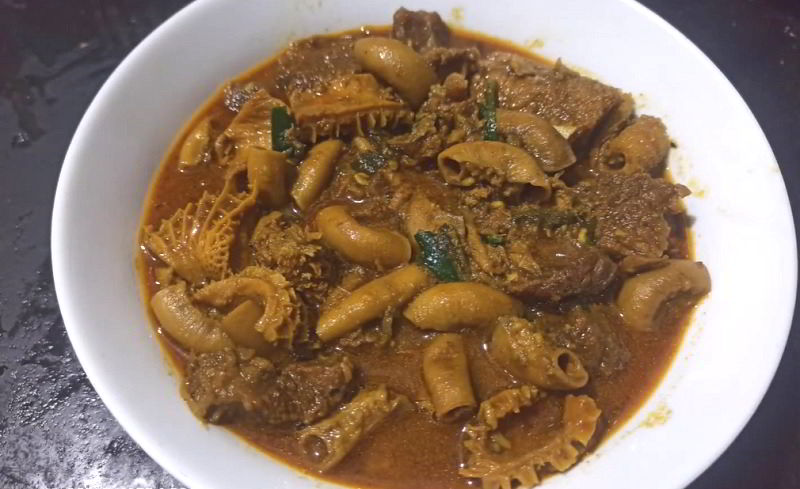
Ham and egg bun
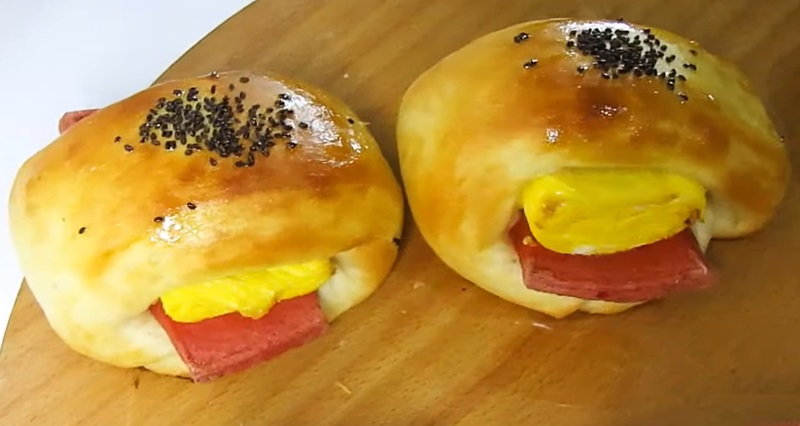
Vita (brand)

Minchee
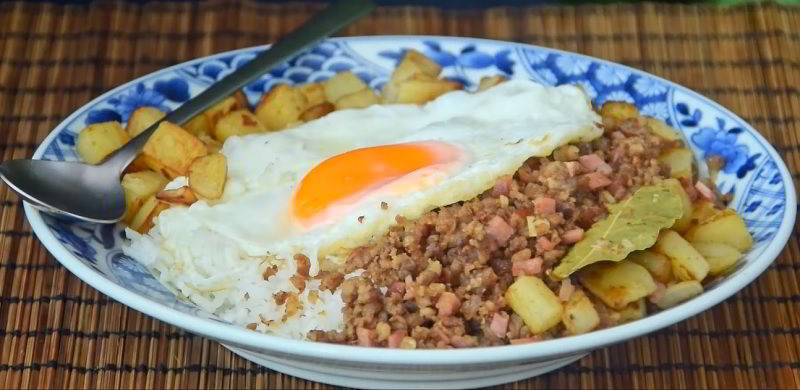
Bakpau
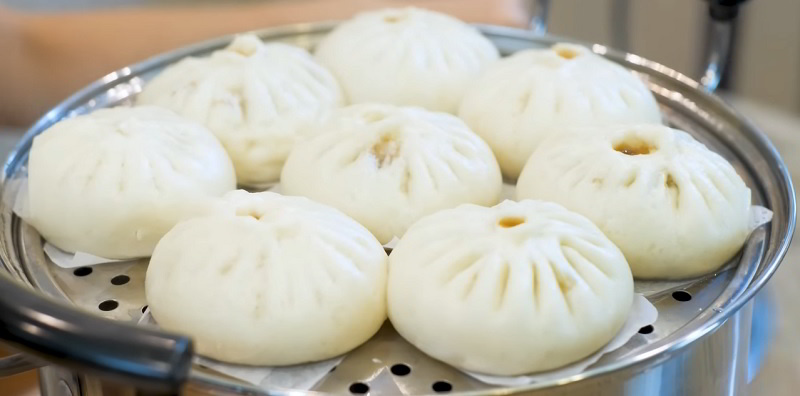
Coconut bar
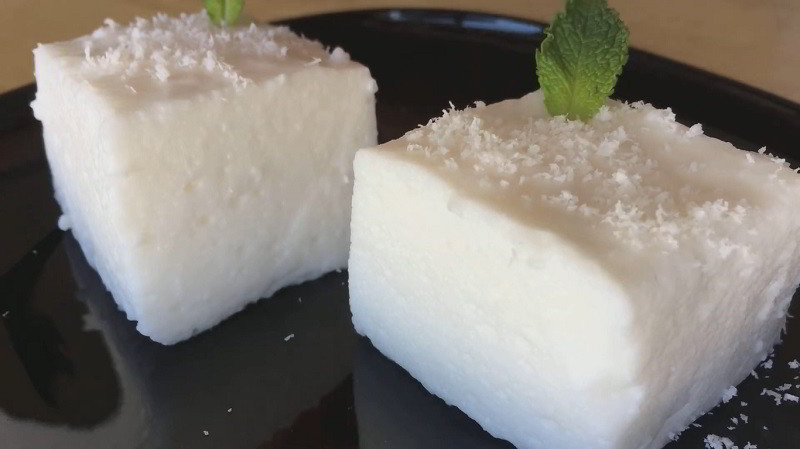
Deuk Deuk Tong
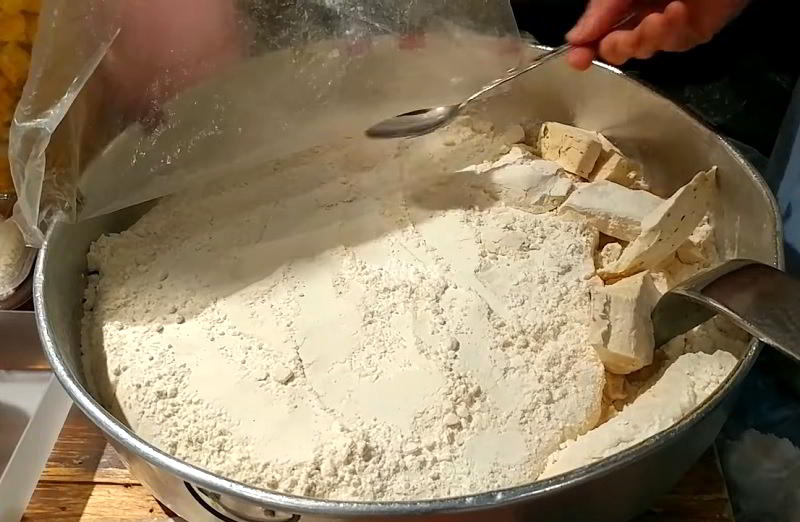
Yin yang fried rice
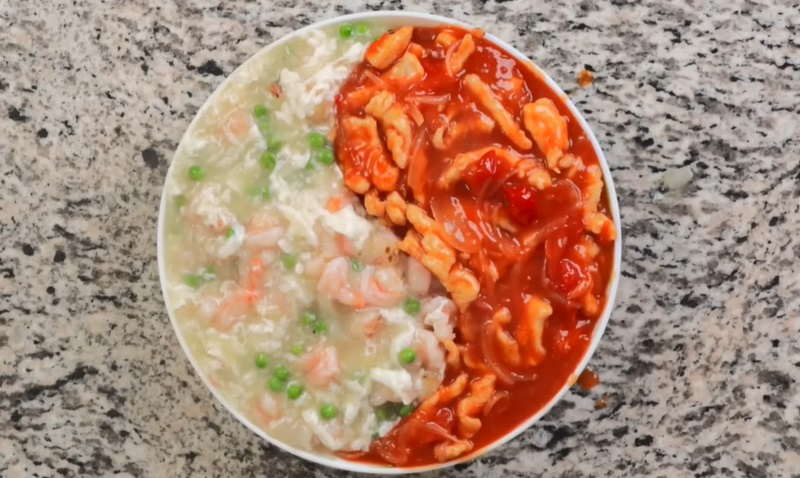
Da Bao
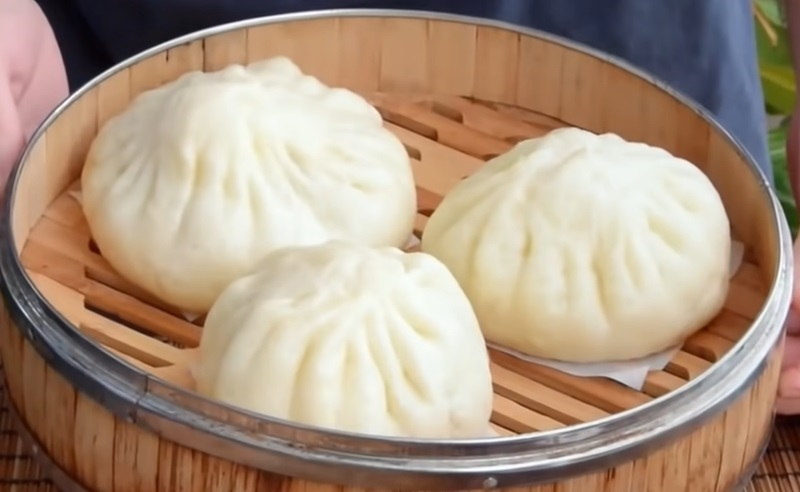
Eight treasure duck
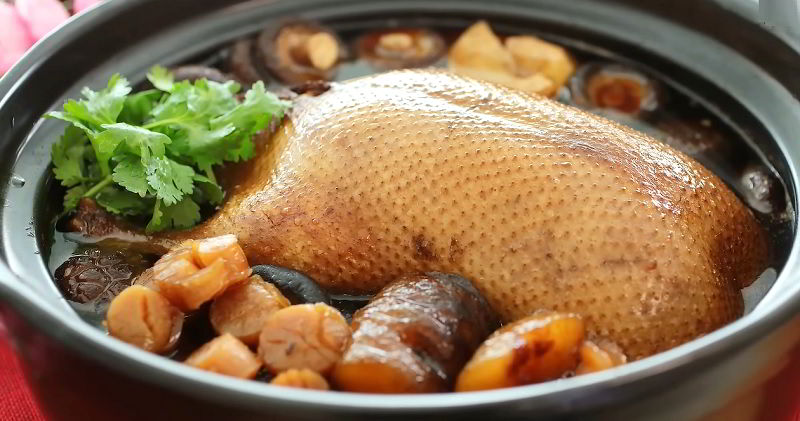
Steamed meatball
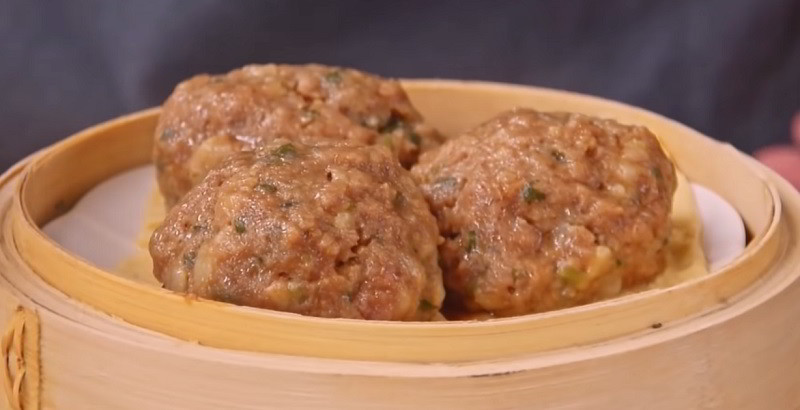
Chinese flaky pastry

Orange cuttlefish
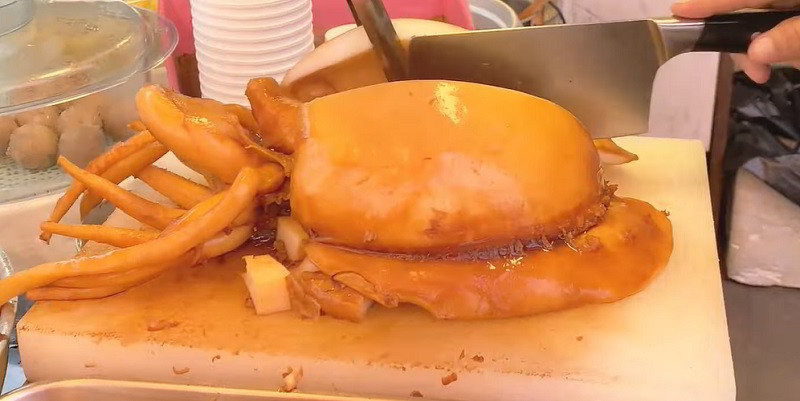
Paper wrapped cake
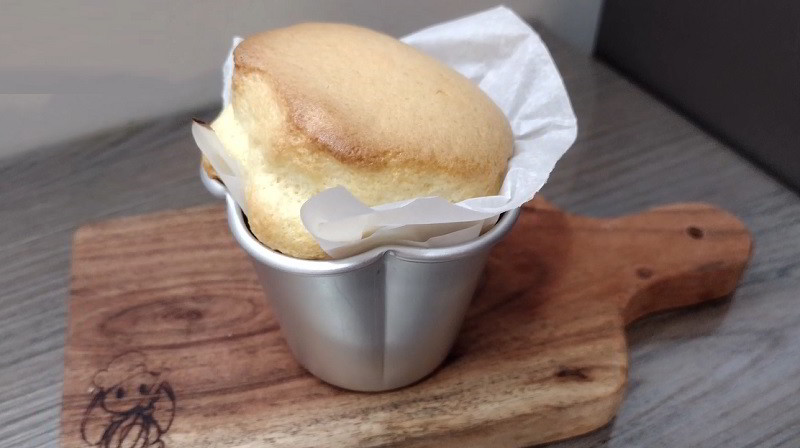
Galinha à africana
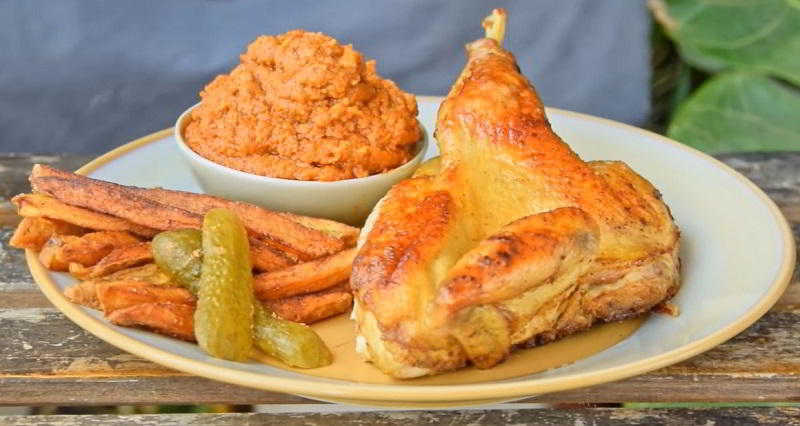
Honey walnut shrimp

Beef bun
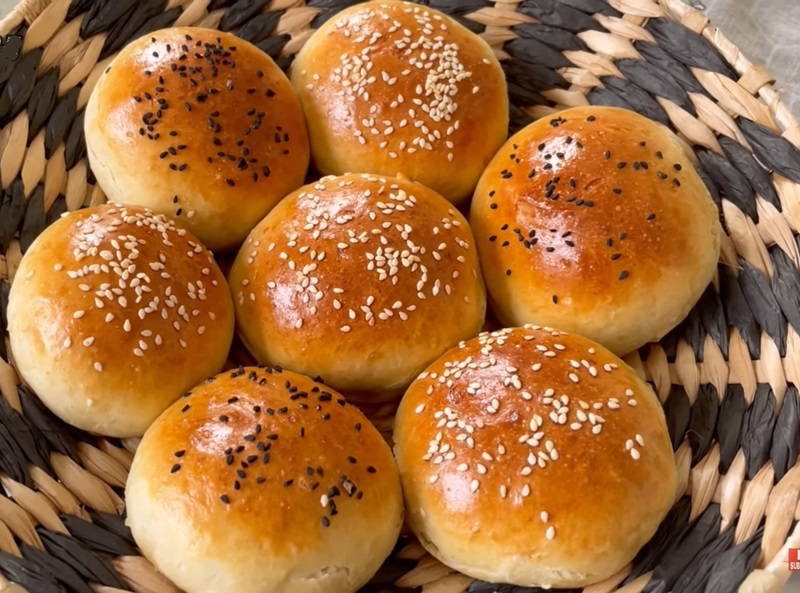
Red bean cake
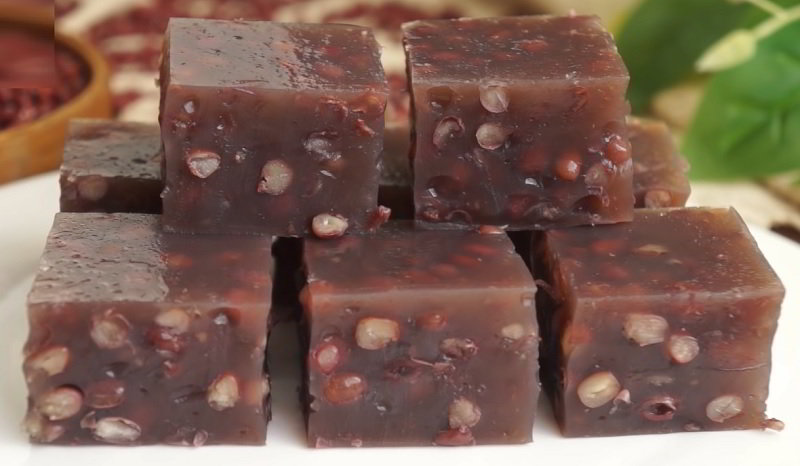
One bowl with two pieces

Curry beef turnover
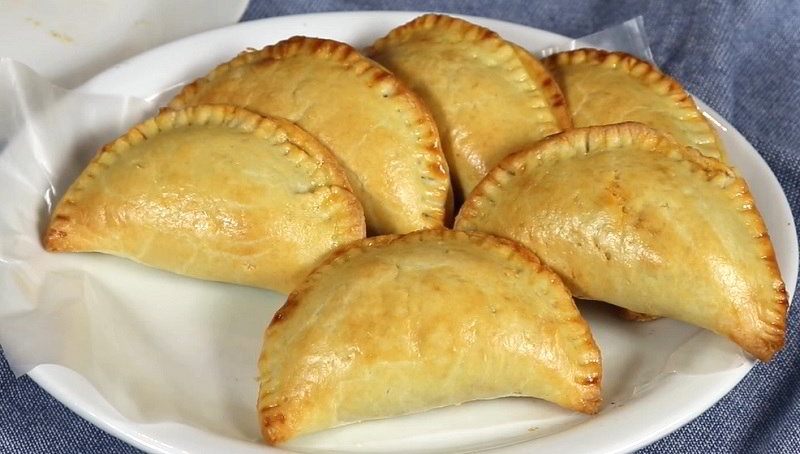
Crab in oyster sauce
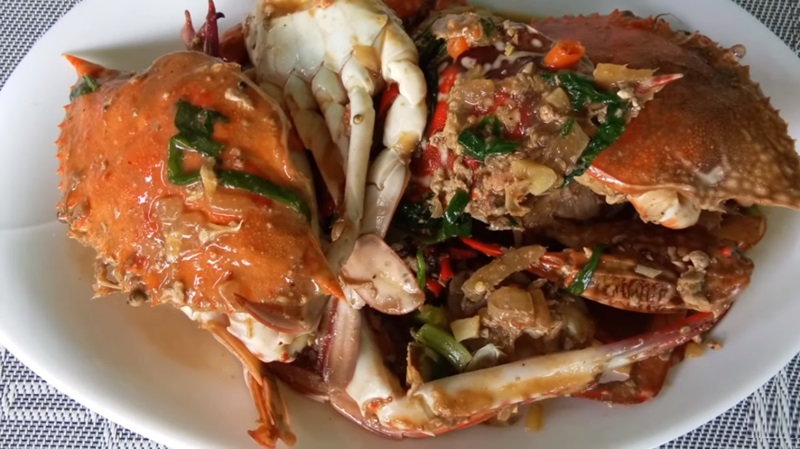
Steam minced pork
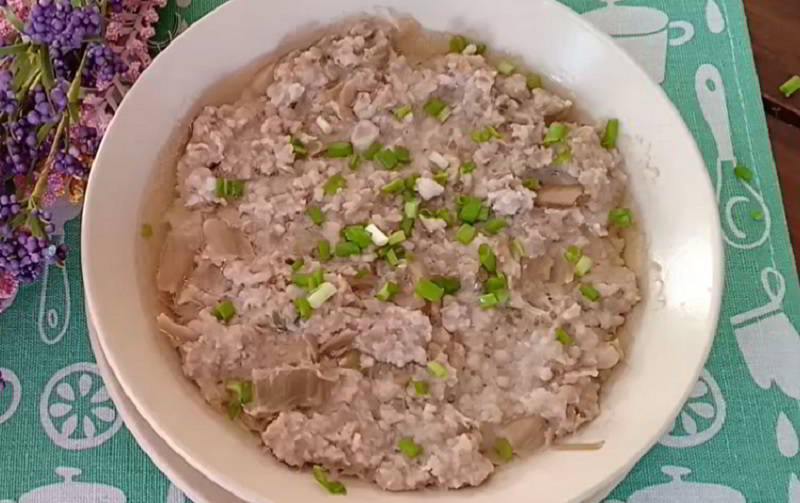
Mobile Softee

Yam ring
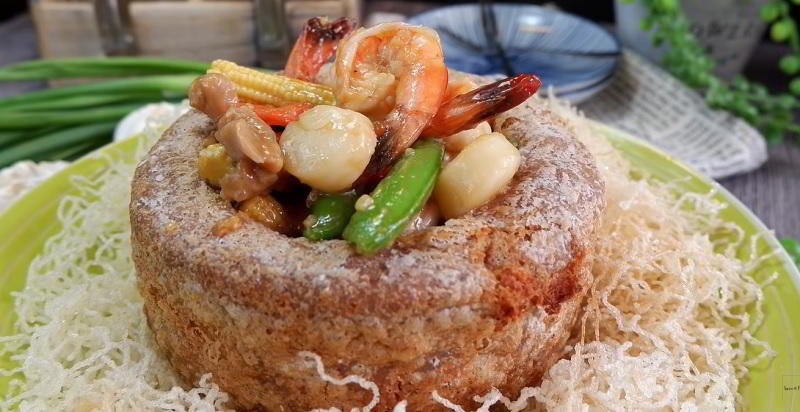
Sou (pastry)
-1709102322.jpg)
Xiabu Xiabu

Three Fried Stuffed Treasures
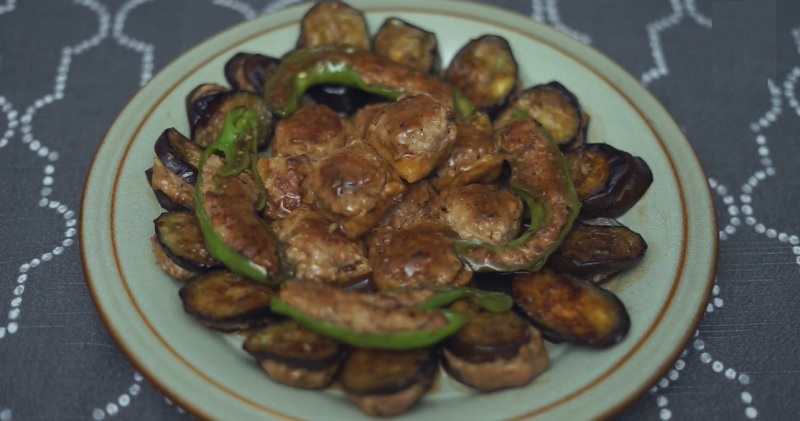
Black sesame roll
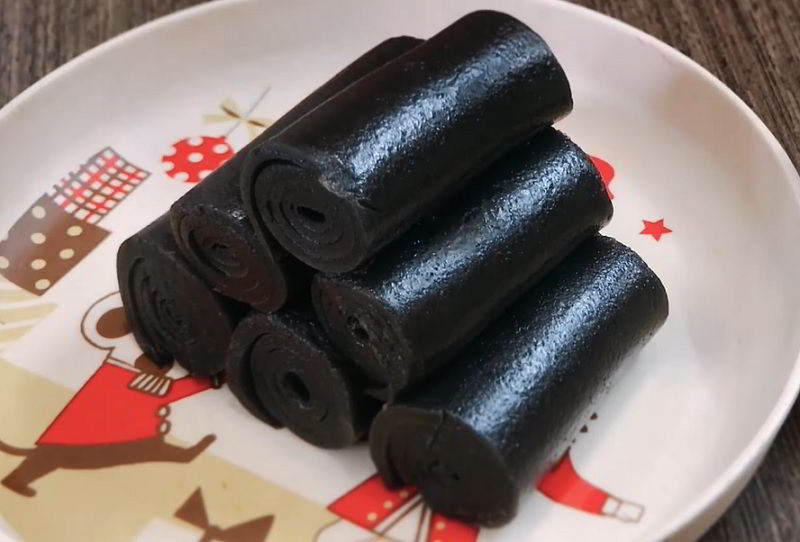
Snake bite chicken

Almond pressed duck

Saang mein
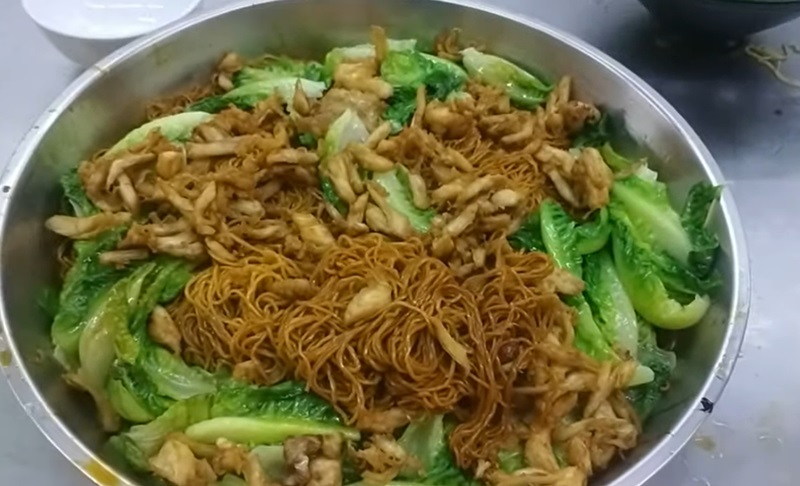
White boiled shrimp
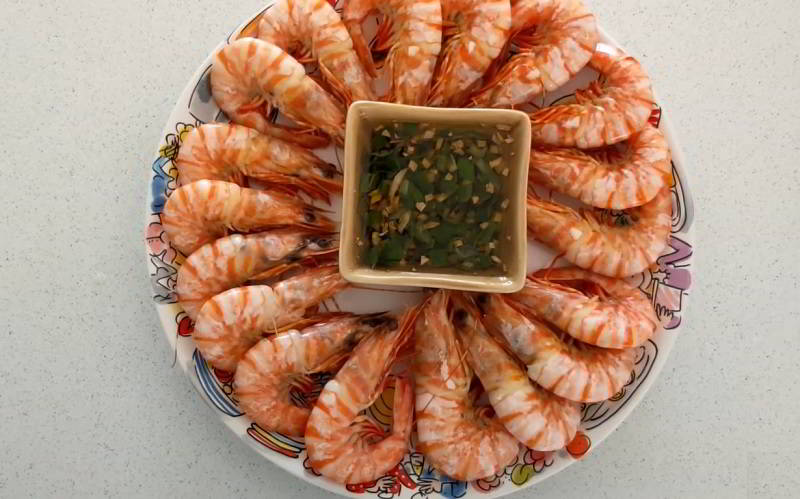
Shogun and Little Kitchen

Huangqiao sesame cake
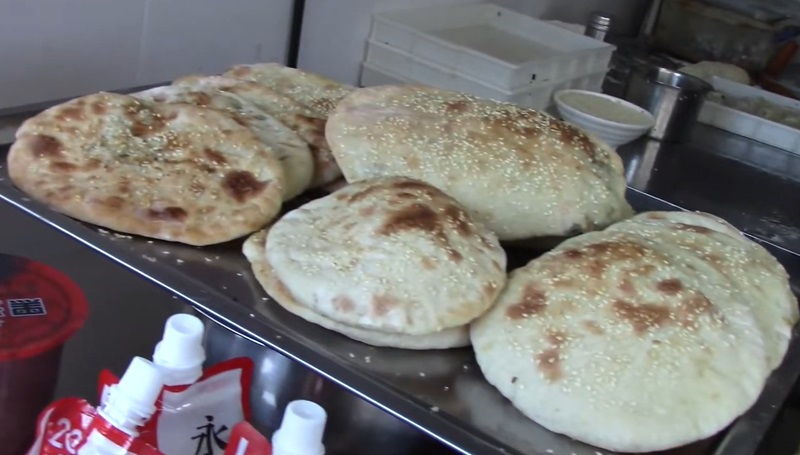
Daa Laang

Tacho (food)
-1709118709.jpg)
Herbal tea shop

Maltose crackers

Traditional candies in Hong Kong
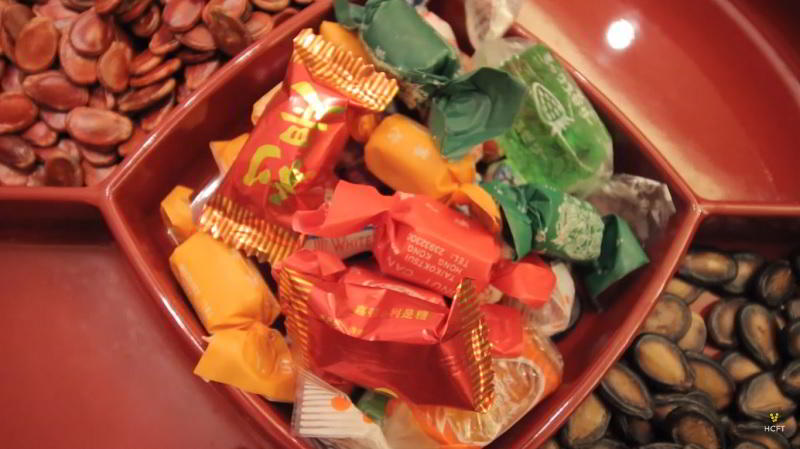
Lou fo tong
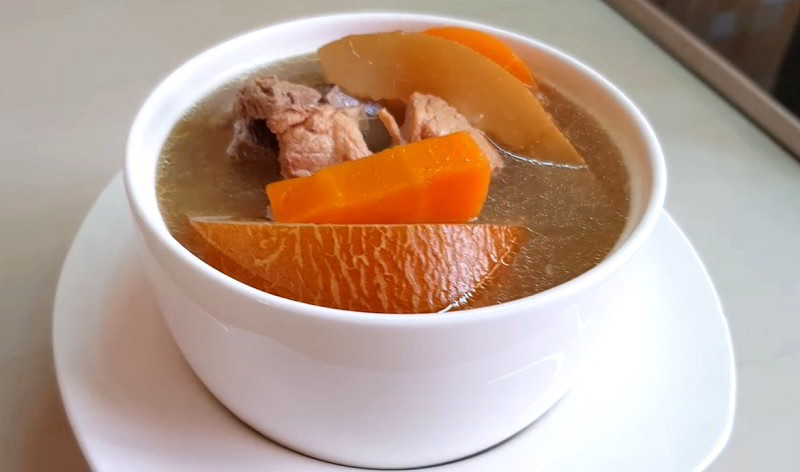
Traditional Candy and Coconut Wrap
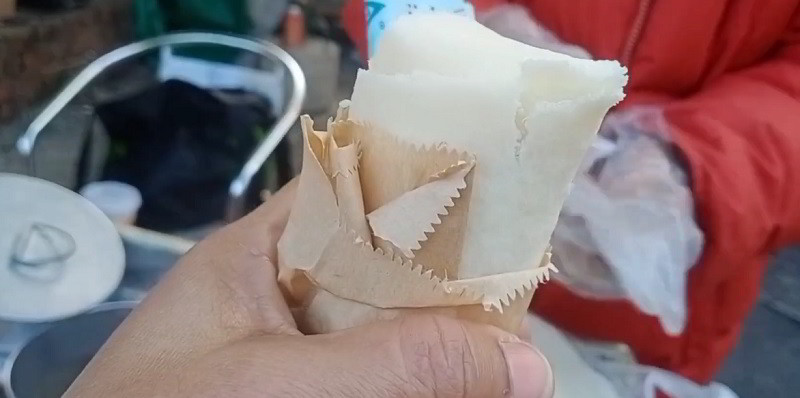
Ping on bun
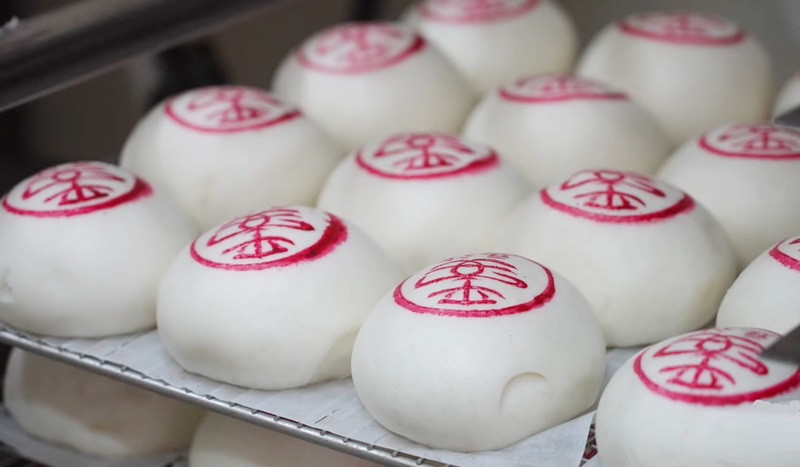
Tang bu shuai
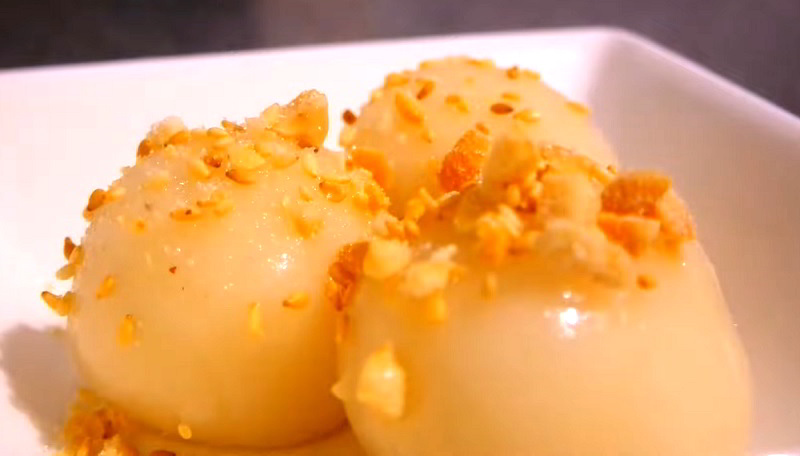
Rejuvenation of dai pai dong

Sopa de lacassá

Cha Gordo

Arroz gordo
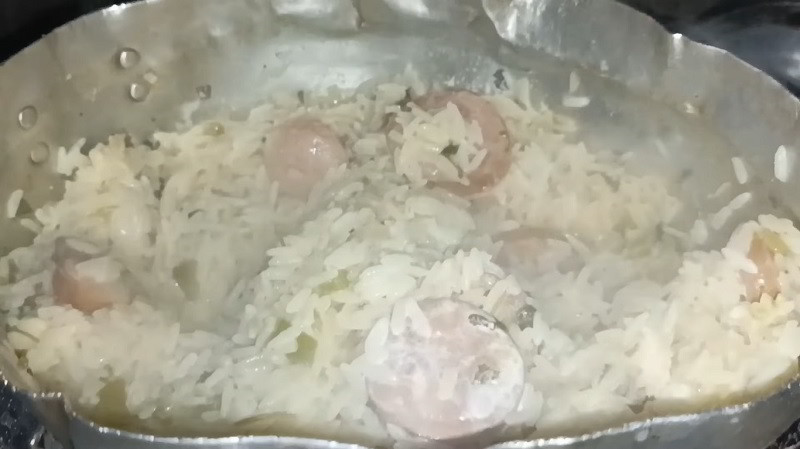
Stuffed bitter melon soup
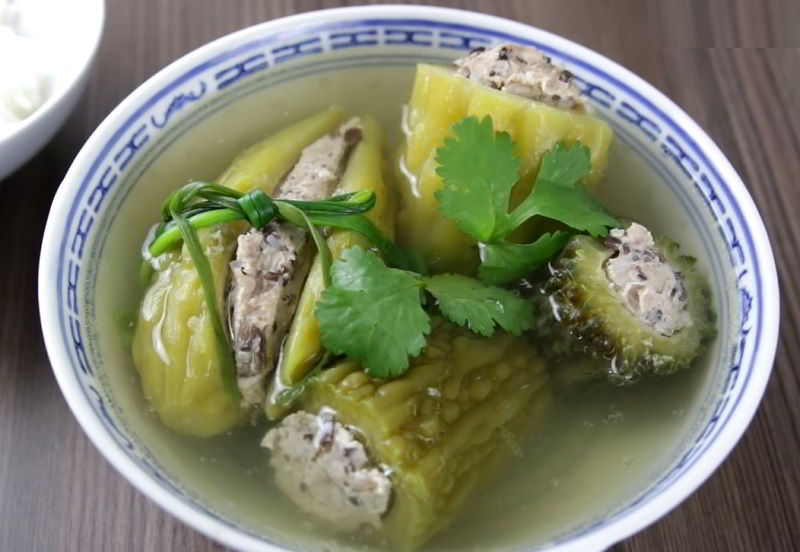
Ong choy

Dim Sum King

Chinese shortbread
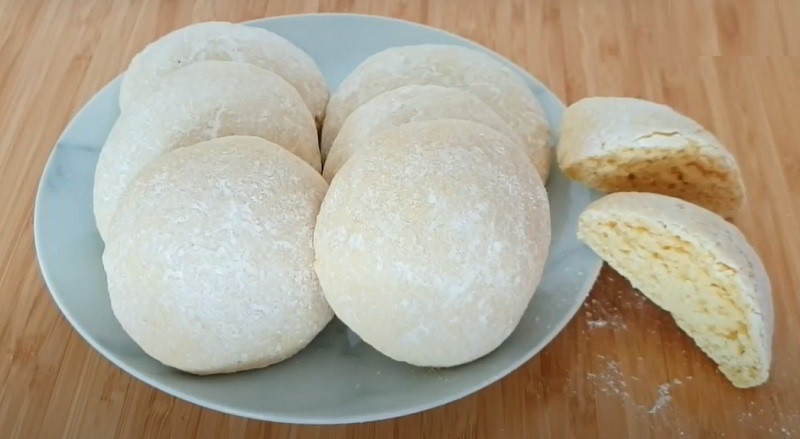
Tuna bun
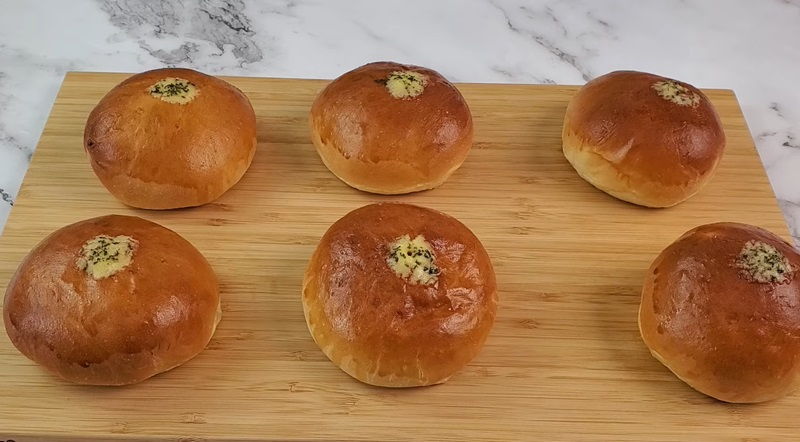
Cheung Chau fishball
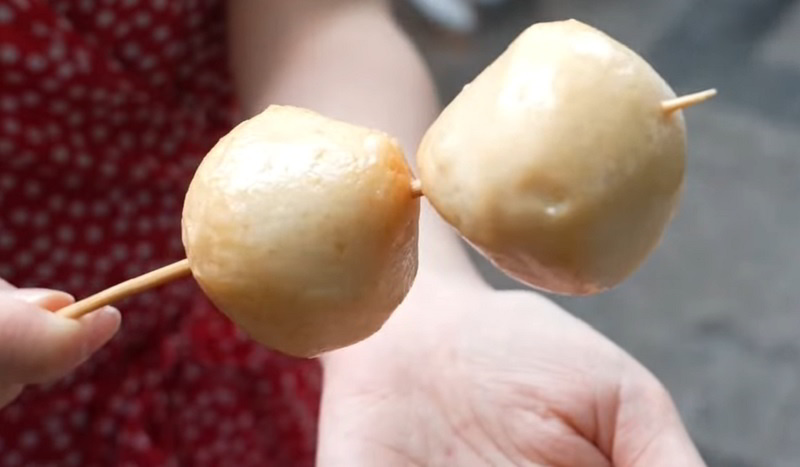
Balichão
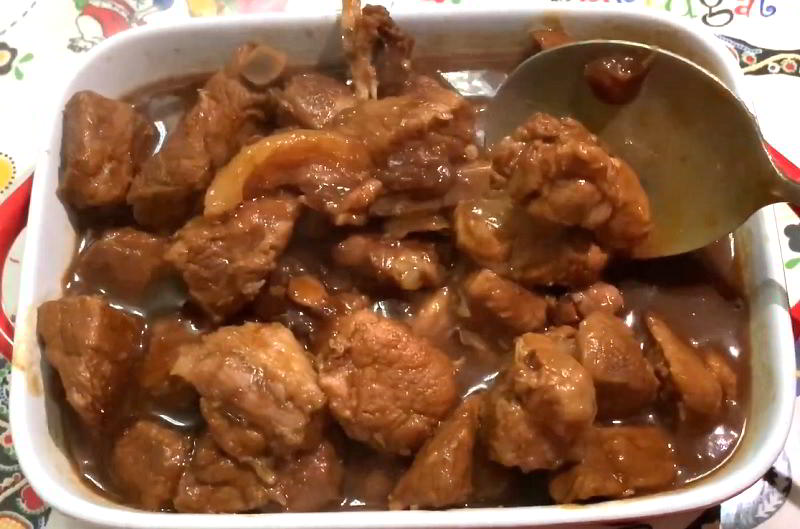
Airplane olive
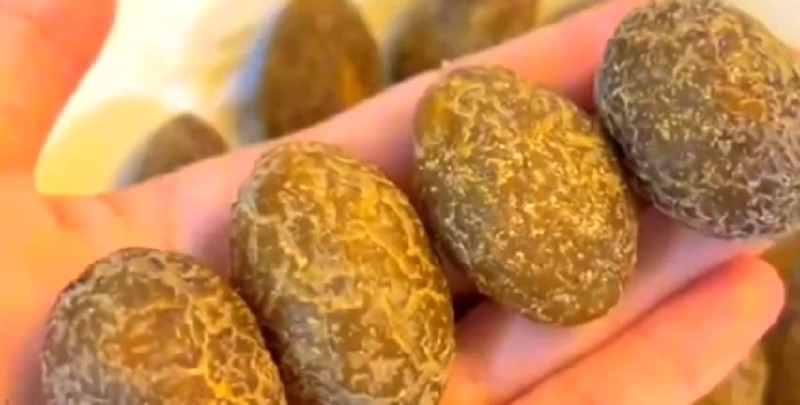
Et (Chinese pastry)
-1711964449.jpg)
Manggong cake
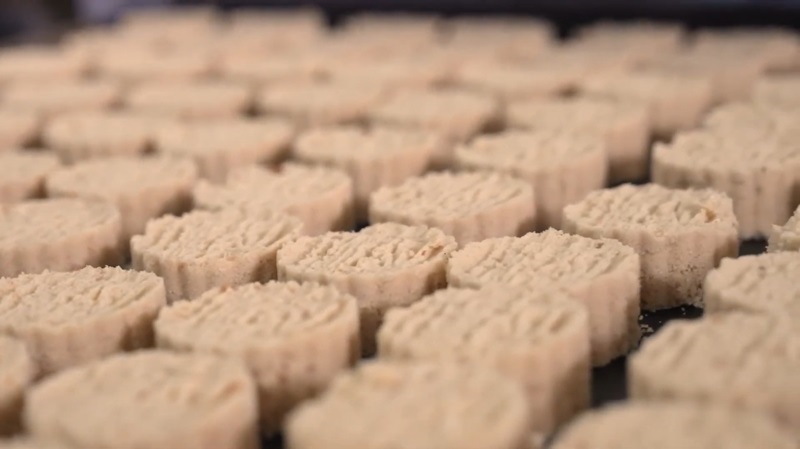
Tin Hau Food Square



